Ray's Ramblings - Volume 7
Ray Kessler is a lifelong Mt. Vernon resident who has played a lot of ball, written about others playing a lot of ball and loves to wax eloquently about Mt. Vernon. We are fortunate to have access to many of his short stories and observations to show here.
We have organized the articles by the period of time Ray is referencing. This volume started in February, 2014.
Come back often, because Ray just keeps finding items to add. This is Volume 7.
2010's
Driver's Training and Brews.....2014
Was sitting in Koodie Hoos this morning having an adult beverage and me and a gentleman /\ Editor's note: Kind of reminds me of a song "All I wanna do is have a little fun before I die," Says the man next to me out of nowhere It's apropos Of nothing He says his name's William but I'm sure, He's Bill or Billy or Mac or Buddy And he's plain ugly to me ; and back to your regular scheduled Rambling /\ started talking about history and the subject became James O. Baxter and driver's training. Mr. Baxter was the first driver's education teacher at MVHS starting around 1948. He said Baxter would show a hat pin when he sat in the passenger side of the car to the student driver and said, "If you mess up, watch out." No indication he was really serious.
Artist Humor....2014
Was talking with Lishawna Taylor today from Kokomo and I said to her. "Did you know Mr. Curtis here is an artist?" Before she could respond, Glenn brings up both his hands up and cups them and says, "I draw flies." We about fell out of our seats!
Black's Grove.....2014
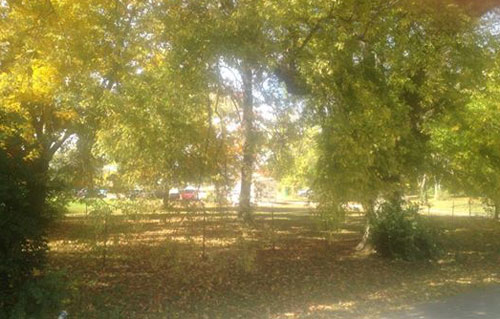
This was once known as Black's Grove...a central place for celebrations, Chautauquas, and even the starting place of a vigilante mob in 1878. Located just south of the railroad on Lower New Harmony Road.
New Park Planned for Old Fire Department Site.....2014
Was enjoying a fine breakfast this morning at the RichLind Emporium when Judy Heberer gave me a piece of paper for plans if we win one of the two Stellar grants out there. Two are available and the cities are down to five of which we are a finalist. One of the projects plan is a new park. "Upon completion of the new police and fire station, Mt. Vernon will be demolishing the old fire station located adjacent to the City Administration building. The cleared site will be made into a City park/ parking lot and will house the McFadin's Bluff historical markers regarding the history of Mt. Vernon." The new park will be located along the new River Bend Trail and across the street from the Alexandrian Public Library and Imagination Station, two additional stopping points that will be part of the trail.
Riverfront Community Complex Plans Are In the Works......
Part of the Stellar grant wish list is a new indoor community complex. Now that would be super! Already with the new park and amphitheater we have the River Days, concerts, movies, etc. and a new community complex would be wonderful. They want this facility to provide a crucial need for rest rooms, additional parking and for additional programs indoors. My notes say that "the site control for building is under option and preliminary plans are complete with a budget in progress and local funds committed." I also have noticed down at the Riverbend Park a new building under construction.
River Bend Courtyard Hoped For.....
The city would like to make the court house lawn at Main and 4th Streets a trail stopping point along the proposed River Bend Trail. This is to provide a stop to highlight historical monuments and adjacent buildings located nearby. I think that would be a good place to maybe show the history of the Coliseum, Post Office, and maybe something about the old interurban railroad that once went down 4th Street.
Elks Club Pictures....April, 2014

My Biased History....What I Think About "Fair & Balanced."
Long ago at the new age of an automobile you might drive into a dark little village with a name on a sign..."Dogpatch" and under it might be, "Hub of the Universe" or "City of Champions" or "Birthplace of Huckleberry Finn." Back then we didn't go very far from home usually, so we saw the ways of the world through our own night sky. Right here in "River City" we saw the sun rise and set. We went about our business with our neighbors the Maurer blacksmith, the Thomas wharf, the Dietz grocery and the Templeton gunsmith. We took it for granted that the coming decade would be better with more progress. We gave no worry to the future of mankind, or global warming, or depletion of natural resources. Our news was the newspaper man and the eloquent clergyman. "Eternal sunshine awaits us!" Historians look back with preconceived notions, some bias, and not so much objectivity. You could put in front of me every federal census since 1790, but if I had no bias where would I start? What would I be looking for? I scour newspapers, church records at times, old books, get in an old house and try to prove or disprove what I believe. I want to know if the abolitionist sentiment were stronger or weaker than my conception of it. I'm not totally a fool....I am willing to modify my assumptions from time to time as discoveries dictate. I recognize the racism of the Democratic party of the mid-19th century and I examine the leaders here. Owen for example was a Democrat but was progressive and broke from the slavery patterns of his own party. It is likely that any two of us could soon unearth something of value and we would differ on the meanings. That is history and why many books are written each year on the past that is hundreds of years old. Things that were important to one generation become sometimes trivial in the next. I guess that is why new good histories have to be rewritten every generation or two. We are still a young country compared to the old world. I believe that the individual human being is priceless of immeasurable importance. I also know that there has to be a fine line of what is right and what is wrong. We seem to have a fear of novelty with our demands of conformity, but as long as we don't hurt others I have no problem with being an individual. But we are not isolated anymore and we should expect goodwill throughout the land for every individual of goodwill. So Mt. Vernon and USA, let's see how many free and creative individuals we can accommodate within our borders and look beyond our differences.
Wavy, the muffin man...
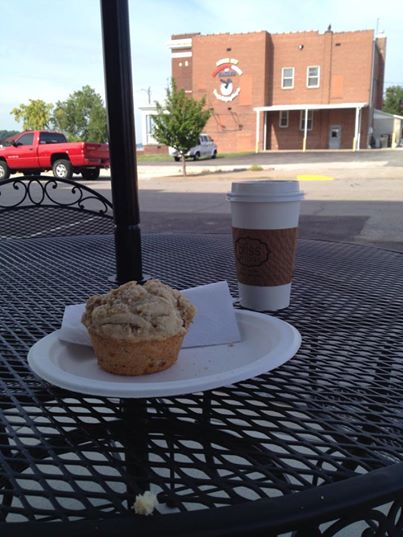
Enjoying my first wonderful Banana Nut muffin and Breakfast Blend coffee at Bliss Artisan. Retirement is like nothing I've known before! I should have taken better care of myself to stretch this out longer!
Good as New - W. H. Fogas - Druggist - Mt. Vernon, Indiana.....2014
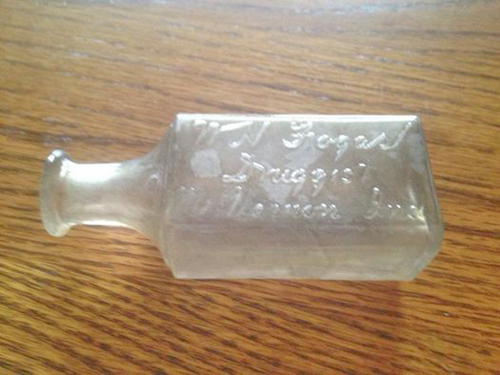
A century old bottle embossed W. H. Fogas...Druggist...Mt. Vernon, Indiana. Found by Rick Word and donated to Posey County Historical Society. William Henry Fogas graduated from MVHS in 1878 and graduated from pharmacy school in St. Louis in 1884. He worked for Joseph Gardiner, druggist in Mt. Vernon. In 1884 he started his business on the corner of Second and Main until he died in 1929. His daughter took over then until she sold the pharmacy to Thorton and Wheaton.
Mann Site Artifact 100-500 A. D.....2014
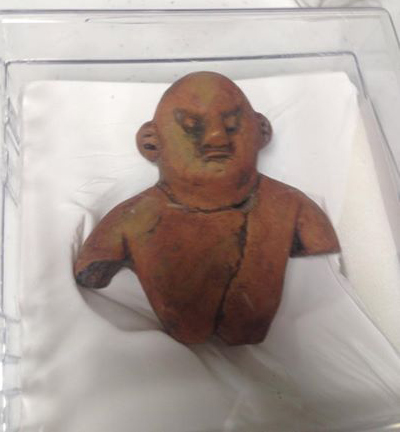
Located off Indian Mound Road east of Mt. Vernon contains many mounds of an ancient culture that was present from Michigan to Florida. Mounds as high as 35 feet are there that once had a population estimated to maybe 150 people. Evidence shows trading between this site and one in Georgia called Swift Creek. Many artifacts are in the Field Museum in Chicago. The figurines are thought to be some sort of self-portraits (Editor Note: The original Selfies) are others in the group. Some had head dresses that were detachable.
Here is the winner of the MV Bicentennial logo.....March, 2014
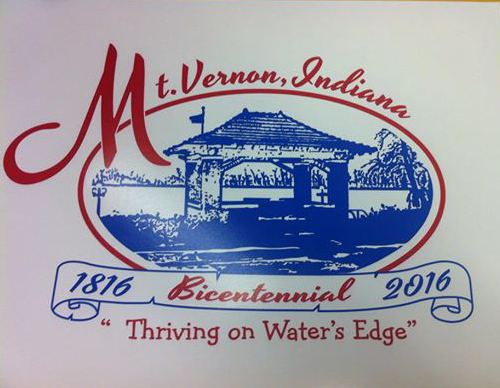
Bob Bulla is the artist. The slogan on the bottom will be changed to "thriving on the river's edge". The main reason this was pick was because they thought the pagoda represented our town the best. The courthouse is County not Mount Vernon. Thanks to everyone who submitted art work. It was a tough choice photo and slogan. Been quite a bit of good news the past two years and today's Democrat was full of good stories like Valero buying Aventine and reopening, the city pushing for a western bypass and Mt. Vernon a finalist for the $12 million Steller grant. If that comes through and the fertilizer plant construction moves ahead, police and fire station, etc.... We could be coming back!
The old Dawson Store in Solitude

From Doug McFadden: Mark Dawson was an institution. His store was Solitude. What ever you ask to buy, Mark would find it somewhere in the store. At the back was the potbelly stove with a couple of benches. The three French brothers would alternate between the store at Savah and Dawsons. It was a place where tall tales were told. Mark also had a peddler wagon which he drove through the countryside selling items and buying chickens and eggs.
Can't Research Today....As the "Mouse Man" Cometh....
Staying around the house today as TJ made an appointment with the pest control man...I don't think we have a problem, but it's the annual inspection. I hate inspections....reminds me of basic training. Be that aside, (don't think I ever wrote that before), ~Wavy~ gets a kick out of watching the man in the funny uniform with his head light and a pin light going around searching for mud dabbers and spider webs and creepy crawlers dens. He pulls back ceiling tiles and insulation looking for that termite, that mouse dropping or any evidence of critters. Wife don't like critters...not at all! She sees a spider and screams..."Ray!" ~Wavy~ comes a running (or close as I can) and I grab a Styrofoam cup and a dust broom and go to work. "Don't catch it!" she yells..."Kill it!, Kill it!!!" Sometimes she has enough too of my pacifist ways. She did okay when I was a vegetarian for seven years, and didn't call me a hypocrite when I broke my fast and ate jerk chicken; but she holds the line on insects and vermin. Not wanting to put me through another moral crisis she got this extermination guy who looks like Himmler to do the dirty work for us blasting the corners of the garage with chemicals and putting down those cruel glue traps. Next it will be the lawn care people. They have already called....wife hates those people. All purchases on this have to go through her. She thinks she is the expert on when to spray for weeds, put down nitrogen and fertilizer.....I don't like to argue too much with her....she's too cute!
Some of limestone blocks of the 1878 jail now at Riverbend Park.....2014
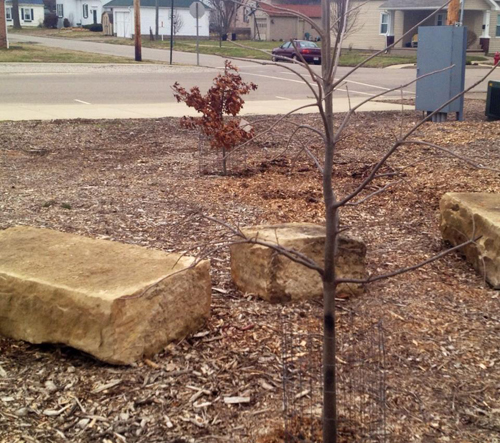
Mayor Jackson Higgins Married 54 Couples in 32 Years In Office....I'll Tell You About Three.......2014
Jack Higgins was telling me stories of marriages he performed as the Mayor of Mt. Vernon. Three stood out. The first one was on Christmas Eve and took place at the Peerless Tavern on Second and Main. Jack walks in and the place is packed and loud! Jack first gets all the signatures for the witnesses so he will not have to try and find them later. Next owner Steve Loehr unplugs the juke box and total silence fills the room for maybe the first time ever. Blah, blah, blah..."kiss the bride"...plug in the juke box and Party at the Peerless! The second marriage is two boat club members who wanted to be married in the Ohio River. Jack said he couldn't do it because his jurisdiction ended on land. So they tied the boat up to the land and Jack stood in the rocking boat and married the two love birds. The third actually didn't happen. Higgins has just got out of a meeting at the city hall and a woman with an accent came up and wanted to get married that night. Jack saw the paperwork and agreed. The women called her perspective groom to meet her. What followed was three men came, the groom and the two witnesses. Jack said which one of you is George the groom? None answered. The prospective bride said, "George backed out. Tom is going to take his place. Just mark out George and change it to Tom." Mayor Higgins said, "I can't do that....go to the courthouse and get the proper paperwork and I will be glad to marry you then." Turns out the bride was from Germany and she needed a husband pronto to stay in the country. Oh, Oh I forgot one....It was a hot July day and a marriage was to be performed at Sherburne Park in the bandstand. They had a three-tiered cake and Jack realized it wasn't going to make it much longer. It was already leaning like the tower of Pisa. So Jack flew through the ceremony so the cake could be saved. By the way, the Mayor never charged for the ceremonies, but hoped they would remember him on Election Day.....8 terms!
Antique Police Equipment at Police Station....2013
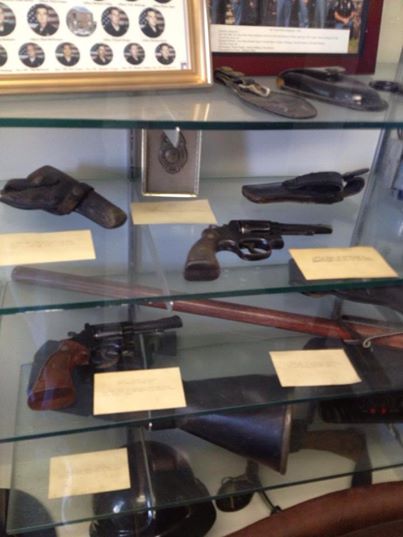
2000's
1990's
140 Year Old Tombstones Found Near Old Camp Pahoka.....Around 1999
The following is a story from Ilse Horacek, Mt. Vernon historian and Darlene McConnell likewise. Where New Harmony State Park is was property homesteaded by the Thomas, Alexander, Phillips families in pioneer days. Elsie discribed it as "wild and wooly territory full of hills and gullies, and thick with brush and trees." It was in this vicinity that during the 1930's, hundreds of acres were designated by the State as Boy Scout Camp Pahoka. When the state decided to make the park near New Harmony they forced farmers and those living there to sell several thousands of acres. These people were not really all that happy with the deal they were handed, especially since those who once lived in the Pahoka camp were forced out and the camp was later abandoned. One old lady refused to sell and was not shy to tell others to stay off her property. They said she had the original "sheep skin" deed to the land of her ancestors and the state backed off for a while. "Finally they offered her Camp Pohoka as a trade and her and her daughter's family moved. The lady was very old, yet she roamed the hills of her new home, always with her gun in her hand, and she had better never find a hunter or trespasser, or those littering." One summer she came upon a piece of concrete lying under brush and scratching the dirt off she read the name Phillips on it and knew she had found a tombstone. She then called the Recorder's office to find out who had lived there in the past and owned the land. Her daughter was able to find out that a Phillips had owned the land in the 1830's. That is when the lady was told to contact Ilse and Darlene. A time was agreed on and the two ladies drove out there. Else had an unusual feeling going out that they would find something that linked to her husband's family history. She told Darlene that James and Mary Eblin Thomas, daughter Nancy, had married a James Phillips and that his grave had never been found anywhere. They brought along tools of a spade, a shovel, and a rod to prod into the ground. Meeting the two women, Ilse and Darlene climbed a steep grade off the old road before coming to the slab that was found under leaves and brush. After some digging they cleared the stone and read: Phillips, "James, died April 2, 1842 in the 40th year of life." That was indeed the husband of Nancy Thomas. They walked around and Else said her feet began to tingle like they were on fire. She KNEW somehow that there was something else. Pushing a rod into the soil she struck something like a rock about nine inches in. They started to dig. "It was extremely difficult, thick roots were everywhere. Had it not been for the old lady who had a saw with her, they would not have got through." They could not raise the stone, but they could plainly see. "Nancy, wife of James, died November 25, 1859 59 years, 8 months and 14 days." They were elated and Else felt there had to be more Thomas' out there, relatives of her husband that came from Tennessee as early as 1814.
Herman Roach Umpire.....1993
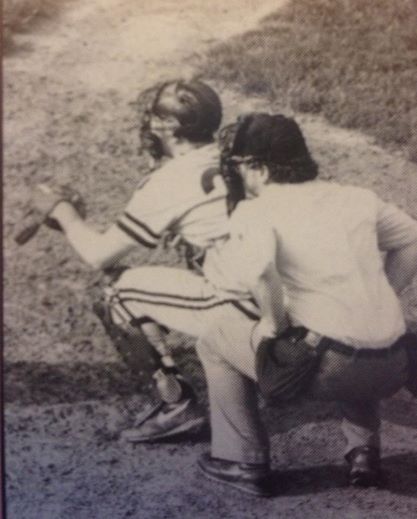
Herman Roach was in my class in 1967. He umpired many a game at the high school.
L&N Depot...1991
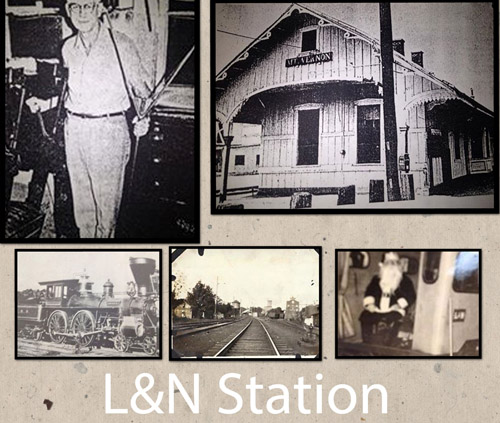
The old building was made up of five rooms, once contained a ladies rest room and waiting area on the east end which later became the signal maintainer's office, the office for the agent, operator and clerk, a men's waiting room and then an office for the Railway Express and a large storage room. Men and women used to enter the depot and purchase tickets from separate windows. There used to be a large freight house on the west end of the building that was full all the time. Carloads from Evansville would come in selling wholesale and four or five workers would haul merchandise downtown to our various stores. Loading cattle was common place and refrigerated meat would arrive each week here. Keck-Gonnerman would load threshing machines on the loading platform. When the circus would come in, it proved to be a popular attraction as large groups would watch the unloading of animals. Santa would arrive by rail for the parade; people would go to Cardinal baseball games from here or to Chicago. The depot would be kept busy by our flour mills and coal would be unloaded here. A large water tower once stood just west of the station for the locomotives to take on water in the days of steam. Alvin is shown with a semaphore, a signaling device with his right hand and holds a pole and string in his left hand that was used to deliver messages to passing trains. The semaphore was an oddity, a large iron machine with two handles, one for southbound trains and one for northbound. Each handle could be placed in three positions. Pushed all the way forward, the handle signals red outside the station on a tall light post. In the middle slot it signaled yellow, caution, and in the left it was green. A hook and pole was used for passing messages. A long pole with a fork on the end holds a string with a message on paper tied in the middle. As the train passes by a man reaches out and grabs the string from the pole and the message is delivered. "Speedy delivery." Roscoe Bayer worked for L&N starting as a clerk in 1917. A old record book at the depot dated 1906 shows that a clerk started at $25 a month, an operator at $55 a month and a station agent at $90 a month. Bayer made $37.50 a month in 1917. Daws said he began as an operator making 87 cents an hour. All these little artifacts are now gone due to a fire. Lost is the old caboose stove and even an original lantern on the wall, once used to signal trains with a red globe if the train was supposed to stop, blue if men were working and a white and green combination if the station had a passenger to board. So is the old ledger, and semaphore.....but memories remain and drawings of the old structure still are present and stories are preserved from troops going off and returning from war to circus parades. The first railroad through Mt. Vernon was 1870. Black's Grove was part of the railroad lore of the time too. It was a place for political speakers who stopped by train to deliver their messages. President Truman's train stopped just east of the depot in 1948. I have read stories of dinners given on the lawn of the Elks for soldiers heading off to the First World War then marched in a parade to the depot and given flowers as they boarded the train. There once was a bar on that little island that has been the scene of many restaurant offerings. People would go there to have a drink when waiting on a train. Buggies would pull up to take passengers to the downtown hotels and take them back at train departures.
1980's
Posey County Court House On National Register.....April 1989
After 113 years our beautiful edifice made its way to the Hall of Fame or the National Register of Historic Places. The honor started back in 1986 when Wanda Griess of the Posey County Historical Society sent information to the Indiana Department of Natural Resources division of historic preservation and archaeology. As historic a building that it is, it was still difficult to get the prestigious award. Only one office looks over the claims and many are nominated. After making the cut, it then went to the State Protection Review Board on Historic Preservation. After that it went to Washington to the national register there. It was here that the merits of the building were found warranted and it was approved. Patrick Ralston, director of the Department of Natural Resources said "the courthouse is among the finest Italianate style court houses in the state and is the best surviving work of Indiana architect Vrydaugh." The National Register is administered by the U.S. Department of the Interior and is the official list of cultural resources worthy of preservation. At the time it was the 13th property in Posey County on the list.
You don't see this everyday in Mt. Vernon!....March 7, 1989
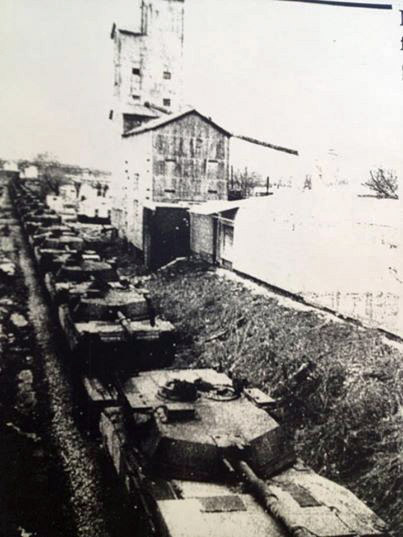
Art Roos Looks Back to Nazi Prison Camp in 1989
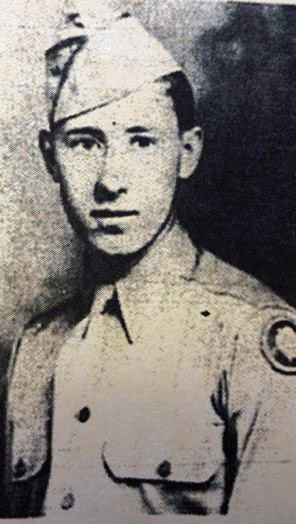
Arthur K. Roos was 19 years old when he was captured by the Germans at the Battle of the Bulge on December 19, 1944. He remained a prisoner until an American tank crashed through the camp's gates on Easter Sunday, 1945. He was taken along with others to a field hospital and then to a general hospital. Six weeks later he came home for a visit, but didn't stay long. He ended in Washington State guarding six German prisoners of war. When captured he was sent by rail to the camp and arrived on Christmas Eve. It was six days before he had anything to eat. Usually he was fed one bowl of soup a day and maybe some dark bread filled with sawdust in the evening. His barracks had bunks three high and no heat. They had no soap to bathe with at all. His times were filled with playing cards, exercise and any mind games that would free him from his horrible plight. His service was over on Thanksgiving Day 1945. He later moved to Missouri.
Neil Curtis scores in "Turn Back the Clock" Posey County Tourney.....1989
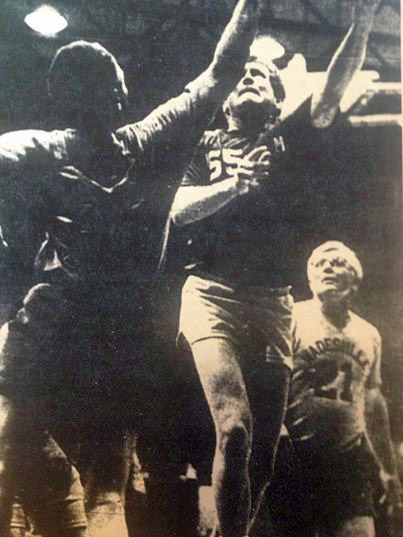
Mt. Vernon won all three games of a throwback to an earlier era when the Posey County Tourney was the bragging rights of Posey County from 1922-1959. Six schools, our Wildcats, Poseyville Posies, New Harmony Rappities, Wadesville Red Devils, Griffin Tornadoes, and the Cynthiana Annas competed. I sat up in the bleachers as Sam Gander, Chummy Jeffries, Curtis and Gerry Allyn got ready. Sammy had his letter jacket on and his Converse All-Stars shoes tied in a knot and thrown over his shoulder. We were gonna play New Harmony. Sammy says, "Let's beat these guys, I never liked them then and I don't like them now!" I saw Charlie Lawrence and Darwin Rueger from the 40's playing and Mike Stewart was still a physical specimen. Charlie Brauser, rushed the ball up the court with grace and speed....what a competitor! Mt. Vernon downed Wadesville in the Championship game 32-26. They did this for three years I believe playing in the gyms of Mt. Vernon, North Posey and New Harmony. Mt. Vernon won all three years, but it was fun to watch. Old Ed Shutz of New Harmony took three set shots from about 35 feet and the crowd went wild. He hit the third one and brought the house down. Then his teammates wouldn't give him the ball again. Good crowds, and the older cheerleaders cheered on the teams. I was still checking them out. I got a good eye!
"The Beast" Shows Up at Revival Tent.....Late 1980's
~Wavy got stopped at the bank today and told a story. The fellow said he had a crazy old uncle who was sort of a redneck and he had a cougar as a pet. It was de-fanged or something, but he was still menacing. He had this large collar with an eye bolt holding it together and he would tie him onto the back of his pickup and drive him through town giving the cat exercise. One day going down East Third Street the cat slipped out of the collar and ran up and down the revival tent and dozens of people scrambled out of their chairs escaping what they thought might be 666.
$74 Million GE Expansion Announced.....1985
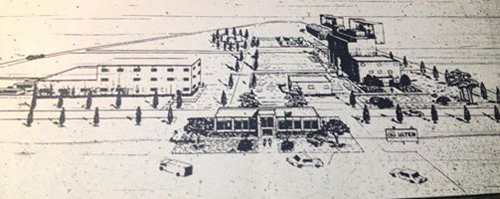
For the first time GE moves across Indiana 69 to the west in an expansion resulting in a 25 acre operation to produce Ultem. Ten permanent jobs to be added in 1986 and another 10 to 15 in 1987. The new facility will add monomer polymer and finishing capacity for the Ultem polytherimide resin product line. GE General Manager of the section said, "strong sales in electrical/electronic computer and business equipment medical, and aircraft markets were decisive factors in the move to add capacity." GE now employs over 1300 people in Mt. Vernon. This comes on the heels of a 1984 expansion of $110 million in the Valox production line which added 50 jobs. GE executives also told community leaders of their desire to close the section of Indiana 69 running through GE property. Negotiations have begun with state officials to have part of the highway rerouted.
Eleven New Channels Added to Horizon Cable Viewers.....1985
1700 households in the Mt. Vernon area rejoiced in new channels to their basic cable packages plus 3 premium channels and a pay per view channel. The seven new channels were CNN, CNN Headline News, MTV, Lifetime, C Span, Nashville, and Christian Broadcasting Network. The premium satellite services were HBO, Cinemax, and the Disney Channel. Then there was the pay per view programming that you paid on an individual basis.
Bobby Knight Pokes Fun of Poseyville.....1980's
Sometime in the 1980's according to Stan Levco, former Vanderburgh County Prosecutor, and author, Indiana University basketball coach spoke at the Executive Inn in a fund raiser for the Boy Scouts. A question from the audience came up about the charges awaiting him from an incident during the 1979 Pan American games in Puerto Rico. "Coach, any chance you will be returning to Puerto Rico anytime soon?" Knight got up and said, "I've taken several trips to tropical islands and I'd rather spend three days in Poseyville than another day in Puerto Rico." Don't fret....Madonna called Evansville "Prague" when she came here to make the movie, "A League of their Own."
Christmas Parade 1983
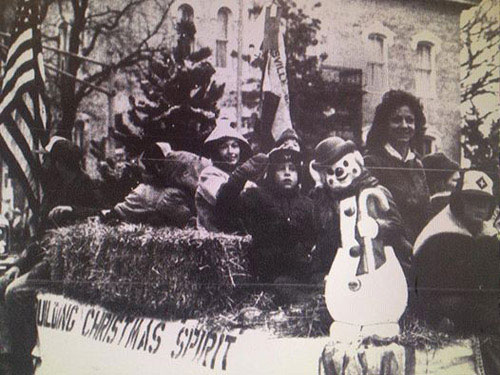
The "Golden Years" by my Aunt Nelia (Huff) Frashier.....1983
In October of 1983, my then 72 year old aunt wrote: "This is the season where nature prepares for a long rest. It is a beautiful time of the year, the leaves change colors, the apples red and yellow, the green and purple grapes on the vines and the pumpkins make a pretty sight to behold. The fields are getting bare now, since the farmers are harvesting the corn and beans. Squirrels in my yard are gathering nuts for winter and many ants and ladybugs lay in food for the cold days ahead. Our cat's coats are becoming heavier. Autumn has caught up with me too. The golden years they call them and they are in many ways, for we have learned much from study and experience and from reading the Bible. The Bible says. "The days of our years are three score years and ten; and if any reason of strength, they be four score years, yet is their strength labour and sorrow, for it is soon cut off and we fly away." As most of us have come to the autumn of our lives, let us live each day, and enjoy it, for truly life is a gift from God. For me I have had a good life, my parents, brothers, sisters, grandpa Emery and two aunts. I have a great husband that is so good to me and I have enjoyed my nieces and nephews (me) and their children. Our Christmas day is wonderful and I can think back to the days when we didn't have much but we were still happy and thankful for living in this community with good friends near church. I have enjoyed my calling working with the children, teaching Sunday School and thank God for his goodness to me. Thank you for all my wonderful brothers and sisters, the church and most of all....the Lord."
Bob York - Fireman Retired.....1989
In January of 1989, Bob York retired from the Mt. Vernon Fire Department after 24 years on the force. The two fires that stood out in his career were the one at Texaco in the early 1970's with its "wall of fire" and the explosion at the Mt. Vernon Barge Service which claimed a life. Bob served as assistant Fire Chief from 1972-1985. His injuries were few...a couple of times with stitches and treated for smoke inhalation once or twice. He is a religious man that I still see taking his daily walks about town with a friendly wave to drivers. Thanks for your service to the community.
1970's
Hovey Lake Archaeological Site.....1979
According to an Indiana Historical Society report of that time it appeared that Hovey was destroyed by fire and abandoned which contributed to the preservation of many cultural items. Some of these were charred house timbers, and items within the houses. During the spring of 1979, a combination of ground moisture and cultivation produced conditions that showed dark stains on the surface of the ground marking the location of about sixty houses and permitted some mapping. Aerial photographs and probable cemetery areas resulted in a site map. Excavations found massive amounts of cultural debris and remnants of rectangular houses associated with hearth and storage areas.
First Residents of the Southwind Plaza have Grand Opening.....January 1978
Tenants for the new opening were Union Federal Savings and Loan, Wesselman's Supermarket, Wesselman's Coffee Shop, Index Notions, P.N. Hirsch, The Lily Pad, Center for Hair Today, Coast to Coast Hardware and Radio Shack. Soon after came Revco Drugs.
USA Bicentennial Celebrated Locally .....1976
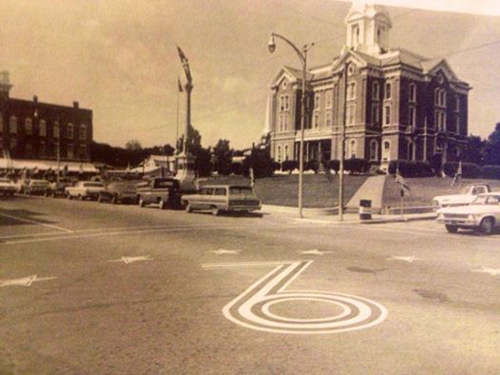
Remember fire plugs painted to look like Minutemen? We had a worship service at Sherburne Park on religious freedom and the American Revolution. In New Harmony, Harold Witherspoon, a direct descendent of Dr. John Witherspoon, who signed the Declaration of Independence, delivered his ancestor's sermon on Independence. In Mt. Vernon the Lions Club had a big cookout at the riverfront. Posey County Circuit Judge Steve Bach addressed a crowd on the courthouse lawn speaking of the liberties Americans enjoy and mentioned a few great Patriots from our own county. A plaque was unveiled to recognize William Robb, Thomas Mills and John Smith county commissioners when the courthouse was constructed. After the ceremonies, the courthouse was opened for guided tours conducted by the Posey County Bar Association, the Posey County Historical Society, American Business Women's Association and Tri-Kappa. Homemade ice cream was sold on the courthouse lawn by the First Methodist Church and there was a DeMolay concession stand. The American Legion had a old flag burning ceremony in the evening. Many visited Evansville for the fireworks. Councilwomen Becky Higgins informed me that horses in the parade paused at the painted street of stars and would not continue until blinders were put on them, thinking they were holes in the pavement.
USA Bicentennial Celebration in Mt. Vernon Draws Unexpected Source...1976
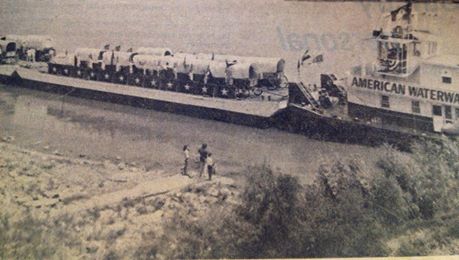
Two 115 foot barges stopped in Mt. Vernon carried 27 covered wagons including prairie schooners, Conestogas and chuck wagons. The wagons were made in Arkansas but owned by the state of Pennsylvania and each wagon represented a state. Mt. Vernon people lined the riverfront in lawn chairs to see the wagons that May as they headed for Valley Forge on July 4th. After arriving in Pittsburgh, all the wagons were off loaded and made the last 300 miles over land.
UFO Encounter.....October 1974
A witness and six other people claim they were driving back to Mt. Vernon late at night and they all spotted a large object hovering close to the ground. They claimed that the object moved over their car and gave off heat; so much so that the principal witness said all the other six became ill and passed out. He on the other hand, was transported upwards only to awake looking at a bright white light and five foot aliens with light skin and almond eyes speaking to him. He passed out again and was returned to his car. On the same night Oscar Jordan of Evansville claimed he had a close encounter.
Hee Haws Archie Campbell at Posey County 4 H Fair....1974
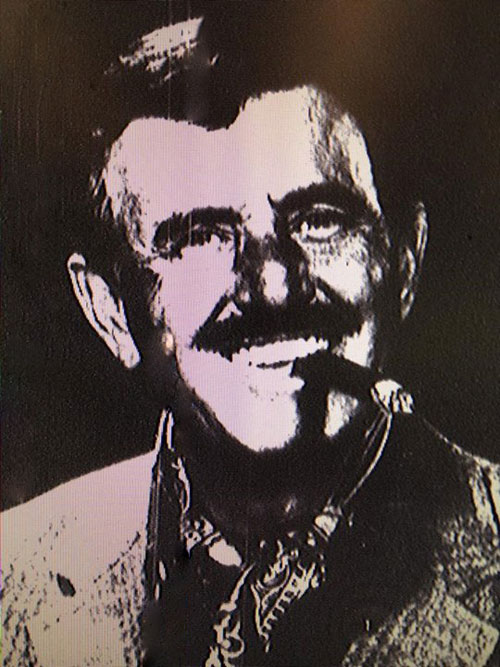
Delta Queen Sails Past the Waterworks.....June 1974
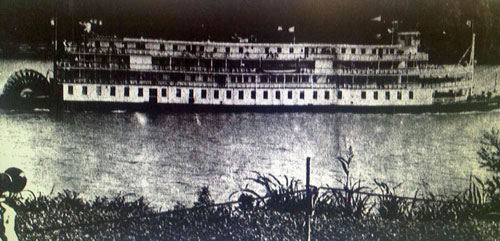
"Danger Will Robinson Danger!"....1974
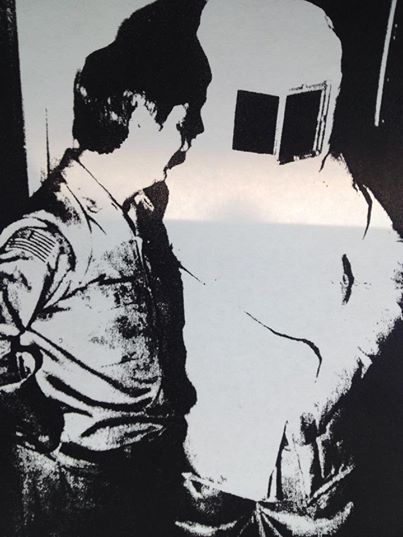
Robert Weir, Mt. Vernon fireman appeared at City Council meeting in the fire department's new flame resistant suits. Robert York looks on.
%@!#ing Potholes!....1974
It's that time of year for chuckholes or potholes to pop up or I guess they pop down. Some are big like geological cenotes. Wonder how they got the name pot holes? I did read where someone once planted some flowers in one to gain some attention of the media. My story today was when city councilman Bob Green telling Charlie Blakley, street commissioner, that there was a pothole in the street in front of the local post office. Bob's wife was rather small of stature, and couldn't reach the mailbox from her tiny Pinto after her wheels dropped into the hole. He asked Charlie if he could get right on it. An unidentified audience member, overhearing suggested Green buy a step ladder.
Former Resident Homesick....1970's
Thomas Underwood, a citizen who witnessed the dedication of the Soldiers and Sailors monument on the Court House lawn in 1908, looked at pictures of a "Progress Edition" of the Mt. Vernon Democrat and was filled with nostalgia. As he looked at a photo of Sherburne Park, a place he saw constructed he remembered band concerts, the joyful laughter of children at play on slides and in swings. He saw through his mind's eye the peaceful calm of a moonlight Ohio River and the farmstead lights shining over the trees on the Kentucky shore. He could see once again river packets, excursion steamers and "glittering showboats" tied up at the levee. "The shrill 9 P.M. curfew blasts of the steam whistle from the waterworks echoes across the decades. He was proud of our past and hopeful for the future.
Sectional Champs...1974
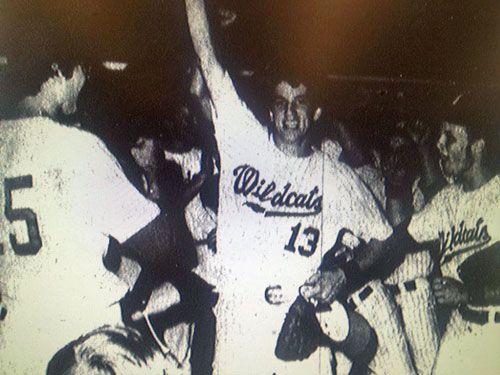
That's Chuck Groves holding the trophy, Greg Wehr is #15 and Jeff Witt is to the right. 16-13 record reaching finals of the Regional. Greg Wehr won ten games that season. Keith Rentschler was voted team MVP batting .371. Wehr had an era of 1.19 and a 10-2 record. Warren Walker had an era of 2.65, which was also excellent. I notice you lost 7 games by one run. In my senior year (67) we lost 7 straight by one run and 11 of our 13 losses! I remember Chuck Groves did some sport reporting for the Evansville Courier for a while. I gave him a few leads on some historical sports figures in the area. He followed up on a few of them. Dutch and Jeff I played quite a bit of softball for and against. Dutch was a great one. My last at bat in softball was against him and my last at bat in baseball was against him in an old timers game at Athletic Park. That was a good way to end both sports.
"And they're off! " MV Go-kart Racing.....1974
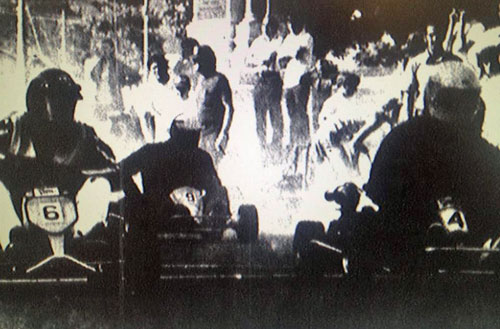
Three injuries occurred during the racing including a nine year old boy who fractured a foot and had a concussion from being hit. These were the first injuries since 1969.
UFO Seen Mt. Vernon and Point Township.....November 2, 1973...9:47 P.M.
Two warehouse men at the Mt. Vernon Milling Company said they saw a strange object in the sky about six blocks away and about 60 to 80 feet off the ground. One worker climbed up to check hopper cars, looked back and watched the orange, wedge shaped object for about 15 seconds. Seventeen minutes later, Police Chief Wilfred Clark and Officer John Tucker were in pursuit of a drunken driver in Point Township. The driver drove off the road into a ditch. Waiting on a wrecker, the officers witnessed an orange ball of light in the southwest approaching them. They showed their spotlight on it and it got brighter as it got closer. After almost two minutes, they again shined their light on it and immediately it turned away and moved out of sight. From 1970-1991 the MADAR Project was said to exist somewhere in Posey County. Anybody ever heard of it? Suppose to mean Multiple Anomaly Detection Automated Recording. The two stories I wrote are said to have come from their files.
August 1973
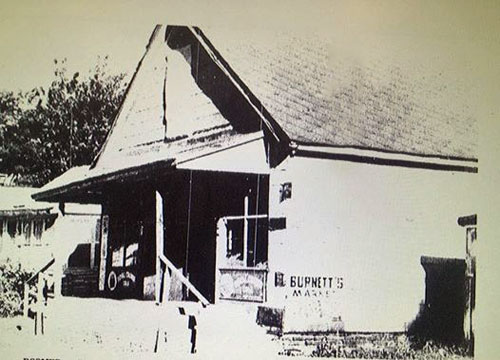
Ada Burnett's Grocery at 1011 West Third Closed After 25 Years in August 1973.
1973
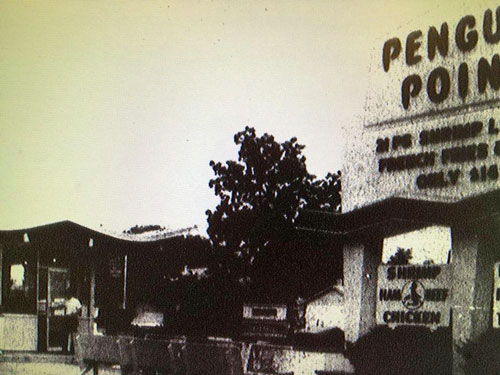
Don't see no hippies....must be early morning.
"Totties for your Bodies".....1973
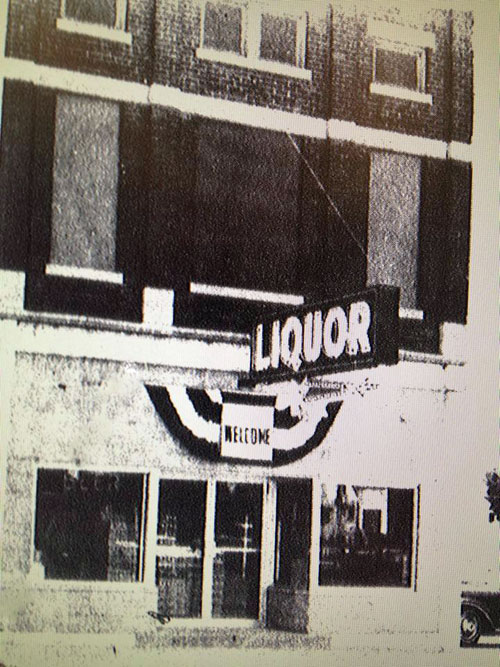
I remember some girl with the initials of T and J that I would buy liquor for who liked Tequila Sunrises in a little can. Ugh.
Little 4.....1973
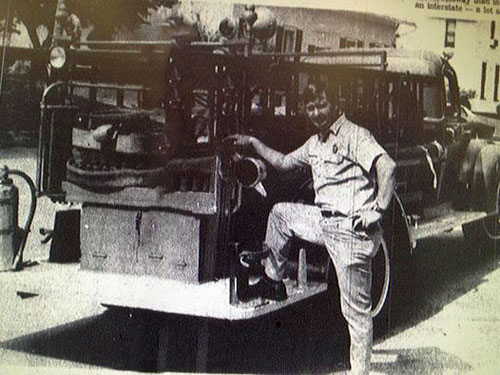
Bob York in 1973 stands by "Little 4" a truck that was at the department since 1934. The bed was on the city's original piece of motorized equipment, a 1918 Republic truck.
Bill Hall was hitting from Guadalcanal to Mt. Vernon. Here he is at age 50, 1973 in Double I Action.
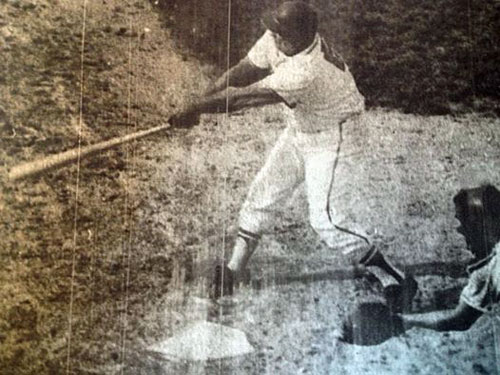
When I was a kid I learned and watched Bill Hall, feisty first baseman for the Mt. Vernon Merchants and Frank Moll Indians. He never seemed to quit hitting even when his legs gave out. His competiveness never left...even playing slow pitch softball. He was there to win! The old marine who played in Australia and other parts of the Pacific in World War II couldn't give in. He played long enough to play with a son in Double I. He played maybe five years in the Hammond and Gary Indiana area for a while, playing five days a week and hit over .400 one season. On weekends he would drive to Mt. Vernon and play more. Finally in 1955 he came to stay in Mt. Vernon. He worked manual labor during the day, but still found the energy to play at night and weekends. He was a vital part of the Mt. Vernon Double I League Championship teams of 1958 and 1959. That team was loaded with Linc Baro in right field leading the circuit in hitting at .500! Chummy Jeffries was second at .433. That team ran off eleven consecutive wins finishing at 15-2. Hall hit .396. Shirley Weiss was the catcher, Art Hall and Jeffries the middle infielders, and Ray Boerner at third. Ron Weiss was the ace of the staff going 7-0 and young Charlie Brauser was 8-2. Other strengths were Darvin Rueger, Mel Weiss, Richie Moore, Jesse "Waxy" Walker, Norman Wade, and Frankie Dickens. Hall said the greatest players he saw here were Weiss, "Dutch" Wehr and Dale Gentil. "Dutch" he said could throw it threw a wall. Once Hall thought he had played his last game in Darmstadt and threw his old spikes out onto the infield at the close of the game. The next year when they came into town, the fans gave them back knowing he couldn't quit. I have been told by many he could reach the street on Eighth Street with his powerful left handed swing in his prime. At age 27 he had a three day workout with the Philadelphia Athletics, but minor league salaries did not pay enough to raise a family. A scout said, "Too bad we didn't see you earlier."
19th Century Business Cards Found Behind Wainscot Walls.....1973
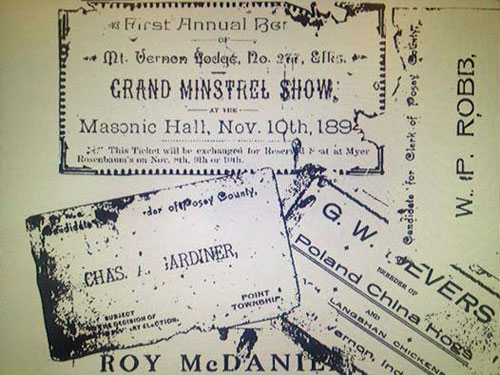
Louis Risch was surprised when an interior wall of paneling was removed from the interior of a Main Streets store on West Fourth Street. The young lady photo was an advertisment for Fritz Brothers Fine Cigars. The card for Robb was for an election in a primary to become clerk of Harmony Township. There are a couple of cards for livestock salesmen. Harley Lichtenberger was a candidate for county assessor and Devers was announcing himself as a breeder of Poland China Hogs and Black Langshan Chickens. Then there was Roy McDaniel, a painter and paper hanger. Gardiner was a candidate for recorder of Posey County from Point Township. Hempfling & Son were dealers in fresh, salt and smoked meats. Their card was interesting. On one side it had fat man saying, "I eat Hempfling and Son's Meats." On the other side was a skinny man who was saying, "I don't, but hereafter I will." A ticket announced the First Annual Beerstube of the Elks and its Minstrel Show at the Masonic Hall (now the Alles Bros.) for 1894. E.F. Bamberger became Mayor of Mt. Vernon in 1929.
"Hit 'em Where They Ain't"....31 Run Second Inning In Softball Action....1973
"Wee Willie" Keeler said that long ago when he described his secret of hitting. Well, in the summer women's softball league the Gerber's team did just that against People's Bank. I played softball for many years on some of the best teams around, but I never saw an inning like that! I do recall beating 3V or 3B Vending I believe it was something like 63-2. Poor People's had to play with eight people instead of ten and that is very difficult in slow pitch. Can you just imagine standing on the field that long getting drilled? A former classmate of mine, Dorothy Rueger led the way in the 55-0 win by going six for six and Barb Phillips was five for six. Coni Fritz was the winning pitcher. I won't mention the loser....she probably doesn't want to hear about it again.
First ever Mt. Vernon Girls to Join Indiana National Guard...1973
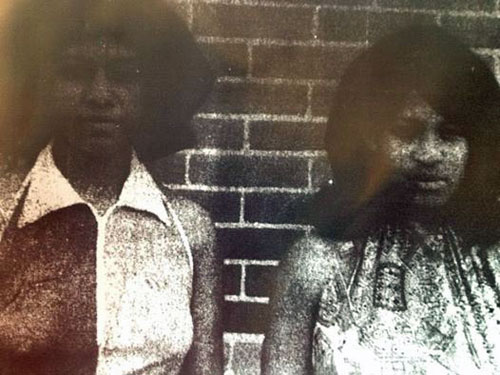
Cheryl Hobby and Sarah Hawkins
Bellefontaine Cemetery...1973

Tom's Furniture Moves To New Location.....October 1970
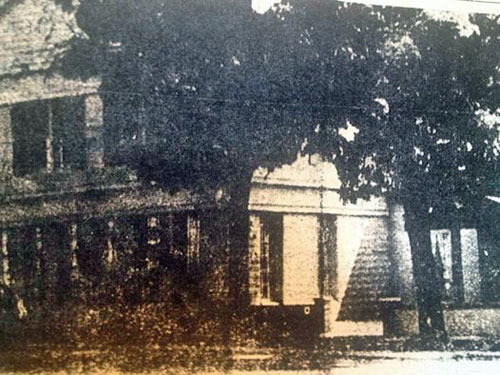
What was once at 308 Main Street moved to the southeast corner of Fourth and Mill Streets. It was once the former site of Weisinger and then Tygart Funeral Homes. Thomas Vaught, the owner will call it, "Tom's Furniture Gift Gallery." Besides displaying home furnishings in room groupings they provided a gift and oil paintings area.
Old People's Bank & Trust Gets a "Port-A-Teller"......August 1970
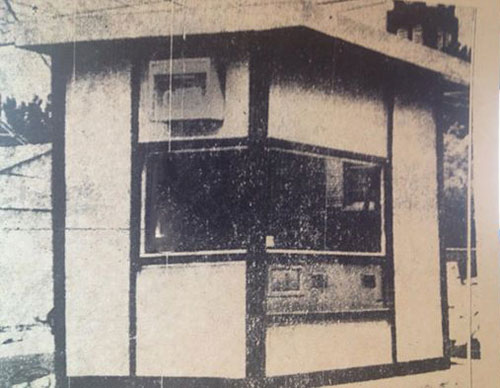
I had heard of Port-A-Potty, but this was what they called their drive-through.
Posey County Courthouse Appears in National Weekly Newspaper....August 1970
Grit....remember that? I use to be one of their paperboys. A photo of our beautiful courthouse was right there. The caption read: "Town's Attention Getters, Tourists who travel through Mt. Vernon in Southern Indiana, usually look twice at an ornate brick building in the center of the town square. It is the courthouse; its gingerbread trim is reminiscent of a slower paced age than the present. But something else commands attention too. At the edge of the walk is a slab of concrete. On it appear the Ten Commandments."
Memorial Field Opened in 1970
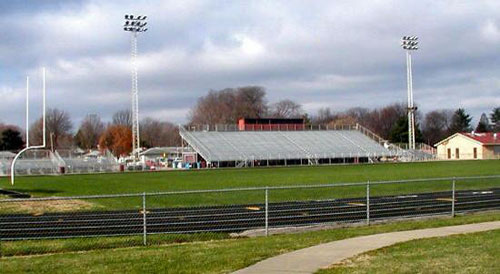
Jail Break.....1970s
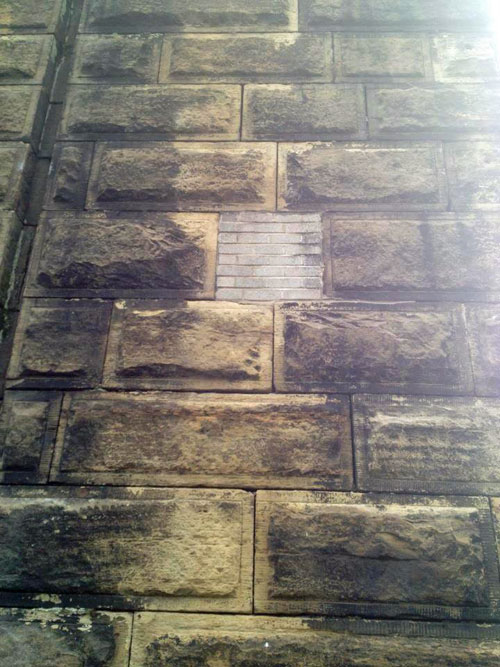
Repaired 18 inch stone pulled out of Mill Street jail in early 1970's that led to a short escape by two men. Eight other prisoners remained in the jail in spite of the opportunity to leave. The two men were from Griffin and Evansville jailed on theft of a shotgun and one on possession of drugs. The sheriff at that time was Ed Rutledge.
1960's
Penguin Point.....June 1969
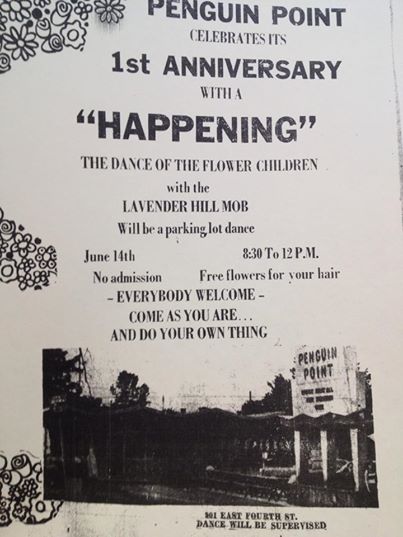
Louise Littrell & Alan Curtis at Mt. Vernon Pharmacy.....1969

The site was a drugstore for over 100 years.
Staples Foundry....1969
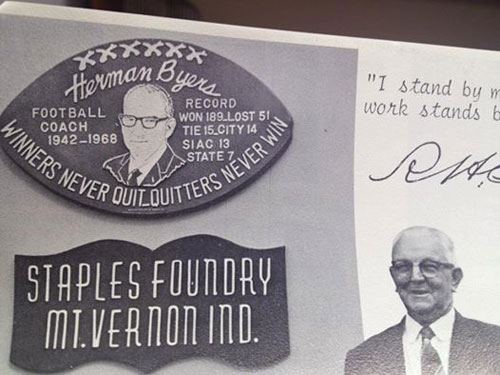
Blueprints from when Farm Bureau Moved to the A-Frame on Highway 69 N and Vista Drive....1969
My sister n law, Candi Grabert called me today and I went up to the Farm Bureau Insurance Agency on Highway 69N and Vista Drive to look at a few things they had found. All the blueprints were there of this unusual building of A frame with concrete shingles, brick siding and redwood trim. Al Noelle was then the manager of the new building in May of 1969. The agents were Richie Moore, Ralph Cooley, and George Slagle. Duane Collier was the claims adjuster and Mrs. Bonnie Allison was the secretary. My dad got his insurance here and as soon as I got home from service I started receiving my bills for my stuff right here too. Candi has been there 27 years. Gene McCoy always was my favorite. Trusted that man greatly!
Frank Parrish Becomes Flying Instructor.....1969
I have never ridden in one of those little planes even though Dwayne Daws has offered. My son Brock jumped from one in Carmi. I would never do that! Nope!! I got pretty high in 1969, but that ain't happening. He must have got his adventurous spirit from his mother. Riding roller coasters, floating down the Wabash or rapids in Tennessee. ~Wavy "he don't do dat!" Frank Parrish was a local barber in Mt. Vernon and I use to go to him before the Beatles to get a trim. He had Parrish Flying Service which is different than the James Taylor and the Original Flying Machine of about that time. When he received his instructor's license he would teach flying in his spare time taking up people like Jake Moll and Mt. Vernon Democrat reporters. He would do some aerial photography some too, which we always like seeing of our community. He started flying in 1962 as a member of the Mt. Vernon flying club and had this Cessna with dual controls with all kinds of instrument gadgets. ~Wavy don't need to be flying no plane. I would probably ditch in the Ohio River and they would be out there listening for pings from the black box. I really pray a lot when I fly....then I don't do much more until next time. I guess it would be pretty cool between throwing up to take off on a grass runway like the Red Baron an zoom, zoom, zoom around the courthouse and buzz the crowd down at the Riverbend Park. I could drop out leaflets on the people of the next rock festival or something. I like stirring people up!
Denny Allyn, Rick Fischer, and Jim Rueger Display 1968 Princeton Baseball Sectional Trophy
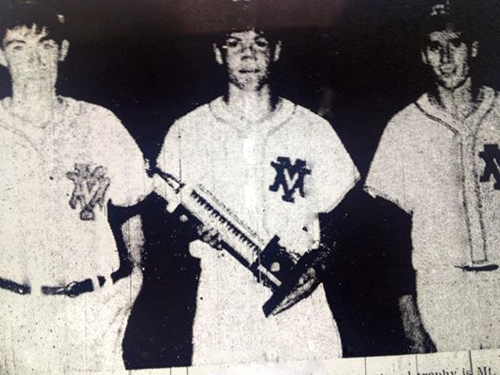
Played lots of baseball with him. For some reason I hit him pretty good in the summer leagues. He was good at everything. He hit the winning basket to win the basketball sectional that year. In 1967 in the first ever baseball sectional the Cats reached the finals nursing a one run lead in the seventh inning. Two outs, Jim pitching and he gave up a two run homer. Coach Jeffries met him on the basketball court in 68 and kidded him. "This sort of makes up for last year."
"House of Ill Fame" Raided.....1968
There used to be a trailer at 803 East Third Street and that spring an undercover man wearing a wire knocked on the door just after 1 A.M. Now according to insider information that I have acquired, from sources I cannot give, this undercover guy stuttered quite a bit when he got nervous. He made contact with the lady and a price was agreed on. He then told the city police to come in...."bettterr, ccoomme on in nooww." The cops sat back a spell laughing, knowing the man was getting more nervous by the second. They finally came and arrested two women, one age 48 from Terre Haute and one age 19 from Evansville on prostitution charges.
Editor of Mt. Vernon Democrat Comes Out for Gun Control After RFK's Murder....1968
Garth Whipple in an editorial following the death of Robert Kennedy in California found it a bit hard to understand the intensity of the opposition to gun controls. He wrote: "Apparently the worst to be said for such regulation is that there are those who believe it to be unenforceable. There are others who dismiss gun regulation efforts with the statement...'those who want to kill will find a way.' Such reasoning is often used to confuse the issue. The experience of areas where gun controls have been used is that the crime rate drops drastically. The negative argument about enforcement loses its allure when the comparison between gun regulation and prohibition is analyzed. This is a favorite subject of those in opposition to gun regulation. They say...'we tried prohibition, and everyone knows how that worked.' A gun registration law does not (per se) prohibit purchase, sale, and possession of firearms. It does seek to have ownership of guns registered. At least one of the proposals does ask prohibition of ownership by certain persons: those under 21, those convicted of a felony, mental patients, and type of weapon. One of the proposals prohibits gun shows and mail orders. The largest mail order house in the world has voluntarily moved to stop selling hand guns by mail. No member of any group opposing registration of guns feels it is an affront to register his auto, his vote, his dog for licensing or his boat. One life?" What would he say today?
Earthquake of 1968
I was at Murray State University that morning of November 9, 1968 when at 11:02 CST an earthquake centered in Illinois sent students running out of the dorm in an almost panic. It was a magnitude 5.4 and was felt in 23 states and 580,000 square miles. In Chicago chimneys fell and locally groceries fell off shelves and the large noise was heard in Mt. Vernon. It was said that in Poseyville, "fish jumped out of ponds and lakes!" This was the largest quake along the New Madrid fault since the big one of 1811. Just a few years ago, in 2008 we had another one in April in the middle of the night that roared like a freight train. After shocks hit for days. Some day.....that really big one will come again.
Dave Morris Chevrolet Grand Opening in 1967
A bag of 500 Kennedy Half Dollars was awarded as a door prize to Ida Boerner.
Mt. Vernon Defeats Highly Ranked Harrison in Football 27-21.....1966
In one of the greatest upsets in Mt. Vernon history gridiron, the Warriors, a real new school filled with great athletes came into Mt. Vernon and we won 27-21. Harrison was either ranked #1 or #4 in the state as I recall. They went on to win the SIAC Division A grid title as there were no postseason tournaments at that time. In 11 man football I rank this the greatest victory. The roster included Andy Aud, Brian Bishop, Larry Bowler, Bob Burklow, Ernie Dartt, Earl Hacker, Bill Kanzler, Greg Levenduski, Bernie Moll, Tom McReynolds, Bob Orth, Jason Mueller, Myrl Potter, Bob Russell, Ron Schmidt, Rick Fischer, Ed Hoehn, Bill McDurmon, Bill McGennis, Dennis Reineke, Craig Stewart, Craig Stone and a couple of sophomores in Jim Rueger and Rick Kessler. Rueger and Kessler went on as seniors in 1968 to give us our first victory ever over Jasper 6-0.
"They Sober Up On Wood Alcohol"...1965 Homecoming. Barbara Lowe, Bill Harp, and Romona Blackburn
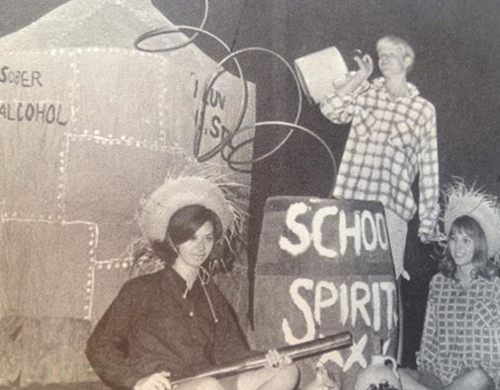
Winning season 5-4-1 allowing only 11.5 points a game. We beat Castle, North Knox, Princeton, Tell City and Boonville. Tied Mater Dei and lost to Rex Mundi by 1, Bosse, Harrison and Jasper. Were 5-1 in the SIAC "A" Division.
New Harmony Parade.....1964
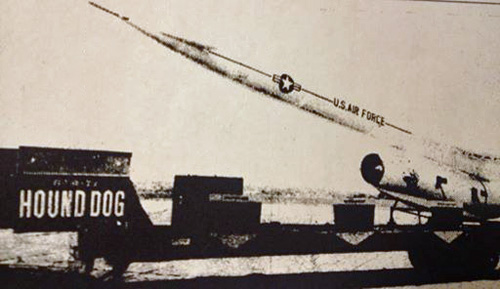
On the 150th Anniversary of the pacifist, non-violent socialists called the Rappites supersonic jets roared overhead and an air to surface missile was paraded down the street. How about that Father Rapp?
Gary "Bucky" Burns Pitches 3 hitter with 17 K's in Legion Action.....1964
Gary Burns pitched a complete game in 3-2 win at Athletic Park in win over Mt. Carmel, Illinois. Mt. Vernon trailed 1-0 going into the bottom of the eighth inning on a walk, sacrifice, passed ball and a error. In the last half of the eighth inning, Ernie Colbert walked and scored on Eddie Howard's triple. "Sneak" came in then on a passed ball to give the home team the lead. In the ninth the visitors tied it up at 2 with a walk and a triple. In the home ninth, Mark Nix hit a triple to start it off but made a big mistake trying for an inside the park home run. Burns and then Bob Ashworth followed with walks and scored when David "Fish" Trout hit a scorching liner that got through the second basemen. Dave's son Dustin is fine golfer. I played ball with and against all these guys during the summer. In high school I just carried their bats ...LOL. They were a tough unit. I remember Ernie too with a few of our matchups with NP.
"Look at That; Look at That." Carmi UFO Causes Traffic Jam....1963
"Hello, city police dispatcher, may I help you?" ..."a what?" ..."A tadpole in the sky near the airport?" "Sir have you been drinking?" "Okay give me the information." ...."Yes this is Phillip Dean at the Carmi Airport and there is this large light hovering over us for at least 20 minutes, do you know anything?"..."No not really, but we have had other calls, I'll forward your information to the authorities. Goodbye."....."Hello, city police dispatcher, how can I help?"...."Yes this is Bob Mick and I see this red flaming light in the vicinity of the airport." ..."You too huh? Can you describe it?"...."Well it is sort of like a cigar with red flames shooting out its tail."...."Okay, we will check it out. Thank you."....."Hey, Jim we have been getting quite a few calls about a UFO, have you seen anything?"...."Well, a yeah, somethings happening, cars are pulling over and getting out to look to the sky. We need another couple cruisers down here for crowd and traffic control."..."Roger."
Remember when John Glenn Got Spaced Out? Local Man Helped his Recovery....February 20, 1962
During that winter I was in the junior high and we got to see him blast off, go around the earth three times and land in the ocean. It was a big deal...Cronkite on TV and T minus ten, nine, eight, seven, six, five, four, three, two, one....ignition, lift off. Friendship 7 blasted from Cape Canaveral. Charles E. Smith was an aviation electronics technician, second class of the U.S. Navy and a Mt. Vernon native. He served with Patrol Squadron 44 which participated in the recovery operations of the Project Mercury orbital space flight. There he was helping to retrieve at sea the new hero.
George Goebel in Mt Vernon.....January 1962
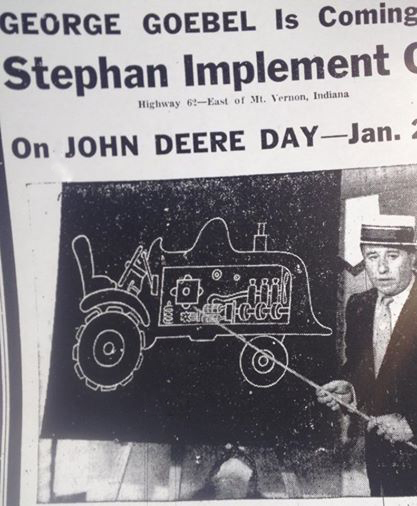
Armory Anti-Red Film Exposes Beatniks In San Francisco.....1962
"Operation Abolition" was a controversial film that alleged the Communist were behind student demonstrations in San Francisco, Oh, those "outside agitators"....how often did I hear that in the sixties and seventies? The film was shown at our National Guard Armory on lower Main Street sponsored by the Mt. Vernon Business and Professional Women's Club and the local Lions. This film was shown by the Un-American Activities Committee of the House of Representatives who conducted public hearings on the demonstration. Republican candidate Edward Soniat in Evansville said protests of the film itself by students, professors, clergymen, and even congressmen were inspired solely by the leftist press. No charge for the viewing and the public was urged to please take home the handouts to carry the message home to their organizations. Meanwhile, the Board of Education of Mt. Vernon authorized the use of the new high school as an emergency hospital in case of a disaster or extreme emergency. The request from the Civil Defense was honored by Hugh W. Price, superintendent of schools. Fallout Protection booklets were also available at the Mt. Vernon Post Office in the Defense Department's new free literature. Can be picked up in the service window. Local activity showed no signs of a stampede to build shelters. The film footage was from May 13, 1960 when the Committee convened in San Francisco's City Hall. Students filled the hall in protest and the police arrested 64 students. The footage was taken by subpoena from TV newsreels and used it to conclude that they were instigated by Communists. Over 15,000,000 Americans saw the film.
15th Anniversary & Remodeling Celebration of Service Shoe Shop.....1962
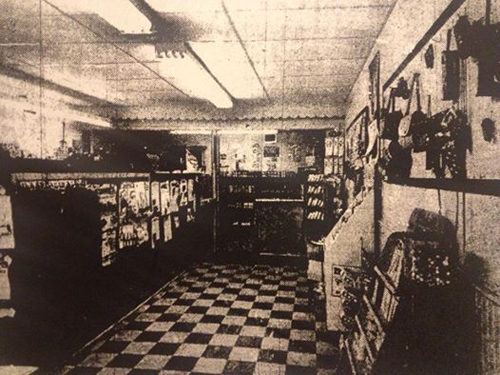
Wayne Brooks of 222 Main Street had a big day that Saturday in January. The Service Shoe Shop had a new front and a new interior to show off. They had new shoe repair equipment on hand and all that came in that day they put on new rubber heels! I kid you not! Free gifts were also given out to visitors. Did you go down and get your personal shoe horn or tin of shoe polish that day? Maybe some taps for your engineer boots? Brooks used all local men for his remodeling like Ohio Veneer and Lumber Company, carpenters, draftsmen, painters and electrical installers.
Mt. Vernon A & P Renovates 1962
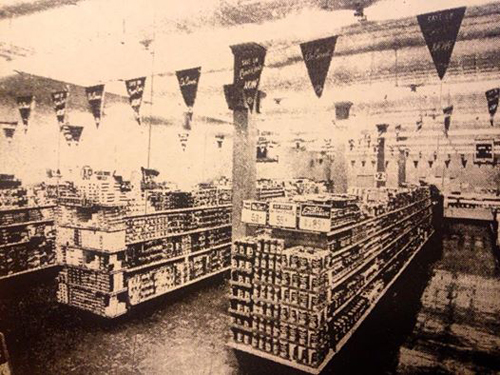
A&P was leased from Nick "the Greek" and was managed by Billy Joe Vick. After this renovation it had lime green walls and purple supporting posts. The market installed new white bakery racks and in the back a large deep freezer chest. Another chest for meat products was added and the aisles were widened to solve the problem that existed of blocked aisles with grocery cart traffic. So yield at the intersections to the one on your right and stay in your lane. Watch out for those beanie weenie cans on the corner.
Kiyoshi Speaks to West Elementary PTA.....1962
The Japanese exchange student of Mt. Vernon High School spoke of Japan's rapidly westernizing in the cities. He spoke of family relationships and of arranged marriages in Japan. He told of the tough schools and examinations required of them for college entrance. He gave insights into a large population in a small area that averaged 600 people per square mile. Devotions were given afterwards and prayer was asked for "divine guidance in the threat of nuclear warfare."
School Teacher Travels the World.....1962
Rachel Conlin of West Grant Street visited fourteen countries in sixty-four days. Traveling from California by boat to the Far East and Middle East and by plane to the Near East and back by boat to the U. S. she bargained with merchants in Hong Kong and Manila, visited the Taj Mahal in India, rode a camel to the Egyptian pyramids, and walked the path to the cross in Jerusalem. Her tour had her in Hawaii, three cities in Japan, Singapore, Ceylon, Bombay, New Delhi, Beirut, Istanbul, Athens and London. I have found that traveling expands my understanding of others, broadens my imagination, and even lets me appreciate my home. The world is a great book with many stories to be read.
Glenn Curtis Meets Richard Nixon.....Early 1960's
Glenn told how he was trying to unseat Clinton Maurer and Republican Party Chairman of Posey County, Someone I can't remember, whom he said, called Glenn and said they could be invited to see the then Governor of California in Evansville for a dinner. Well Curtis and this other guy rented tuxedos for the event and they were the only people there dressed so elegantly. They really stood out and the audience sort of thought they were really somebody. They put up what Glenn called a "soapbox" for Nixon as he was sort of short and he gave his speech. Somehow Nixon got to talking with Curtis and where he was from, Dick said, "I have family in Southern Indiana." My family were Quakers, Glenn said, I am a relative of Levi Coffin the Quaker, abolitionist and he and Nixon generously talked about religion. A picture was taken of them and put in the Mt. Vernon Democrat. Maurer was hot about it, because he was not in the picture and excluded from the photo. He had his revenge however, as Maurer retained his chairmanship.
B&W to Town.....1962
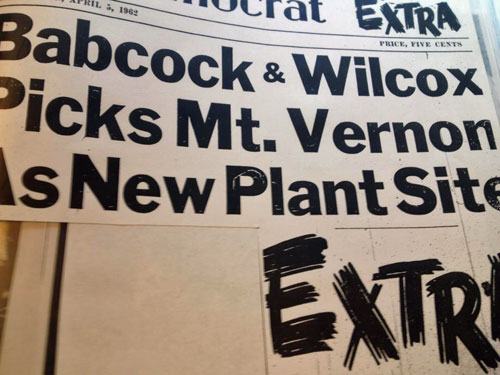
In 1962, B&W breaks ground, and with it and General Electric providing jobs, a new subdivision is approved by the Mt. Vernon City Plan Commission....they will call it "Park Ridge" officially, but some had another unflattering name for it. The fact is, it has remained a beautiful place of well kept up homes for fifty years.
1961 MV Basketball Program
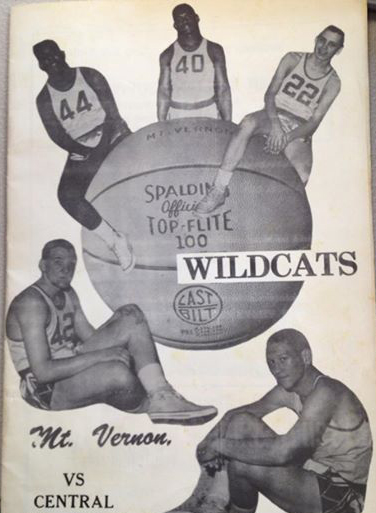
Bottom to top: Neil Curtis, Ron Wade, John Price, Mike Stewart and Bryon Kempler. We lost that game to Central 83-79 with Mike Stewart hitting for 21 points. Cats were 10-11 that season, losing several close games. We beat Memorial that year for the first time since 1936, lost to Mater Dei by one in overtime, lost to Tell City by 2 who were semi-state Champs that year, lost to Lincoln by 4, and lost twice to Rex Mundi by 2 and 3 points. The second loss was in the Sectional when Neil Curtis tied the then record with 35 points, previously held alone by Charlie Brauser, since broken by several others. Mike Stewart ended his high school career then being the all-time local scorer with 900. He ranks 6th today.
June Carter at Juncker Bros. "Field Day".....1961
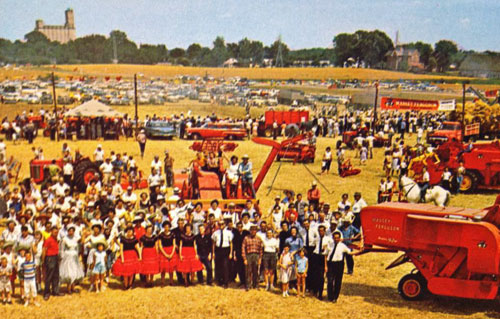
At the fourth annual Field Day, July 4, 1961 Massy-Fergusons were everywhere at the daylong event. The land was owned by Texaco, Inc., and Mrs. Ethel Smith and we had threshing, combining, mowing, raking, baling, planting, and discing. A Keck-Gonnerman steam engine and thresher, owned by William Holler was started and there was a separator crew who thresh shocked wheat to demonstrate the old grain harvest methods. The St. John's Methodist Church of Caborn operated a food tent to an estimated 10,000 people during the day. Television stars appeared including Slim Wilson and his Band, seen each Friday night on NBC; Wagon Wheelers dance group was there and June Carter. Now that's somebody isn't it? ~Wavy not much up on country. Also there were Cecil Brower, Lew Childre, Speedy Hayworth and Bob White. That woman on that piece of farm equipment in the center with the man in the blue shirt and straw hat is June Carter....."Hee Haw!"
Mary Andersen at her rural school house home.....1960
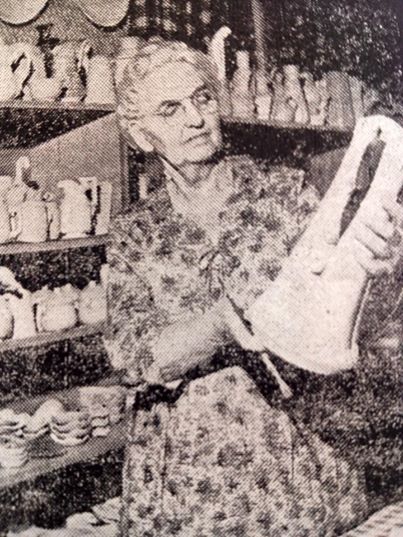
Here Mrs. Andersen, wife of Mt. Vernon Creamery businessman, Holger Andersen taught classes both beginning and advanced in painting and ceramics. I remember at the General Baptist Church on College Avenue in my youth there was a painting of hers in the foyer of the 23rd Psalm. Her old school house had a blackboard that she wrote her appointments on and many wall spaces were decorated with murals.
Welcome to the New MVHS....1960
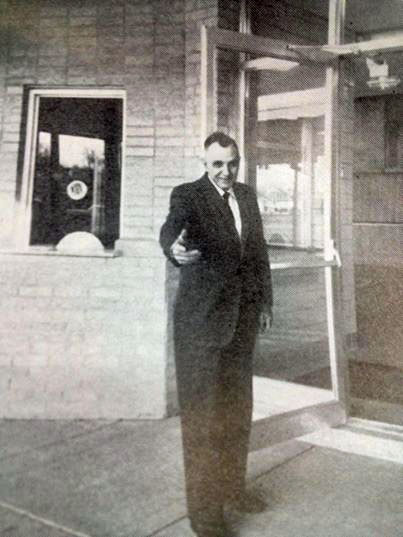
Editor's Note: From those who knew him: What a guy! And we got to go to the old MVHS for middle school (7th & 8th). Sweet. One of the best ever was! Strict but fair!!! Uncle Charles Hames. Great man. Would take on all comers in rope climbing races. Never saw him lose. What a great man. RESPECT A gentleman and a good teacher and principal. I remember that day and him greeting us. I was one of the first ones through the door; I remember Ann Crabtree & Carol Cook beside me as we went into the "new" MVHS. We couldn't have had a better man and leader than Charlie Hames to guide us thru our high school years. That was a great day for all of us students at MVHS Absolutely the best, honest and what he said he meant it. No lying tongue did he use.With all due respect RIP Mr. Charles Hames. You were respected!!! He was a non-nonsense guy. One time my buddy Jim Challman and I got into a pushing contest going up the stairs to the 3rd floor with Melvin Redman and JD Smith. Nothing serious but young men out of control. Mr. Hannah shipped us off to Mr. Hames office. He suspended Melvin and JD for a day but let Jim and I off with a tongue lashing. It was a second or third offense for Melvin and JD. I had a great respect for him but he could sure put fear into those who crossed him.
1950's
GE Groundbreaking.....August, 1959
On August 20, 1959 groundbreaking for General Electric Lexan Resin Plant, a 160 acre site, two miles southwest of Mt. Vernon occurred. Lt. Governor Crawford Parker (R) participated.
"Run Sheep Run" became "Hide and Seek".....1950's-1960's
In my neighborhood of the fifties and sixties we had lots of friends on Emmick Street, on Elk, Lincoln and Sherman. We did all sorts of things from sports, "Red Rover", and "Hide and Seek." When the girls were not practicing to be cheerleaders (we had at least six!), we played whiffle ball together and other games. I was reading about an old time game called "Posey County Hum-Bum" which seems to be a variation of "Hide and Seek and "Run Sheep Run." "Hum-Bum" is one of those dark summer night games between the hunters and the hunted. One group takes off saying Hum-Bum as they ran until they are no longer heard. The next group heads after them chanting Hum-Bum, Hum-Bum. The first group tries to get back to safe base without being detected. "Run-Sheep-Run" was an old eastern colonial neighborhood game where there were sheep and foxes. The sheep elect an Old Ram to be their leader. They head out and the Old Ram finds a spot to hide them as a group. The ram then returns to the Foxes Den and says, "I have hid my sheep and you cannot find them." The Fox King is the decision maker for the foxes and them as a group search for the sheep. The Old Ram goes with them and when she determines that her sheep can safely return home, she says: "Run sheep run." If they get back home safely, they become the foxes. The winner is determined when one group becomes the foxes three times. Tales, ballads, traditions, games, and such use to filter down to new generations and are altered some, but survive. Much is been lost. I guess "musical chairs" still exists at birthday parties. The cheerleaders were Ann Shuler, Sherry Carey, Jodi Weintraut, Betsy Weintraut, Carolyn and Christine Russell. Did I miss anyone?
711 Posey Kiddies Transported to Shrine Circus in Evansville.....1958
The 24th Annual Shrine Circus in Evansville was a big success. 3,000 people lined up at Dress airport to see star Matt Dillion arrive. Seventeen school buses from the county took the children as Mt. Vernon Police escorted the busses to our city limits and State Police to Robert's Stadium. All had a good time watching the elephants, leopards, chimps, clowns and the high flying trapeze acts.
Park Board Games in Late 50's
I recall, I believe they called it, "Night of Champions" at Athletic Park where Pee Wee, Little, and Pony Leaguers would run 40 and 60 yard dashes, bunt and run to first, circling the bases for time and a shuttle relay. Gerald "Flopsy" Phillips would be in charge. Tryouts for the Advance Drillers All-Star Little League Team were held on the diamond and track too with coaches Jackson Higgins and Ron Bennett supervising. Men my age and older still talk of their Driller experiences. It was a chance to play ball in different towns in the county in a simpler time, to bond together and travel as a team. We seemed to always win the championship and get to go to St. Louis for a big league game. That was so amazing! Wearing our AD caps sitting together in the ancient Sportsman's Park grandstand, yelling to players for autographs and baseballs. During the regular Little League season we were allowed to wear our Driller hats with our respective teams like Lions, Jaycees, Retailers, Eagles, Moose and Elks. Baseball was so very important to me and others in that time. Wooden bats too. We all loved the Mantle, Aaron, and Mays models and rejected for the most part the larger handle Fox and Jackie Robinson offerings. "Chicks love the long ball!"
One of the Headliners for Mt. Vernon Fall Festival.....October 1957
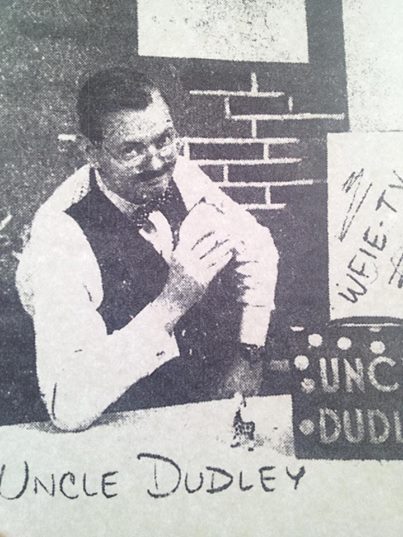
On local TV 1956-1964
Mt. Vernon's Battery B at Camp McCoy, Wisconsin.....August 1957
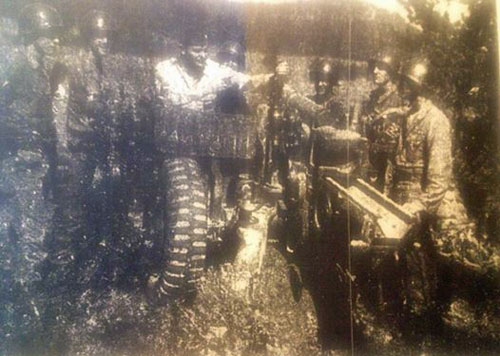
Lt. Col. Joe Cook, Army Adviser to the 163rd Field Artillery Battalion of the 38th Division (third from left) gives a few pointers to our local National Guard unit. L-R are Pvt. Billie Rudd, Sgt. William Orth, Lt. Col. Cook, Sgt. William Higgins, M. Sgt. Malcolm Goff, Sgt. 3rd class Marvin McDurmon, and Pvt. Paul Wade.
Flying Saucer Seen Here on Wednesday Seen All Through State the Next Monday.....August 1957
Mr. and Mrs. Harold Smith and Mr. and Mrs. Lester Cox of Mt. Vernon saw six lights around 9 p.m. on a Monday evening floating in a southerly direction across the sky in the Mt. Vernon area. Reports locally varied as to the color, but all agreed there was some illumination. Local viewers not coming forward said the floating objects moved in balloon like formations. Later other parts of Indiana saw them and Police headquarters were busy taking the calls, sky watching and coming up with explanations. Strange objects with pastel lights were seen by State Police troopers in dozens of cities including Tipton, Kokomo, Elwood, Portland, Hartford City and Anderson. No grays, weird humanoids or greenies were seen.
Squirrel Season Brings Out Aggressiveness in Rodent.....August 1957
A dog chasing squirrel was vouched for by residents of the 600 and 700 block of East Water Street in Mt. Vernon. This one particular squirrel apparently had his abode in a tree on the south side of the street. Neighbors had seen him play all summer and become friendly with people. However, Mrs. Myrtle Cox of 631 East Water said she saw the squirrel "make a small dog take tail." Mrs. Maxwell Bloodworth too saw the squirrel chase a dog onto the owner's porch in fright. Maybe if the dog would paw feed the squirrel a peanut they could be friends. Just a thought.
Future MVHS Basketball Star Breaks Both Legs in Cemetery.....July 1957
Eddie Shelby #14 star forward of our 1972 22-2 team and future player for the Evansville Aces started out with quite an injury. When he was three years old the son of Mr. and Mrs. Harold Shelby of 1110 West Third Street suffered fractures of both legs when he pulled a tombstone over on himself in a cemetery in Salem, Indiana. The family was visiting with Mrs. Shelby's father, Raymond Baynes at the time. He "rebounded" quite nicely.
Mystery Unsolved of Cigs Left On Porches.....1957
A north Locust street mystery remained unsolved it seems despite the fact the Chief of Police Raymond Cox maintained a night vigil over three nights. Reports had come in of residents of the 800 and 900 blocks of Locust receiving packages of cigarettes and books of matches left on their porches during the night. Efforts to catch the depositor proved futile during three nights of hiding in the neighborhood. One package was sent by the Police Department to the state for analysis, but it seems nothing ever became of it.
Mt. Vernon Eight Man Football Highlights.....1947-1957
The 1951 Wildcat team, coached by one of the most successful MV coaches ever in many sports, Jim Baxter, posted an 8-1 record and won their fifth PAC crown. One week after losing at Cannelton 21-18 they bounced back against Tell City at home. The Marksman took a 16-0 lead at the end of the first quarter, but the Wildcats rebounded to win 30-22 in a comeback that local sportswriter Bill Causey called, "maybe the greatest ever at Athletic Park." That roster included many known names. Here are a few: Gary Adams, Don Bergstrom, Sam Blankenship, Ottie Carr, Ansel Cole, Ron Deckard, Gary Gronemeier, Gary Dersch, Oscar Hahn, Don Hartmann, Bill Humston, George Hurley, Johnny Johnson, Dennie Kercher, Bobby Martin, Lige Morrison, Milburn Stinson, Bob Wade, Jesse Walker, Harry Wells, Marion Wentzel and Dean Whitesides. In 1954, many say this was the best team ever. It posted a 8-0 record, winning their sixth title and then added a 25-0 eleven man win over the Mater Dei reserves in a post season encounter. Bill Higgins and Arby Mason, halfbacks led the way with 97 and 72 points and each scored in every game of the season. Phil Hostettler, a good pitcher in baseball, was the quarterback and he counted for 48 points. John D. Roberts, Duggie Taylor, Darwin Jackson, Bill Holler, Larry Deig, Jim Price, Allyn Simpson, Dick Vance, Dick Knight, Wayne Adams, Charlie Zenthoefer, Clarence Hendrick, Jim Stewart, Jim King, Bob Kirkpatrick, Will Thomas, Leroy Kercher, Don Gumbel, Dave Ries, Max Whitesides and Ed Beste. Funny, but no Mt. Vernon player made the All-Conference team that season. Causey had a headline..."We were Robbed." So many qualified players it seems that the ballots were split too many ways. It made for quite the conversation at the post season football banquet.
Double I League Leading Hitters for the Year of 1957
Bill Hall led the circuit from Mt. Vernon hitting .386 with 22 hits in 57 at bats. I can remember his powerful left handed swing. D. Mounts of SW was at second at .381. G. Piland of G hit .378. Vessels of SW hit .375, D. Fischer of St. Phillips was at .372, then came Mt. Vernon's Darvin Rueger .359, and Bud Schnarr playing for our Merchants at .357. J. Wenderoth of St. Phillips hit .347, R. Callis of G hit .343, L. Weinzapfel of St. Phillips was at .340, Shirley Weiss of Al's Place came in at .340. Eickhoff of St. Phillips hit .333, and "Chummy" Jeffries of MV hit .327. In 1958 and 1959 the Mt. Vernon Merchants would capture the Double I League pennant before several star players would move on to St. Phillips including Jeffries and Art Hall. Bud Schnarr I played softball with for George's Stucco House in the late 1970's and early 80's. He was in his early 40's, pitched along with Tom McNamara and played some first. Great teammate and he could hit still pretty good. He would throw you a nasty knuckleball in warmups. He was always trying to talk me out of my baseball cards. Darvin Rueger played semi-pro forever (25 years) and could run with the wind. I actually played a high school old timer's game in 1991 and he played, graduating from MVHS in 1945. He was a great athlete in all sports. Shirley Weiss was a catcher and I am told he and his brother Les formed the best pitcher-catcher battery in the area. I played ball also with Tommy Weiss, a powerful softball slugger. Gerald Jeffries, was my high school coach. I didn't play much back then due mainly to the great class before me that only had two losses the entire season. Coach decided to go with sophomores mostly my senior year and he captured five straight Princeton Sectional titles and a Regional title in 1971. He knows his baseball and has my respect.
My Uncle Sam Simmons at the Controls of Last Voyage of the Dogtown Ferry.....July 1956
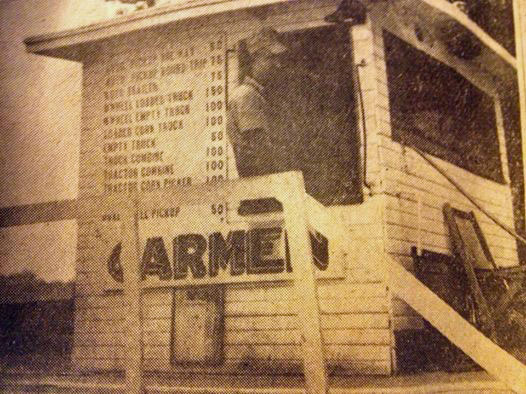
The march of time and progress took down the ferry trade faithful since pioneer times when the Wabash Memorial Bridge opened. Hundreds of thousands of people moved over the Wabash over time by the ferry system. My uncle was one of the operators of the "Carmen" at the end and moored her on the Indiana side...her big paddle wheel stilled.
June 1956
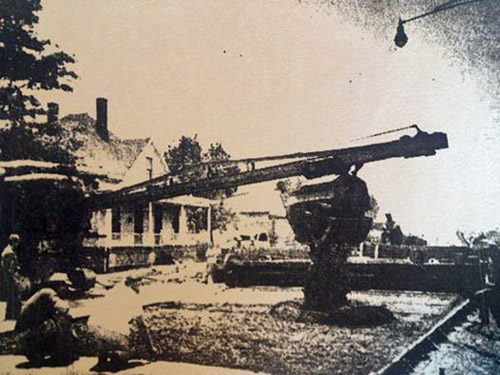
The last pour of concrete at the end of State Road 62 leading into Mt. Vernon at Barter and West Fourth Street connecting us to the Wabash Memorial Bridge.
Farm Bureau Refinery.....1956
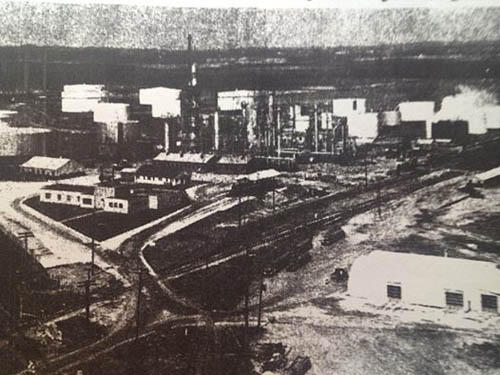
Farm Bureau Co-Op.....1956
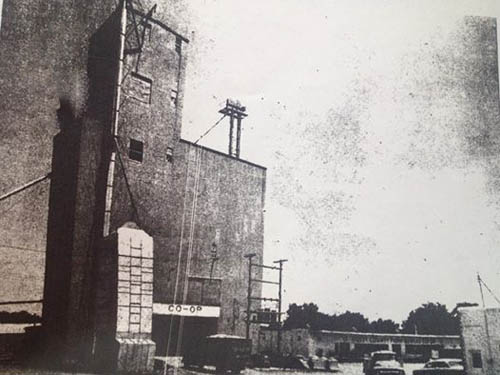
1956
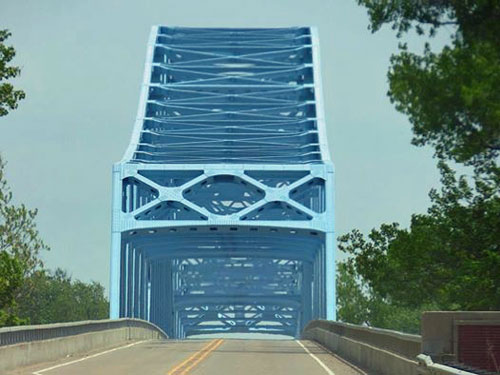
Chawn Essary takes some great photos. I liked this one of the Wabash Memorial Bridge, opened in 1956.
Co-Valedictorians.....1956
Anglicized derivation of Latin to mean "to say farewell," Jeanne LaDuke and Ruby Schorr each received a $50 scholarship from Gamma Psi (Mt. Vernon) a chapter of Kappa Kappa Kappa sorority in Mayor Honor Day exercises.
April 1955 closing
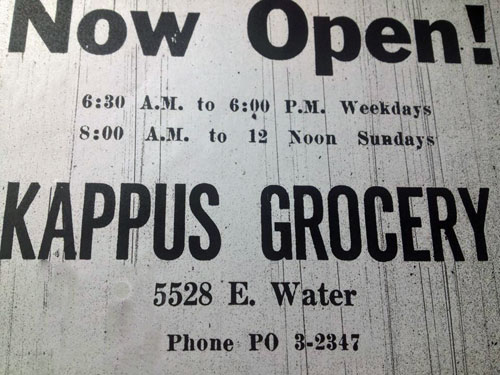
In April 1955 the Kappus Basement Grocery closed which had opened in September of 1953 at 528 East Water Street
Keck's Used Cars.....1955
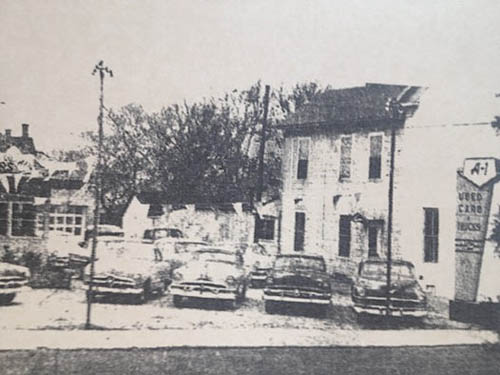
Local GI Pays MV Parking Ticket in Wons.....1953
From far-away Korea came a reply to the Mt. Vernon Parking Meter Department that a ticket had been unpaid. Pfc. LaVerne Kaffenberger wrote back that the offense in his name was not committed by him since he had been in Korea for seven months. Kaffenberger included in his note a 1000 won South Korean note. He said, "so that there be no confusion in your records. I am enclosing herewith money to pay the fine incurred. Unfortunately, no standard American currency is available so I hope that the one thousand won note will cover the charges. Should the amount not be sufficient to pay the unwarranted fine, you can send your representative to my current address in Korea. It is suggested that he dress warmly and be prepared to dodge artillery shells." The private's parking meter account was stamped, "paid."
Maas Papers.....1953
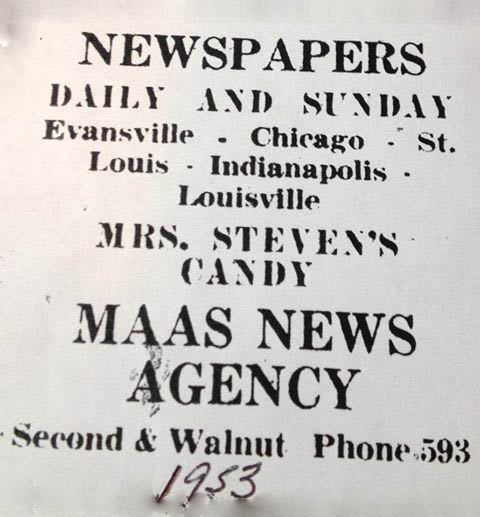
Dad would pull up on a Sunday and I would get out of the car, run up to the porch and buy a paper. Usually after church (yes I went), we would have Sunday dinner at Gentil's.
Jimmy Minor.....1953
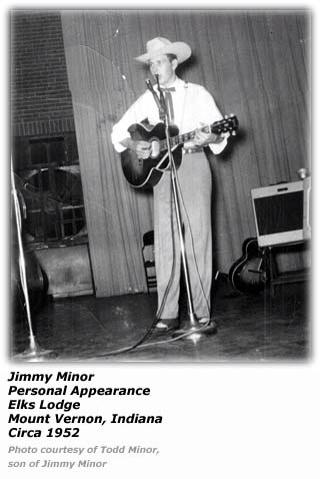
Jimmy Minor Lived in Mt. Vernon 1951-1953. On WFIE TV in 1953 for 26 weeks. Played at the Grand Ole Opry and Ernest Tubb's Midnight Jamboree.
Mayor Once Worked at the Model Bakery....1950-1951
Former Mayor Jackson L. Higgins once worked at the Model Bakery on East Third Street. Bread, rolls and donuts were delivered to all the local small groceries. Donuts were 25 cents a dozen or 3 cents apiece. Of course, Jack got to eat all the delicious rejects and donut holes of chocolate, vanilla, and maple. Sounds like a good gig.
1950.....Locker Service

Destroyed by fire in January 1954 on the 300 block of West Third Street. Ad taken from 1950 Posey County phone book. They have phone books from 1940-1954 locked in a glass case for those interested. Ask for them to open it for you.
1940's
Rolled or Loose?.....September 1949
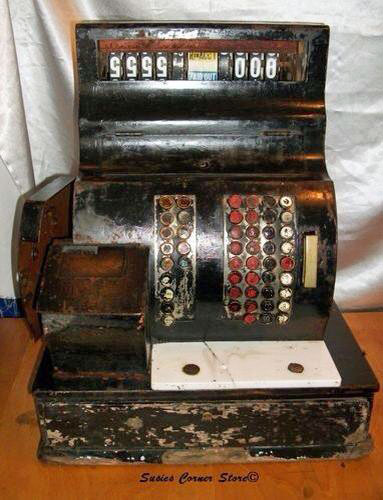
So what happened when you were born? I had Kueber's Standard Service Station on West Third Street and College Avenue being burglarized. The intruders opened something called a cash register (they still called that?) and got about 200 pennies.
Evansville Braves.....1949
In 1949, 80 Mt. Vernon boys attended the Evansville Braves-Danville Three I League game at Bosse Field as guest of the Braves and the Mt. Vernon Kiwanis. One of the players that made a mark in the big leagues and returned home decades later to manage the Tripletts was 19 year old catcher, Del Crandall who hit .351 that season.
June 1948
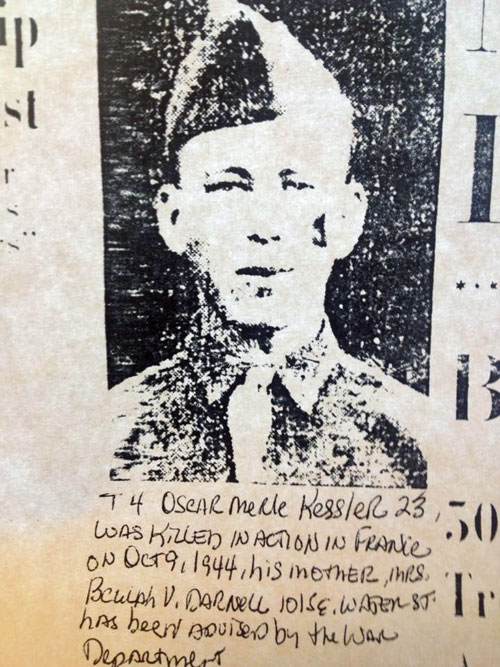
Gold Star Bodies of Staff Sgt. Walter Schenk and Technician 4th grade Oscar Merle Kessler were brought home from the battlefields of Europe
Elks Home Robbers Turned Away By Tear Gas.....May 1948
How many of you have ever been gassed? I was three times. Once in basic training in Texas, once in California after a Hendrix concert, and once in St. Louis protesting Honeywell Corporation for their manufacture of cluster bombs. From the 1920's to the 1950's some safes were equipped with a charge of tear gas. A safecracker who made a miss turn just might encounter about 4 ounces of some potent stuff. It came in a liquid capsule. During a break-in on the first floor of the Elk's Home in Mt. Vernon late one night they set off the charge. Let me tell you...it stinks... the membranes of your nose and eyes burn. I recall my mouth burned too and I was left with a sweet taste deep in my throat when I got done choking, coughing and throwing up. I remember a bunch of us ran across six lanes of traffic to a pizza shop to avoid the gas. On the juke box was Bob Dylan singing "Lay Lady Lay."
"Hot Child In the City".....February 1948
Richard Dueich finally was getting back to being able to sit again. A few weeks prior, Richard got out of the bathtub and backed into a hot stove. Richard was the boy who sold the Courier at Stuffle's and was a pin setter at the bowling alley.
A story on Mayor Jim Bennett as told by Glenn Curtis.....circa 1948
Glenn says that Mr. Bennett was running for Mayor of Mt. Vernon and he was a chewer of tobacco. A lady came up to the candidate on the sidewalk of a local business in town and said, "Mr. Bennett, if you are elected will you PLEASE do something about people spitting on the sidewalks?" Jim listened and then paused, holding up his hand to wait a second, then turned to his side and spit through two fingers onto the sidewalk. "Yes ma'am, I will surely do what I can," and with that he tipped his hat and walked on. Jim had bad vision in one eye I am told from a accident so he didn't see well. Mr. Curtis says he once gave a cardboard cutout of a woman holding a pack of cigarettes as a promotion his election card and said, "your patronage will be greatly appreciated....good day."
First Fall Festival Since the War....1947 Photo: First Fall Festival Since the War....1947
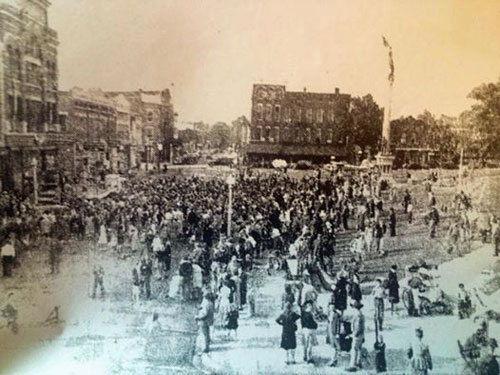
Eight professional acts were booked that first week of October. Dave Alldredge was the entertainment chairman. The headliner was a hand balancing act by the Frank Brock brothers and Mile Dawn a circus athlete.
Miss Lucile Redman Re-Employed by School System.....July 1947
Miss Redman, a former MVHS and elementary teacher was rehired to teach freshman English and be the Dean of girls in the Mt. Vernon High School. Miss Redman had resigned during the war to serve as a Red Cross recreation director. She will fill the teaching position vacated by the resignation of Mrs. Ausburn Stephens. A graduate of MVHS and Evansville College she did post-graduate work in Northwestern University. She was stationed in Atlanta, New Orleans and Camp Campbell, Ky., during her three and a half years with the Red Cross.
New Fountain Installed.....Summer of 1947
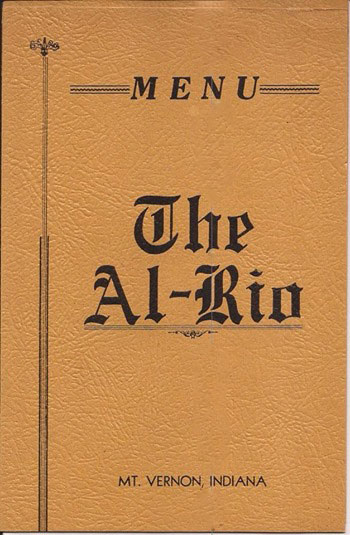
A late model liquid carbonic soda fountain was the latest installment at the Al Rio Restaurant at 127 Main Street. The new fountain is a compact unit and equipped with a silent carbonator. So, head on down there and have the soda jerk pull you one from the tap. Boy these fountains sure are expanding in the city. Seems like everyone was getting them except Ira Rothrock.
"Dutch" Fans 14 in League Action.....1947
Wehr, the great redhead hurler for I.O.O.F. pitched a seven hitter and worked around three errors to defeat the American Legion 9. Wehr was only in the trouble in the sixth when he gave up a double, triple and a homer. The blast came from Nunnelly was deep to centerfield. Warren Rueger did the receiving. Templeton was the umpire.
Ex-Sheriff Makes It Hot for Fireman.....June 1947
Continuing to pick on E.W. McFadden, the Western Star said the fire department put out three fires in the same Model T Ford within 30 minutes. McFadden (whom Doug McFadden said "had no license"), was trying to get to a garage. Each time he tried to start the car; gasoline was released by the flooding carburetor and ignited by the backfire each time. Loss was not heavy. The story of Mr. McFadden's progress through the city streets before finally being towed was documented by each fire alarm: First, at 2:07 p.m. to Second and Mulberry, the second at 2:30 p.m. to 827 Walnut and the third at 2:37 p.m. to Tenth and Walnut Streets.
Firestone Store Changes Hands.....June 1947
The operation of the Firestone store at Fourth and Main streets was taken over by Gene Burris and his father, Arnold. They recently purchased the store from the Wilderman brothers. Gene Burris resigned his position as Evansville salesman for the Evansville Supply Company and Arnold from the Fuhrer-Ford Milling Company locally. The new name will be...."Burris Home Auto Supply."
Flu Epidemic Deadly at MVHS.....1947
One day in March 188 pupils of our schools were out sick, the next day it rose to 291. One teacher was out as was four employees at the post office. One 17 year old student of the high school died of the epidemic. Classes closed on March 13 for a three day vacation with 25% of all students absent the day before.
Ham Operator Albert Gerth.....1947

When Gerth served in the South Pacific and Japan he picked up dials, tubes and Japanese condensers. He said they were excellent.
Slater's Newspaper Had Long Run.....1947
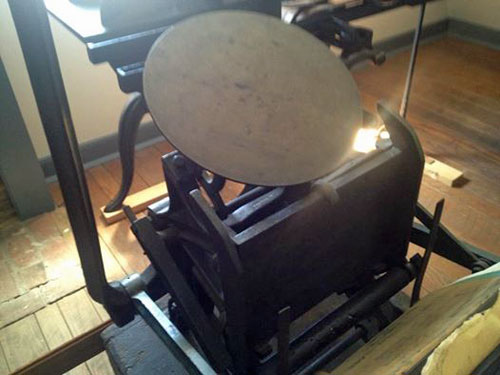
Harry T. Slater died in New Harmony in September of 1947 was the last of the "old school" publishers in Posey County. His father, Charles William Slater, founded the New Harmony Register in 1858. Harry became editor-publisher in 1894, after serving an apprenticeship. The newspaper was printed on an old Washington hand press all through its 74 years of existence and was believed to be the oldest intact machine of its kind in the country. Henry Ford sought to buy the press for his museum when the Register discontinued in 1932, but Slater instead donated the press and other printing equipment of that age to the New Harmony museum. Last year I got a chance to look at it on a Posey County Historical Society tour. It is a beautiful machine.
The Cat Man.....1947
If it wasn't enough that the country was besieged with flying disks hysteria, we had the Cat Man in Boonville and rumors in Mt. Vernon. In December of 1947 the Cat Man made his first appearance scaring women and children. Described as "a big, black body and monstrous paws that he holds aloft on a level with large, green, glistening eyes. He walks upright on his hind feet." By early January of 1948 Mt. Vernonites began seeing the Cat Man. Rumors spread and laughter filled the restaurants and barber shops. "I saw his tracks down in the park," said one. "I heard the police fired three shots at him by the railroad tracks," said another. A third said, "My son saw him looking in the window." Holy Big Foot! In Boonville a posse looked for it, but with no success. "Cat Scratch Fever" continued in town and the local police received many calls wanting confirmation of what they had heard tell. Police were dispatched to the L&N depot to look around, but that was about it. Soon it became forgotten...until resurrected by a strange character named ~Wavy.
The Peerless Moves to New Location in December 1946
The Peerless Cafe, owned and operated by Raymond Schenk, formerly located at 209 Main opened in its new location at 101 Main Street. Walls of the place of business were done in mulberry color which was said to "harmonize with the mahogany woodwork trim." Tile, inlaid linoleum was laid. There was a modern bar, ten booths and serving tables and two clean modern rest rooms. A hot air furnace was installed and fluorescent lighting, Personnel remained Harold Gwin, Otto Pfeffer, Mrs. Agnes Beirman, and Miss Ivtol York with Clint Cornelius and John Henry Bryant as porters. "Come Party at the Peerless!"
Spring is in the Air.....March 1946
At College Avenue Park the Japanese cherry trees were in bloom. At Wehr's Flower Shop they made a sale of 100 dozen daffodils to a party from Gary, Indiana who picked them up personally.....and then there is baseball fever! May we live in Peace.
75 Year Old Local Sees New Harmony and Poseyville For First Time.....1946
George Schauble resided on a farm in Marrs Township all his life. Oh, he had been to Mt. Vernon many times selling his sassafras in late winter. He admitted one day that he was 18 before he had ever been to Evansville and had never seen New Harmony or Poseyville. Fred Miller, who resided in eastern Black Township, invited George to come along with him as he had business at the Breiner & Uhde Implement Company in Poseyville....on the way back they came through New Harmony too. This sounds bad, but I haven't been to Wadesville or St. Wendel since I played baseball on the Advance Drillers Little League team. My friend Steve Wassmer took me around a few years ago to Stewartsville. I get to New Harmony and where once I played many a game of softball in Poseyville, I don't get there much anymore. I need to get on a road trip to Bugtown and Griffin and Bull Island...yeah BULL ISLAND!
Mt. Vernon Six Man Football Highlights.....1938-1946
In 1940 the Wildcats posted a perfect 8-0 record, coached by state and local Hall of Famer George Ashworth. That season Warren Rueger posted a new Pocket Athletic Conference record of 109 points. Their only close game was 20-18 over Petersburg and we became the first PAC champion to win without a loss or a tie. During 1943 and 1944, Maurice Abel coached the locals to two consecutive undefeated seasons 4-0 both years as travel problems and rationing took its toll on schools. Mr. Hames said to me that often a gallon of gas would be left in his driveway for sports travel by the public. Outstanding players in that period were Darwin Rueger, end, and Ernest Bishop, back. We tried many times to get Bish to fill out a questionnaire for the MVHS HOF, but he never did. I don't think he still is in the HOF despite scoring six touchdowns in one game. His son Brian is however. Other top players were Jim Jolly, center, and Charles James Jr., at quarterback. That 1944 team was very powerful running up scores of 46-22, 63-22, 60-13, and 44-18. In the final season of six man football of 1946, Mt. Vernon won its fourth title, winning six and tying Tell City, a longtime nemesis. Bob Walker, halfback, and Charles Nunnelly, end, paced the Cats. In 1947 the PAC added two guards to the team becoming an eight man league.
Farmersville Bell Dismantled in 1946
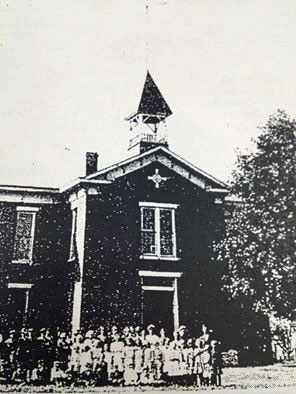
A cast brass bell made in Cincinnati bearing a casting date of 1852 that once called students to this Farmersville School, built in 1875, tolled no more. Removal came by Hilary Lamb, local teacher after large leaks in the belfry that seemed to resist fixing. The belfry itself was taken down in 1958. In this school grades 1-8 were held. I wonder where the bell is today.
New Fountain Pen at Stinson's.....Get One, Shake It, Doodle.....1946
Stinson Brothers down on Main has a pen that writes for up to two years without refilling. It's a Reynolds pen and you can carry it point down in the pocket of a pressed white shirt and not get one of those embarrassing stains or wear one of those unsightly nerd pencil packs in your pocket. They say it requires no attention whatsoever...hell, put one in your pants pocket, your suit, or the glove compartment. Get a bunch of 'em. The Satinflo ink can write a line 21 miles long before used up. Get one and try...start at Heinie Moore's and mark to Sears Roebuck in Evansville. It's beautiful, it's practical and it can be yours!
Vernon Kirk....Lost on Submarine.....1945
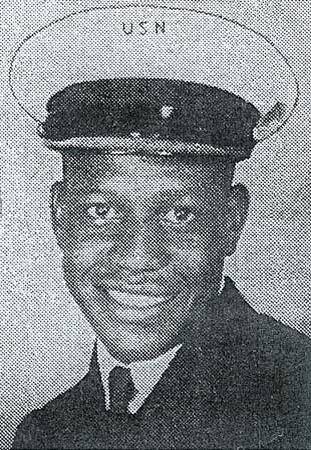
Vernon Kirk was just twenty years of age, a Steward Third Class aboard the USS Swordfish, a submarine. It left Pearl Harbor on December 22, 1944 and fueled at Midway Island on December 26 and proceeded for duty in the Okinawa area. The last message from the sub was received on January 3, 1945 and she failed to report at Saipan on about January 29 as scheduled. It was believed the sub was sunk by Japanese vessels in the Ryukyu Islands on January 12, 1945. The Swordfish was the first Navy submarine to sink a Japanese ship during the Second World War. The ship had 8 battle stars. Vernon had two brothers at the time in the military, both honorably discharged. Henry Kirk served in the Fifth Army in Europe and Ira was a cook on a hospital ship in the Pacific. A younger brother Steward enlisted in the Navy later.
"In the Still of the Night....sha dub show b dub"......1945
Cruisers use to ride down the streets and alleys during the 1940's during black outs to keep records of outages and everyone being compliant. We had 250 street and alley lights back then and they were used sparingly. Headquarters was contacted via radio from the patrol car when they were on to see where they could use less. Many lights were extinguished at midnight. Residents pulled blinds and pulled curtains to keep out the light.
"Sergeant" the Fire Dog....1940's
One day a smart little dog wandered into the rear of the city building and showed so much intelligence and charm that the fireman, policeman and others of City Hall took to him immediately and adopted him. The dog really liked fire trucks and his bed became the seat of one truck that he learned was the first to leave the station. He loved the excitement. He soon became aware of the fire alarm gong, and when it sounded he hurried to the first truck to leave in order to ride to the fire, and if he was out "running around" at the time of the alarm, he could be seen racing down the streets to the scene of the blaze. He always showed. If it was in cold weather, he would examine the fire and when it looked like it was under control, he would sometimes scratch at the police car nearby and they would let him in to warm up. A harness was obtained for him and he was named, "Sergeant" and became a fixture at the city building. One other story of his devotion to duty was when the pumper truck was taken to Hasting Equipment Company for repairs to the pumping unit. Like I said, the mascot always slept on the seat cushions of the pumper truck because he knew it was the first truck to leave the firehouse. On this particular day, Sergeant, as usual made the trip to Hastings on a Thursday night. The fireman returned to the station and noticed that the dog was not with them. The following morning they went back to Hastings at dawn and there was Sergeant curled up on the running board of the pumper. His seat cushion bed was gone, as the seat had to be removed in order to lift out the pumping unit, but the dog remained loyal to the truck to what he believed was his duty to watch.
Fans and Cheerleaders at Booker T. Washington School... C 1940's.
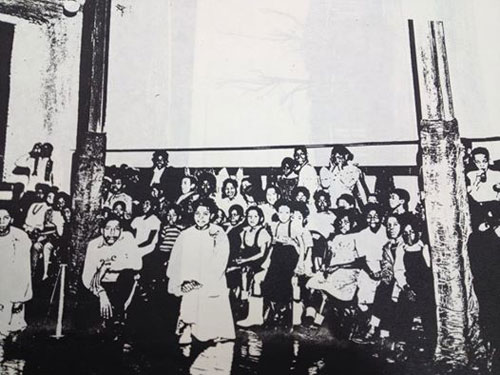
Mt. Vernon in the 1940s
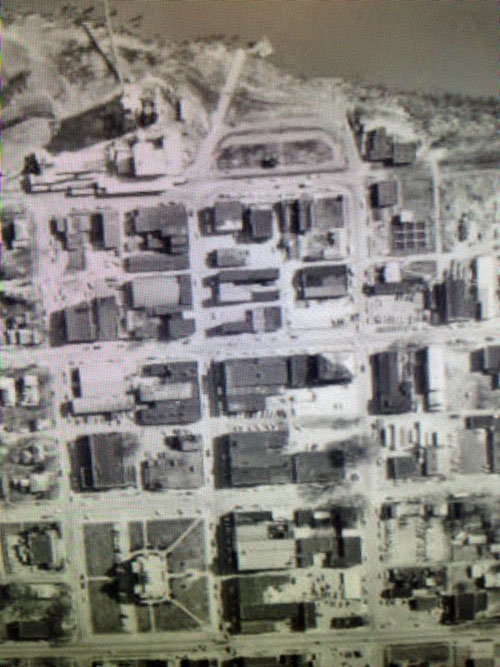
I wonder if the spotters in the dome reported the UFO circling at 15,000 feet?
July 1943
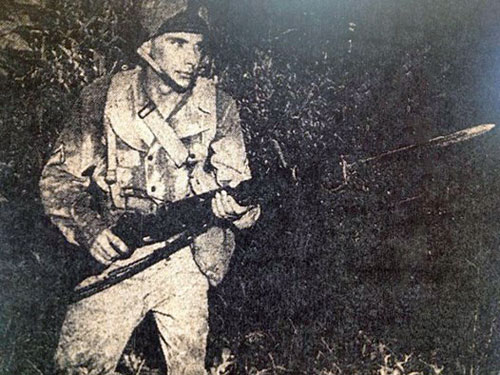
Paul Cullman of Mt. Vernon was on the cover of a Camp Butler NC Pictorial Booklet.
Charles Joest Barbecue and Sandwich Shop Closes.....June 1943
Joest, 72, manager and owner of the tavern/restaurant for over 40 years retired and closed his business at Second and Main. Located where Steve Burris Barber Shop is today it was a meeting place for talk of sports and of outdoorsmen. It had a fine reputation for hospitality and excellent food. "Wartime restrictions, which made it increasingly difficult to obtain stock and labor, were responsible for the closing of the successful business." Charles was well liked and known in the mercantile business. For eighteen years he was the local representative of Sterling Brewery of Evansville. In 1920 he opened the current restaurant. When Prohibition ended he became the first retailer in town to sell beer. A pioneer locally in barbecue sandwiches, Mr. Joest for years did his own barbecuing. Ben Offet, cook and porter had been in the Joest family business for 32 years. With the exception of a brief location in what became the A&P building on Main near Fourth, the Joest firm had been continuously at the present location. His son and daughter had also worked for Charles until Gerald entered the Army and Helen entered the newspaper business.
Students and Teachers Get Army Jeep Rides for War Bond Drive.....April 1943
Rides through the city were provided for students and faculty of Mt. Vernon High School in two jeeps sent here from Camp Breckinridge, Kentucky as the result of a very successful completion to purchase a jeep through the purchase of War Bonds and Stamps. Almost enough was raised to purchase two jeeps at $900 each, as a total of $1514 was raised. The school received a certificate from the U.S. Treasury Department as a result. The jeeps were escorted by several soldiers from the 98th Division Military Police. Those given rides were: Betty Williams, Stanley Palmer, Jo Ann Osteen, Erwin Renschler, Gene Fuelling, Miss Green, Betty Curtis, Charles Blake, Charles Alles, Arlene Noelle, Missy Howden, Teresa Hoehn, Sarah Schneider, Richard Topper, Miss Woods, Doris Melton, Charles Lawrence, Ray Schmitzer, Martha Field, Charles Hames, Betty Baro, Bob Hutson, Oneda McClarney, Clarisea Hoehn, Orville Duley, Miss Rothrock, Darwin Rueger, Dorothy Schreiber, Bob Uhde, Miss Redman, Miss Relander, Carol Duley, and Joe Patton.
Model of Cruiser Vincennes Seen Here.....March 1943
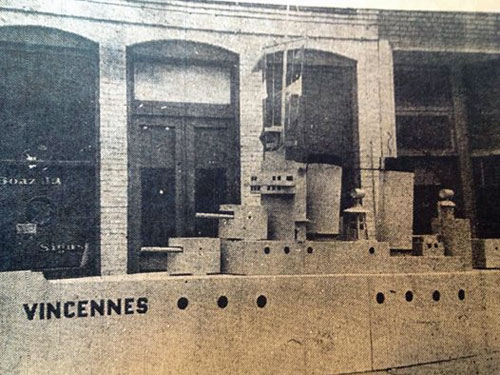
A model of the battle cruiser Vincennes was seen here in a bond rally to raise $22 million in Indiana for the ship. The model was touring the state as part of Indiana's Navalcade starting in Vincennes itself. Other Naval ordinances and equipment followed the display. Warrant Officer Frederick Moody, who served and was wounded serving on the original Vincennes gave a speech at the auditorium. He spoke of how the Vincennes played a part in landing Marines at Guadalcanal, which preceded the sinking of the vessel. He spoke of its role at Midway and how he felt the explosions and concussions as the ship was struck a number of times by torpedoes. He explained how he and other men took injured men to the top deck as the ship began to list, and how they went overboard and were later picked up out of the ocean. He closed with....If you'll give us back our Vincennes, we'll bring you Japan, piece by piece."
Booker T Crushes Princeton Lincoln in Hoop Action.....January 1943
Coach Guy Bishop's Blue Devils smoked Princeton Lincoln there 70-23 as Hershety Stewart rolled in 30 points. Shirley Steward collected 15. I worked with Stewart for many years in the 1970's and he was so easy going and funny. I remember showing a few box scores to him back then and he would laugh and take them over and show them around to guys in the break room. He told me his father lived to be over 100 years old. He told me lots of things, LOL, but he was a friend I enjoyed along with George Payne. I always thought George was much older, but I don't know. There was a Payne on this team too, scoring 6. Hershety, as they spelled it in the Western Star paper died much younger than I expected him to live. I was shocked when he died probably in his late 50's. One never knows when the bell will toll.
Camp Breckinridge Artillery Heard.....January 1943
A thundering sound like dynamite explosions jarred the buildings and rattled the windows on East Water Street early one week. It was believed to have been the reverberation of the discharge of heavy artillery on the range at Camp Breckinridge, Kentucky. The noise of the implements of war came from the direction of the camp approximately 14 miles distant on a straight line. Later calls ascertained that heavy artillery had been functioning quite well on the range at that time "barkin' out the sting of death."
Orvan Hall Receives U.S. Press Credentials.....January 1943
Long time newspaper man, Orvan R. Hall, editor of the Mt. Vernon Democrat, became one of the first newspapermen in the Central Defense Command to receive his credentials as an accredited press representative of the command. Issued by the Bureau of Public Relations of the War Department in Washington D.C., they are for use in the event that enemy action occurs within our area. He will then be allowed contact with the military as an official representative of the War Department Bureau of Public Relations. This week in the Posey County Historical Society Reference Room I was reading Hall's oral history given to Pastor August Bender. Maybe a couple dozen people are listed of prominent citizens. I would encourage others to do an oral history of relatives and long term citizens of our communities in Posey County to share with the citizens of the present and the future. All of us have a story of a fire, an old job, a flood, a parade, or a ball game. Share some of them....please.
Alien Grass Circle at College Park.....1943
A strange phenomenon showed up virtually overnight at College Park. Although it had been a severe drought summer the grass had remained green in the park. Then within a few days the grass turned brown in a perfect circle about six feet in diameter on the north side of the park....the burned circle was about ten inches in width...inside the parched area the grass was green and outside the circle it was also green.
Cartoon of MV Native in Camp Newspaper.....1943
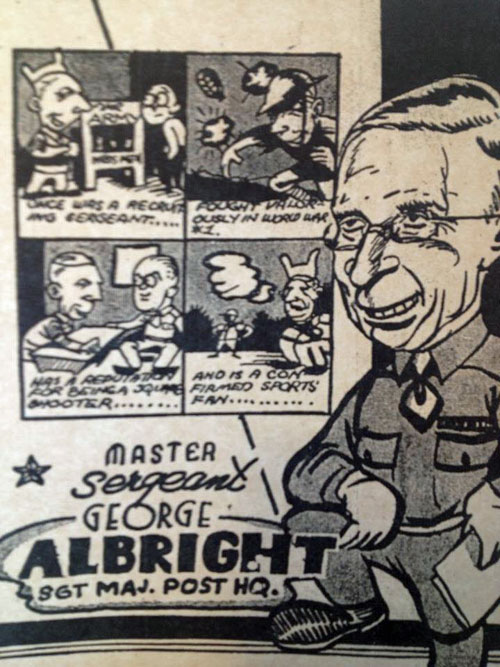
In 1943 Master Sgt. George Albright of Mt. Vernon was a sergeant major of post headquarters at Camp Gordon Johnston, Florida. Located on the Gulf of Mexico, 50 miles southwest of Tallahassee it was one of the nation's top centers for training in amphibious warfare. The cartoon appeared in the camp newspaper, "The Amphibian."
D. L. Scholey Retires After 52 Years.....1943
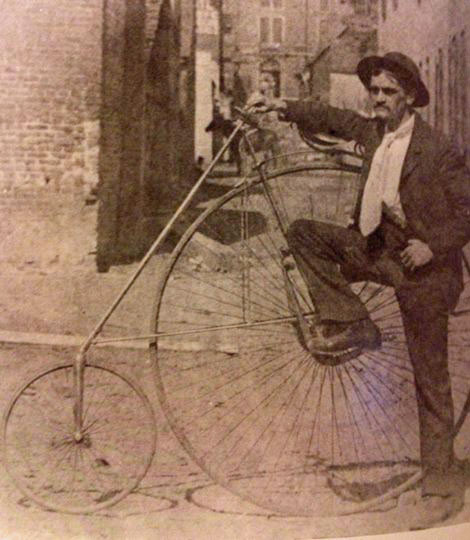
After operating a laundry in Mt, Vernon since 1891, D.L. Scholey leased his business on West Second Street, between College Avenue and Mill Street to Theodore Schmidt of Evansville. The business started in March 1891 with J.T. Fogas as a partner. The laundry at that time was in a building later a shoe shop. He then moved to the building just north of the former electric light plant on College Avenue. It had been erected for Scholey by Braddock McGregor, who was then in charge of the electric light plant. After a few years, Scholey purchased the lot where he stayed the rest of his work career. New machinery was purchased and it did a good business. They cleaned clothes for the L&N railroad, hotels and individuals.
Sgt. "Dutch" Season Sensational!......1943
The season record of Sgt. Alfred W. "Dutch" Wehr of Camp Crowder, Mo., formerly of Mt. Vernon, in baseball was fantastic! The tall slender redhead won 17 games while losing only 2 against some of the toughest competition of his illustrious baseball career. His 8th Regiment "Green Waves," recently won the post baseball championship for the second straight year and had a record of 23-7. Wehr's record is even more outstanding in the fact that the ace of the staff was to be Jeff Warren, former hurler in the Eastern League and had been hit hard. Sgt. Wehr had no professional experience whatsoever. Wehr would continue to pitch well during his military time, pitching and playing with many professional players including major leaguers. When he came home he was legend on the mound locally and a fine shortstop in semi-pro ball. Somehow he was never signed to a professional contract though rumors spread once of a Boston Braves contact. He was a good basketball player also, a part of Mt. Vernon's talented 1937 team. At Camp Crowder he played on an undefeated team there and in one game he was lauded with compliments for scoring 13 points in a 39-36 victory over Joplin Missouri Junior College.
"What's that sound? Everybody look whats goin down".....1943
It was early spring during the great war and a Mt. Vernon family on the edge of town retired for the night and they heard the hum of a motor, which sounded like that of low plane hovering around the city. They could hear it approaching and then suddenly departing, and at the same time a light flashed into the bedroom....the man and his wife got out of bed and went to the window and peered into the darkness, but could see nothing out of the ordinary so they went back to bed. Hardly had they hit the sack until the same thing happened again....and once more they got up to "see what was all the clatter"....with the same result....nothing! A third time the couple got up, looked out the window and still unable to ascertain the cause of the flashing of the light and the hum of the motor. They gave up, "called off all bets" and retired for the evening. The next morning, inquiry in that section of the city revealed that Marion Haas had plowed a small section of land in that neighborhood after dark, using a tractor on which was a headlight.
Ex-Sheriff Goes for a Walk and Buys a Hog.....1943
"Uncle Nick" McFadden walked all the way to town from his farm in the Savah neighborhood...I don't know why, but he did no "thumbing" and stated he made it in "race hoss time." Coming into the Western Star newspaper office he told about buying a hog from "Jude" Alexander. When he was asked how much it weighed, "Jude" said he'd guess at it and his guess was 199 pounds..."Uncle Nick" put the hog on the scales and the pointer stopped at exactly 199 pounds after which he told his neighbor that he was "pretty good"...to this "Jude" replied, "If I had known that, I would have done much better."
"Kids Say the Darndest things!".....1942
Like the old Art Linkletter and Bill Cosby shows of the past, children often amuse we elders with bright remarks. This story during the war happened when the parents of the home were absent and had placed their three and one half year old daughter in the hands of the grandmother. The little girl was tucked into bed and the lights turned off. Shortly afterward the girl insisted that the lights be turned on...and the grandmother insisted that the lights be turned off. Finally, the grandmother asked the child why she wanted the lights on after she had gone to bed for the night, whereupon the child replied: "Oh, I'm getting damned tired lying here in the dark trying to read this comic book!"
Battery E Activated.....January 1941
Battery E, Mt. Vernon's National Guard composed of 77 men and 4 commissioned officers has been ordered into the regular army and was scheduled for a year in camp. The Mt. Vernon Democrat set up a Battery Fund to be used for a mess fund to provide extras on the menu for the men that their pay would not provide.
Demolition of Part of Rapp Homestead Yields Wine Cellar.....1941
As workers eagerly tore down the western wing of the old Rapp home in New Harmony people watched in interest of what might be discovered. Some said there was an underground passage way between the residence and the old fort. What they found was a wine cellar. The entrance had been sealed and was found from digging from above. It was a small space only 3 feet by 5 feet. Only an empty broken bottle remained. You would think that the Rappites when they sold out to Robert Owen would have left one good bottle behind, wouldn't you? This was not you daddy's Boones Farm wine. Lots of their wines were wild grapes. In 1826, Prince Carl Bernhard of Saxe-Weimar Eisenach visited the cellar beneath George Rapp's home. "They let me taste a very dark and strong wine which was prepared from wild grapes which were grown on an island in the Wabash. They said you couldn't drink it the first three years because of its bitterness. After a barrel aged 8 years it got better." This wine was sold in Shawneetown. No wonder those boys have such a rough reputation! They say the Harmonists when they left town took all the good stuff with them. When they moved on to their next experiment, a British geologist, George Featherstonhaugh caught up with some of the New Harmony brew that by now was over a dozen years old and said, "Such a murky and distressing cordial, I certainly never tasted before." I had some of their dark beer last summer using an old recipe from the Rappities, and one gallon of it was all I could down.
Not 'P.C.", but Fanciful Imaginative Phrases From the 1940's...
A funny Facebook friend of mine told me her husband attended Mt. Vernon schools; I guess it was in the 1940's. Neighborhood children would walk to school back then in groups, "flapping their lips" on the way. Some of the older boys would be "doll crazy" and would be flirting with the dreamboat that might be with them. The small children were looked after by the oldest. Everything was peachy keen I guess usually. When the group approached St. Matthews School the public school kids, "The Pup-Licks" said Hi-de-Ho to the Catholic kids or as they called them, "the Cat-Licks." I lived on West Eighth Street during much of my elementary school days of the 1950's and I remember walking to school, shuffling in the leaves of the old neighborhoods on brick sidewalks, smelling the burned piles of leaves. We would pick up buck-eyes near Hedges Central and observe them during recess. Hedges was a great school back then. This old geezer enjoyed very much his youth. Yo-Yo's and Jacks and Pick-up Sticks....third string Kitten basketball player, patrol boy, the smell of lunch in the barracks, and stepping on the toes of a pretty blonde in square dancing that set me back socially for another decade....LOL..."dang nabbit!"
A Dollar For Life To Tell Your Boss To "Shove It.".....1940's
Was told this story today of a man named Charlie Foster who used to sweep out the Vernon Theater after each show and was paid $2 per week by the owner. One day some men were talking to Charlie and asked him what his wages were...when told, they thought he was getting a raw deal. They told Charlie that if he would tell his boss to "shove it," they would pay him $1 a week for life from all four men. And he did! One of these men was "Smokey' Rainey's father and they kept their bargain for almost 40 years. Each Friday he was paid.
On the banks of the Wabash, far away.....1940s
In his 1940 book, "The Wabash," author William Wilson said, "Down in Gibson County, the land grows even richer and the landowners of Princeton and Patoka are experts in agriculture, while, finally, in Posey County, the soil is the richest of all. There, in the soil accumulates the deposits of the full stretch of all the tributaries, Posey is blessed."
1940s Lawmen
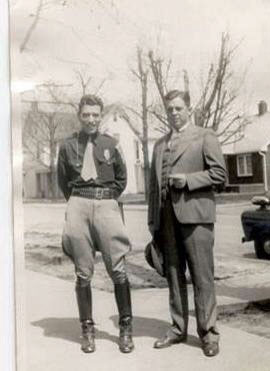
Pictured here are two great men of law enforcement: Willard "Lefty" Walls of the State Police and John Haney McFadden, Sheriff of Posey County. This was taken about 1940 in front of the old jail. Both men were courageous, fair, just and of impeccable integrity. Lefty went on to be Superintendent of the Indiana State Police and Haney as probation officer for Posey County. Haney followed two uncles as sheriff, James McFadden and Enoch "Nick" McFadden. In later years he was followed by his nephew Bill Cox who had a distinguished career as sheriff.
1930's
90 Year Old MV Boat Captain Interviewed About MV Wharf.....1939
Captain Nelson was interviewed about Mt. Vernon river traffic as a young man in the Evansville Courier......"the scene is of great animation. Dozens of large steamers were almost constantly tied at the local wharf and produce of all kinds covered the levy and adjacent streets. Smaller boats collected pork, grain and provisions from the smaller rivers and towns on the Ohio and brought them to Mt. Vernon where they were transferred to larger steamers, loading for St. Louis, New Orleans, and other southern cities. The deck laborers in those days were largely Irish. They were physical giants and much loved by the officers." Captain Nelson said many times he would have pitchers of liquor brought up from the lower deck for the deck hands working so hard. Today we may not have drays lined up with bales of produce waiting for steamers, but we still are a great port with Southwind Maritime Center and all the petroleum going out from the refinery.
Catching 'Possum.....1938
This hunt reminds me of a Keystone Cop comedy of the old nickelodeon days. What was then a Mt. Vernon suburb residence had a critter problem that involved three ladies, a boy, an opossum and an hour's labor. For some time chickens had been missing from the flock, I guess they are called flocks....anyway, they discovered the cause as the 'possum was seen going under the hen house.....so the women (and the boy) began the most futile attempts to oust the animal....stones and dirt clods were thrown, he was prodded with long sticks and a baseball bat, but he resisted arrest. Finally, one of the women conceived the idea of shooting the animal....and so sent the boy after his air rifle. He loaded the barrel with BB's and was instructed to be careful. "Don't shoot your eye out!" The animal's hairy hide was so tough he might have just as well been wearing armor. The attackers fell back to regroup and the 'possum was getting tired and attempted to escape. He ventured out from under the hen house and one woman slapped a board on the tail and the other women bludgeoned him to death. Then to receive some compensation....they sold the marsupial for 15 cents.
The Formation of Six Man Football and the PAC.....1938
Former head coach James O. Baxter wrote in the Mt. Vernon Democrat about the origin of the PAC in 1970 when the Wildcats moved Football and Track to Memorial Field from Athletic Park. Mt. Vernon had played football off and on as a varsity sport as a 11 man team going back to at least the 1890's. We had an undefeated team in 1908 and a winless team, I believe in 1930. As a matter of fact we didn't even score one season. We played a game in 1926 where we beat the Bosse reserves and the attendance was 30 spectators. We once lost to Princeton 105-0! I talked to George Ashworth who played on that team in the 20's and he said, "We started punting to them on second down looking for field position in the second half." We lost to Owensboro 86-0 and Harrisburg 87-0. It wasn't pretty. During the depression football was dropped and in some years fall baseball, at least county baseball was played until basketball started. Stoy Hedges was named MVHS principal in 1937 and in the same year George Ashworth came home to teach. Those two, along with Boonville High School principal, Alfred Bennett contacted area high schools of less than 500 enrollments to see who might be interested in football that didn't have the finances for the 11 man game. Informal talks continued into the 1937-38 school year and on March 14, 1938 a meeting was held in Boonville and the Pocket Athletic Conference was organized. Charter members were Cannelton, Dale, Boonville, Mt. Vernon, Rockport, Owensville, Winslow, Tell City and Poseyville. The first game in the conference was played here at Athletic Park, September 9, 1938 with Mt. Vernon downing Poseyville 33-18. 300 spectators were reported. Mt. Vernon finished 3-4 their initial season.
Wilfred Phillips' 7th Grade Story.....1938
Wilfred Phillips passed away this past week at age 87. He was a World War II veteran with a Purple Heart. He taught me Algebra back in 1963-1964 and was a fine Christian man. I ran across a theme paper he wrote in English class in October of 1938 when he was around 12 years of age. "One night my mother and dad went to Evansville. Instead of going with them, I went to the show. After the show was over, I went home. I pushed and pushed and pushed on the door, but I couldn't get it opened as I was locked out. So finally I gave up and lay down in the porch swing and went to sleep. Time passed and while sleepwalking I was able to open the door into the house and woke up!"
Seventh Grader Remembers Disappointment of Summer of 1938
Martha Thomas was a child and her family was expecting visitors to arrive at noon one summer day by rail. The family hired a man to mow the lawn, cut the hedges and general cleanup. Martha and her sister were busy trying to prepare a dinner as their mother had been temporarily called away. Martha recalled she was more of a hindrance than help. They were trying to make candy and Martha burned her finger. After getting it wrapped up they heard the twelve o'clock whistle blow and soon afterward the rumbling in the distance of the train a coming. As fast as they could, she raced to the depot, and was there just in time to see all the passengers getting off, but the girls they were waiting on were a no show. They watched until the conductor called, "All aboard," and went home disappointed that all their work and expectations were for not.
Hovey...1937
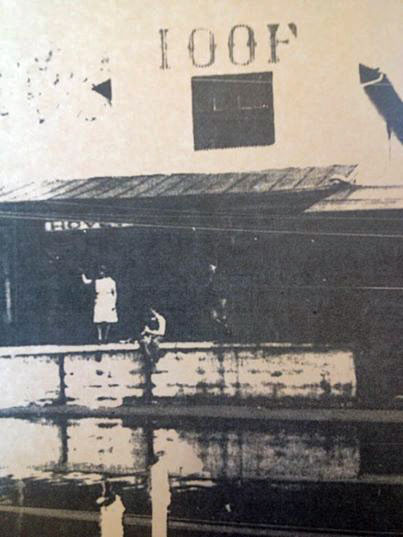
J.C. Buchanan and Glenn and Kenneth Curtis on porch.
Posey County Court House.....1937
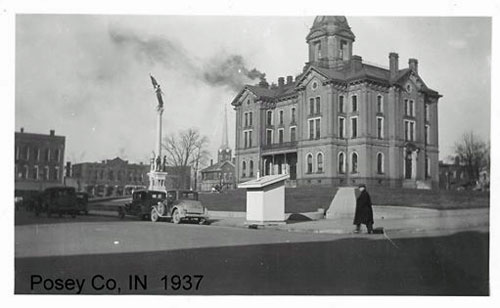
We no longer have chimneys, so I like this one from 1937 with the smoke coming out. Only one I have ever seen like that.
Aviator Escorts FDR.....June 1936
Dave Alldredge, Mt. Vernon's only flyer was one of the air escorts for President Franklin Roosevelt when he came to Vincennes on June 14th. Alldredge piloted his own plane and joined a number of others who met the President's train at Terre Haute. FDR addressed the crowd at the George Rogers Clark Memorial at its dedication. The President spoke on many subjects, history of Vincennes, the western progression, morality, our great resources and how to maintain them, inventions, and the duty to maintain and preserve our nation.
Hurley Grocery.....1936
From 1911 to 1936 George Hurley grocer, dairyman, and livestock farmer operated a grocery store at 1000 North Main Street under the name of George Hurley & Sons.
Memorial Coliseum Revival....1935
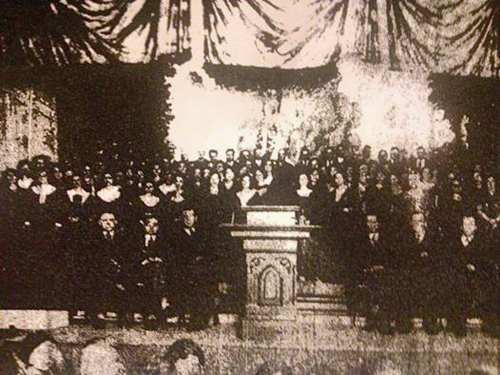
The auditorium once held 1100 people and the stage was used for all sorts of gatherings like union meetings, minstrel shows, queens crowning, homemaker demonstrations, variety shows, boxing matches and religious meetings.
Rockport Historian Believes Lincoln Spoke in Southern Indiana Says Newspaper of 1935
George Honig was a Rockport native, sculptor and Lincoln historian and he may have discovered a piece of local history invaluable. A four page Rockport newspaper, called the Indiana Herald of November 1, 1844 says that Abraham Lincoln came to Evansville and spoke in favor of Henry Clay for president. The account of Lincoln in Rockport is as follows: "Mr. Lincoln of Springfield, Illinois addressed a large and respectable audience at the courthouse Wednesday evening last upon the Whig policy. His main argument was directed in pointing out the advantage of a protective tariff. He handled the subject in a manner that done honor to himself and the Whig cause. Other subjects were investigated in a like manner. His speech was plain, argumentative and an hour's duration. When he closed, Mr. John Pitcher (who later lived in Mt. Vernon, a judge of the district court, father of General Pitcher, etc. etc.) arose and delivered a speech in his forcible and powerful manner." It said Lincoln was on a speaking tour of Posey County at the time of the article a week later. Records show that he spoke at Buffaloville (near Lincoln City), at Jonesboro (near Gentryville), and at Rockport. From there his itinerary becomes a matter of speculation. Honig's idea is that Lincoln left Rockport for Boonville to speak for Clay, and this belief is held because Boonville was the home of John A. Breckenridge, of whom Lincoln knew in what became Lincoln City. Lincoln was apparently in Boonville the last day of October, and it is presumed he spoke in Evansville on November 1. Pitcher was again mentioned in Evansville and Honig believes that is significant. He writes, "Pitcher, besides being a judge, was one of the first postmasters at Rockport. Lincoln had also borrowed books from him." Honig believes he left Evansville for Posey County before returning to vote in Springfield, Illinois on November 4.
The Death of "Mr. Phillips," as Told By Glenn Curtis.....
I'm so sorry I can't do his story justice, but I will try. Glenn and my Uncle Johnny Kessler worked for Mrs. Buchanan at the Hovey Store in Point Township back in the 1930's. They made a dollar a day, seven days a week. Glenn and John were cleaning windows in the store one day and the Buchanan's had this canary,"Mr. Phillips" and he was chirping away. John and Glenn took their towels and started flipping them, snapping them at the bird. They got a little carried away and the bird was killed and laid upside down, feet to the sky on the bottom of the cage. The boys cleaned those windows perfect that day and all their chores. Come feeding time for the bird and the changing of the cage newspapers, Mrs. Buchanan seen the bird was dead. Glenn and John looked too, like it was a complete surprise. Well the Buchanan's lived across the street from the store and they put the bird in a match box, got a shovel and had a funeral. About that time, Al Blubaum, future mayor drove in for gas. He always made cash payment. He asked, "Where's Buchanan?" Glenn pointed across the street and here was the family standing over the hole silent in prayer. Glenn said they never knew what really happened to their bird. They said also that once, John and Glenn were in the back of the Buchanan vehicle when "Buck" reached into another match box to get his chewing tobacco. The boys had put cayenne pepper in it. "Buck" reacted bitterly and the boys were afraid they would be fired right then and have to walk back to the store. That didn't happen but they had to sweat out a possible firing and the quiet ride back to the store.
MV Film Actress Ann Hovey.....May 1932
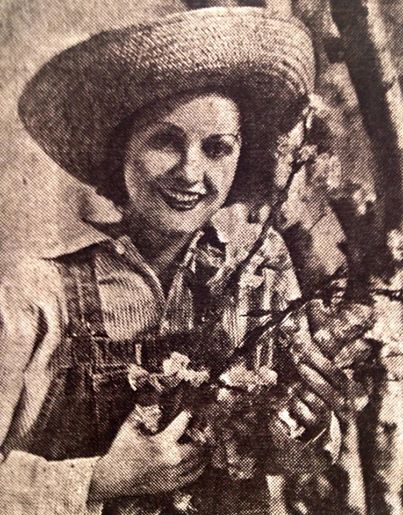
Father was Dr. Alvin J. Hovey, dentist in Mt. Vernon for 40 years. As I recall she had one western towards the end of the 30's.
"RAYMONDE the WHITE PROPHET".....April 1931
That spring for four days this "master of occult science" did shows at the Vernon Theatre. His ads in the newspaper, "The Western Star' were full of mumble-jumble of marvelous feats of thought transference. He seems to have done his "tricks" prior to the regular features. No follow up coverage was provided, but he advertised that on his last performance he would drive an automobile blindfolded down Main Street and make a turn on Water. I guess he made it. After all, he claimed to "know all and see all."
State Police Ticket 50 In Mt. Vernon in One Night.....February 1931
State Patrolmen didn't exactly make many local friends on a Tuesday night when traps were set up to catch those cars with only one headlight, and no tail lights. A state wide campaign was underway to eliminate from highways automobiles without proper lights. A few bottles of "shine" confiscated didn't help matters either.
Old Show Boat, Known Here Dismantled in Cairo....1931
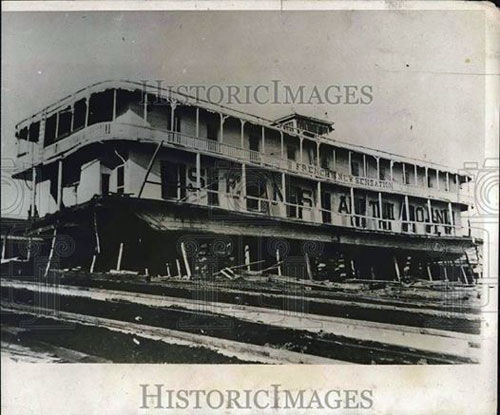
Old time river men and theatre patrons were silently shedding a tear and swallowing a lump in their throats when they learned that the oldest show boat on the Ohio River, French's New Sensation had sailed its last voyage. Word was received here by native professional trouper, G.W. (Biff) Carr. This old boat had been plying the waters in the Central West for nearly 75 year bringing many fond memories with its floating theatre. One of those expressing regret was Mt. Vernon veteran show boat calliope player, Ernest Albright.
American Legion Auxiliary.....December, 1930
In December of 1930 the Owen Dunn Post of the American Legion in Mt. Vernon met to form ladies auxiliary. Twenty-five eligible mothers, sisters, wives and daughters of legionnaires held an organizational meeting at the Coliseum.
Wabash River Flood Around New Harmony.....January 1930
During late December, snow accumulation of around six inches locally combined with up to 18 inches in the upper Wabash started to melt with a large run-off with already rising streams with higher temperatures in January. Rains came and flood stages were present along all the Wabash proper during the first six days of the new year. Large rainfall fell with up to 3 inches of rain on the 14th. The flood was less than the great flood of 1913, but the ice gorges were worse, one of which was at Mackey Ferry, south of New Harmony. Airplanes were a constant sight over the frozen Wabash and its flood waters aiding in the relief work for residents marooned and delivering supplies.
Aged Fisherman Crushed by Runaway Rail Cars When Chock Removed....1930
Henry Durham, 70, once resided at his home on the west bank of Mill Creek until one afternoon he was struck by three rail cars of the C & E. I. Railroad. The old man was trapped on the trestle over the creek just a few feet from his home. The three cars were moving uncontrolled down a slight grade from the Mt. Vernon Milling Company. It is believed that Henry saw the approaching cars and he attempted to run across the trestle in front of them. They think he slipped and fell, his body falling between the rail and the heavy outside trestle beam. After running over him they continued up the slight grade just west of the trestle, then returned back by gravity and ran over him again. They believe his death was immediate....hopefully as he was dismembered. The accident occurred when workmen unloading a car of coal at the mill removed a chock in order that the car could be moved a few feet further west. It got away from them and all efforts to rechock it were futile. The coal car humped into two box cars partially loaded with products of the mill and the three ran uncontrolled. Mr. Durham was survived by a wife and two children. Funeral was held in relative's home and burial in the Greathouse Cemetery, west of town.
Defur & Son Paint Store.....1920's and 30's
Born in 1875 near Wadesville to parents of French ancestry, Kelly DeFur, learned many different jobs in Robb Township including that of a machinist, a clerk, and a hardware store partner. When he moved to Mt. Vernon he soon became identified with the Hurley paint store. Kelly purchased it in 1925 and changed the name to DeFur & Son. The son was Dale. Kelly also was clerk of the Posey County Circuit Court for eight years, a Mason and an Elk. An outstanding community leader, he was always at the front of any progressive movement for the advancement of the town. He was an ardent democrat, but always said, "I can still express pity for my poor republican friends." DeFur later became Redman Paint Store at 224 Main Street.
"Liquor" Proves Downfall of Posey County Spellers.....1930
Well, who is buying them booze? Nobody, it was just the word that seemed to be troublesome to spell for elementary students in a township spelling bee, according to Posey County School Superintendent Phillips Blackburn. Other words found difficult were bicycle, scissors, picturesque, appendicitis, kindergarten and sleigh....`~ Wavy knows how to spell liquor, but I can't drink much of it.
New Product at Staples Foundry.....1930
Lawn furniture made in three pieces, two chairs and settee were the new articles manufactured by the local foundry in any color. Twenty initial sets were made for ready sale. For advertisement, Mr. Staples had a Ford coupe equipped to carry a set of the furniture with Vernon Sills in charge of sales. The Ford car was painted with ads that were to attract the attention of the local public.
Counting Cars at McFadden Creek Bridge.....1930
Two Mt. Vernon gentlemen of leisure, Lloyd "Freight" Lilleston and Arthur "Jack" Watson while partaking of the sunshine on a Sunday morning broke the monotony by strolling out to the McFadden Creek bridge on the paved road heading to Evansville. Wearied by their exercise they mounted to the top of the bridge bannister to let the world go by. After a few minutes and probably a few cigarettes they deemed it necessary to employ their time into something useful. Thus, they began to count vehicles and after one hour they had annexed the total sum of 307 and one two- horse wagon. We don't get much inside reporting like this anymore do we?
Granddaughter of MV Couple Made 5 Films in Hollywood in her Teens....1927-1930
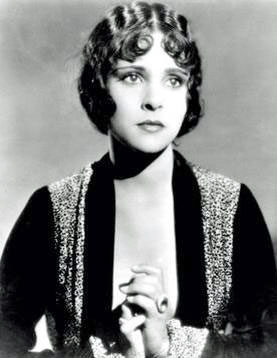
Dorothy Janis, was born in Dallas, Texas and was the granddaughter of Sarah and Edward Mann, former Mt. Vernon residents. Born in 1912 she lived until 2010. Dorothy had an aunt here too by the name of Mrs. Sylvanas Barnett. Dorothy's real last name was Jones. She was in several Photoplay magazine issues of that time. Her career consisted of five movies only one was a talkie. In late 1928 her picture "Kit Carson" played Mt. Vernon.
1920's
100 Odd Fellows Eat Rabbit.....December 1929
One hundred members of the Mt. Vernon lodge of Odd Fellows enjoyed a rabbit luncheon at their hall with animals being prepared by a committee of Henry Bray, Charles Crowder and Bertus Blackburn. I wonder if it was fried rabbit or rabbit in mushroom gravy or shredded rabbit, maybe even rabbit cacciatore. Whatever it was I am sure it was "Hoppin' good! The 25 rabbits were killed and donated by members of the lodge from Eastern Black and Marrs townships.
D.C. Writer Stops in at Coliseum and Praises Antiques.....November 1929
Before we were robbed, the Posey County Historical Society tried to form a Posey County Museum within the Memorial Coliseum. Washington D.C. published author, Paul Wilstach stopped by in route to historic New Harmony. He was said to be very pleased with the antiques we had on display and was especially impressed with two volumes of the London Chronicle that were highly praised by newspaper editor JohnC. Leffel of the Western Star. Those books Wilstach said were such a rarity, dating back to 1799 and "they should be in the Library of Congress, as the information is of unusual value to the world." Wilstach was a friend of our congressman H.E. Rowbottom, a Republican. Rowbottom was employed as a clerk in Evansville for the Indiana Refining Company before being elected. Unfortunately, in his last term ending in 1931 he was convicted of accepting bribes in exchange for appointments to the U.S. Post Office.
First Car Equipped With Radio Seen by Locals.....January 1929
A Dodge Brothers senior six landau coupe created quite a bit of interest on First and Main Street at the Hartmetz Brothers garage. On display was a car with a Transitone radio. How 'bout that?
Hotel Gets Barber Shop.....1929
The hotel on West Second Street went through an extensive improvement with a large room on the east side of the building converted into a barber shop of three chairs. The Utley Hotel, owned by Mr. and Mrs. Noble Utley had two barbers-Fred Marquis and Ed (Jim) Ashworth. Noble said he would assist during the rush periods. So, there you go....."You're next."
Methodist Church Youth Group from Mildred Blake's Memory Book
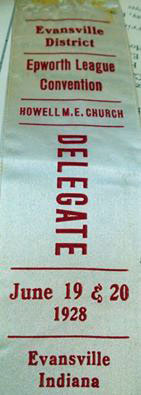
Notes From a MVHS Memory Book of An Old Football Game of 1928
Mildred Blake kept a memory book of her school days that recounts musical concerts, plays, basketball games, and her life in general as a teenager in the 1920's. I ran across the autograph section and a classmate named Bud Herring had a note about a football game that year. (By the way, we were playing eleven man in 1928). " Dear Mildred, I will never forget that game. It was our first victory we ever won. Fought like dogs that day. I can remember it well because I got my nose smeared all over my face."...Bud. Oh, the game in question was a 26-0 win for the then Mt. Vernon Mountaineers over Crossville.
Student Party Handout of 1928 Brings New Terms to ~Wavy
I got a glimpse of an old paper handout, maybe a carbon copy of a faded school party in 1928 at the high school. It was called a Joker Party. The advertisement appealed to the girls that "every red-blooded he-man" would be there. Had drawings of people with those little "bubble thoughts", like "I am coming!" and "me too!' They had this one drawing of a boy and a girl on what must be the gym bleachers with arms around each other. "The caption said: "NOT ON THE PROGRAM"...."rag-chewing, necking, and bunk fatigue." Now that is sort of interesting to me. I know what necking is....came late in adolescence, but I know what it is. Now "Rag-chewing," ....I had to look that one up in the Urban dictionary. It says a ham radio expression of a long conversation over 30 minutes. Hmmm. I guess they wanted the students to mingle or not pair off, thus necking and that last one..."bunk fatigue." I see where this is going and so as I search Daniel Webster's dictionary (my one from high school) I find that it meant "resting or sleeping in bed especially during the daytime." I thought it might be something like XXX, but maybe it was directed at we wall flowers and loners not to fall asleep.....Think I'll pop Jo-Jo and I some popcorn. Remember when you did this in an iron skillet and had to shake it?...Oh, never mind.
Hoop Pole Junior from November 1927
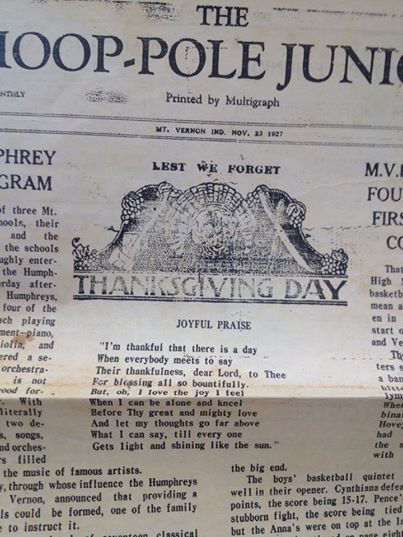
The usual found in a school newspaper. One article was "Mice Beware!" It said the school was in need of a Pied Piper. Mice had got into Mr. Pence's assortment of bugs and insects and he was overwhelmed with grief, sadness and anger. He said if he catches them he will skin it and dissect it alive.
1927 High School Program Listing Anna Hovey, Future Hollywood Actress of 1930's
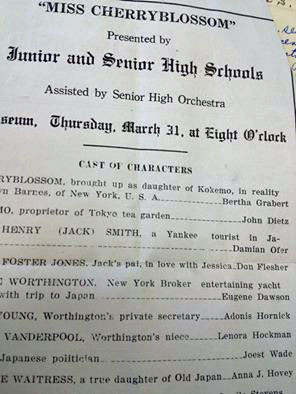
Huntingburg Main Street Gym.....March 12-13, 1926
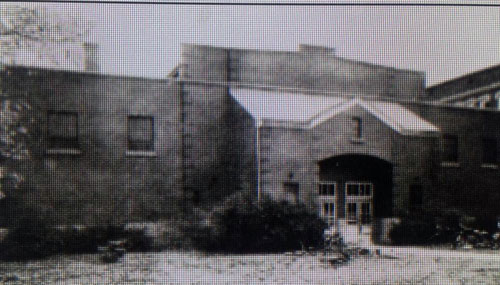
On March 12-13, 1926 the First Post Season Girl's Basketball Tourney in the State was Played. Mt. Vernon Defeated Reitz for Mythical State Championship. Our Champs were 18-1 that season and 36-1 over the past two seasons. The 12 team invitational had Mt. Vernon giving a bye then defeating Boonville before defeating Reitz 11-7 in the lowest scoring game of the season. It was tied at 7 with two minutes to play. Over 1000 fans were in attendance. The team was given a beautiful 14 inch loving cup and each girl was given a flower. The Mt. Vernon fans presented the team with a flower basket with a note: "Our team, may they ever win, but win or lose, our team.:...The fans. MacGregor, Gill, and Watkins were selected first team Mythical Sectional All-Stars.
At the Vernon Theater ..."The Quarterback". This is an original handbill from 1926 of the romance comedy.
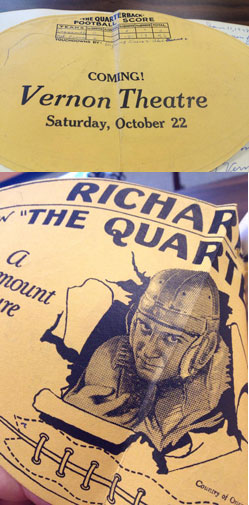
I believe these were handed out at the high school game because the box score above was filled out. The bill was in the shape of a football. Again this is from Mildred Blake's memory book. Sometimes someone's past is our community's past. If you have something of interest that is part of our county's heritage, I urge you to donate items or pictures to the Posey County Historical Society, the Library, or let me photograph them so we can all recapture a moment in time and preserve it for others yet to come to see what preceded them.
KKK in Mt. Vernon during 1920's
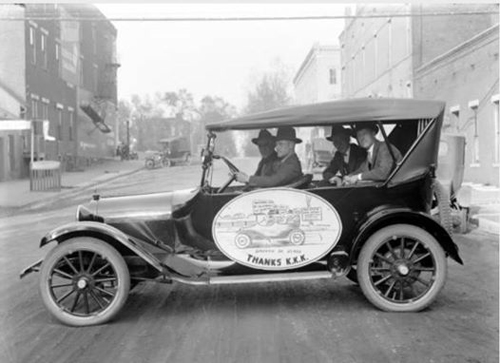
This view is looking up from West Third Street. On the right is what is now the Performance Group and what was once Robison's Men's Wear. Across Main was the Kahn Hotel. On the left we see the building that once was "The Greeks" and past the public square is the old Court Hotel or Bishop's that preceded the building of the Post Office. Becky Higgins figured out the location and I went to the spot and positively identified the buildings. Believe to be a Jones photo once active in Mt. Vernon. It was estimated from a site I saw once that membership in Posey was about 15% reaching over 30 in some places up state. Klan sometimes toned down their rhetoric claiming to just oppose "everything indecent." It was sort of a populist organization in Indiana at that time they wanted us to believe. Members have said they wanted "to revitalize civic unity and uphold traditional religious and moral values." Blacks were relatively few in the southern part of Indiana so the rhetoric was aimed at others whom they thought was threats to social changes that they didn't approve of. The 15% comes from a book, called, "Citizen Klansmen" written in 1991 about Indiana during the period of 1921-1928 by Leonard Moore.
MV Library.....c1925
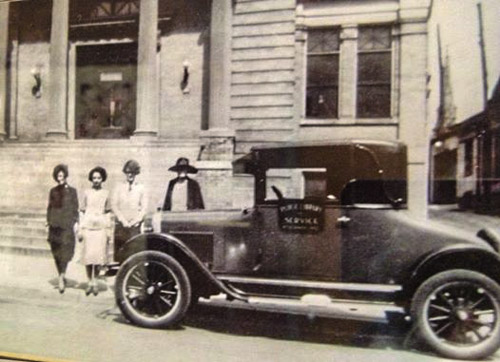
Service Shoe Shop.....1924

Homer Shaw and Garl Munsell were the owners of this shop for a couple of decades starting in May of 1924. They were WWI vets that were injured in the war. Shaw was gassed and Munsell was injured from shrapnel from machine gun fire. Returning home they were unable to return to their former jobs so the government placed them in training to learn the shoe repair trade and they located right up on Main Street between Third and Fourth.
1924 Lady Champs of Mt. Vernon Necklace
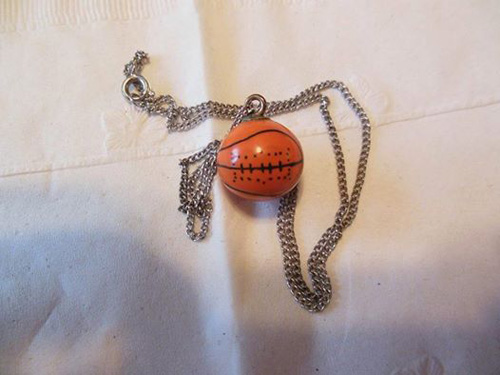
In 1924 this necklaces like this were given to the 1924 Lady Champs of Mt. Vernon who went through the regular season unbeaten against other schools...then losing in a challenge game to Sullivan. This belonged to Veryl Stallings who three times that season scored over 30 points with a high of 41. The necklace now belongs to Jo Bulla. Thanks for showing us Bob and Joe.
Modern Woodman of America Fish Fry...circa 1923-1925
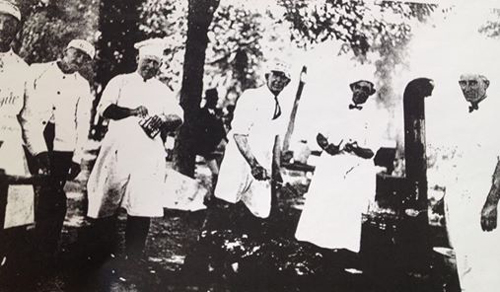
Joe Alldredge, Al James, Bazil Mentzer, Aaron Litchenberger, Horace Greathouse, Sr., ?
Emancipation Day Celebrated At Black's Grove....September 1923
On September 22, 1862, Abraham Lincoln issued a preliminary proclamation which required all states to abandon slavery within 100 days. "Thenceforth and forever more free." The Emancipation Proclamation went into effect January 1, 1863. In Mt. Vernon, Hubert Butler's brass band marched to the Black's Natural Park for a picnic. A barbecue and picnic were held in celebration, under the auspices of the Walden Lodge F. & A. The committee in charge included P.W. Bishop, Sam Anderson, John Wesley, Emmitt Pippin, B.F. Ramsey, Hubert Butler and Esley Caldwell. In the afternoon an address was presented by Sumner Furniss of Indianapolis, one of the leading "colored" Masons in the country. During the concert the crowd was treated with two sheep and one hog that were barbecued. Furniss has a lodge in Indianapolis named after him to this day. He was an African American physician, born in Mississippi in 1874. He became the first member of his race to practice at the City Hospital in Indy. He had a general practice later for 50 years. In politics, the Republican became only the second ever African American in the City Council. His brother was also a doctor and during the McKinley administration was minister to Haiti.
Employees of Mt. Vernon Steam Laundry taken in 1923.
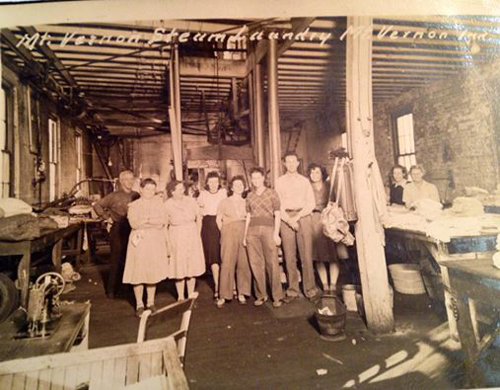
Owned at operated by Dave Scholey and his wife. Those identified are: Ed Hassler on the left, third is Beulah Hames, and fourth is Geneva Cotner. Photo was shared with us by Jim Rainey. Editor note, date perhaps too early as Beulah Hames was born in 1907 as reported by Ray's cadre of research fellows.
Local Merchant Dies Suddenly.....1923
Jarodzki, died of diabetes at his home at the corner of Fifth and Mulberry that fall. A native of Brumberg, Germany he came to America at age nine with his parents Louis and Sara and four years later they were living in Mt. Vernon. Louis got work at the dry goods firm of Rosenbaum & Bro. and within a short time other members of the Jarodzki family settled here. Louis started his own mercantile establishment on the corner of Second and Main, once many things, but now a parking lot. In 1923 it was the Bryant Store. When Louis Jarodzki passed on, the sons Max and Otto continued the business. The brothers moved their store in 1887 to College Avenue and then to Third and Mill streets. Max was a member of the Israel congregation and the Knights of Pythias lodge. The funeral was held at the Jarodzki residence with Rabbi J.H. Skirball of Evansville in charge. His remains were laid to rest in Oak Hill Cemetery. Pallbearers were other prominent merchants: Fred Dietz, Otto Wellbrenner, Charles Rhein, Aaron Hartung, William Holton, and Charles Pearson. Many out of town relatives and friends came in as far away as Milwaukee.
Town Clock Repaired.....June 1922
Workman under the guidance of Clem Schenk completed repairs on the town clock in the steeple of St. Matthew's church. The time was said to always be accurate as it was set each evening according to radio reports received by Father Bauer on his "radiophone."
Doing a "Good Turn"....1920's
Thomas Underwood was a Mt. Vernon native who later made his home in Washington D. C. He related this story in the 1960's "A new family had moved to town and their eight year old daughter could neither hear or speak. The child next door, of the same age, was told to play with her even though other neighborhood children did not. At first he rebelled. Obedient, he went out to play jacks, hopscotch, and worst of all....house. Yuk! The days rolled by, summer ended, and the little girl went away to attend a school for the deaf. Spring returned, and on a bright sunny morning in early June, upon answering a knock at the door, there she stood with her mother. 'We have a surprise for you Johnny,' said her mother, as she gave an affirmative nod to the little girl her face wreathed in the happiest of smiles the little girl SPOKE, 'Heh-lo, John-nie, how -are- you?' Although permanently deaf, at school she had been taught to say a few words, and her greatest desire had been to speak the name of the boy next door. The reward was evident as tears poured down little Johnny's face. "
Any color you want as long as it is black.....1922
In 1922, a new Ford, "The Universal Car" costs Mt. Vernonites $348, born in Detroit to you at Keck-Gonnerman Company. Lichrenberger Sales has a Dodge sedan equipped with disc wheels. Give it a look and kick the tires.
"Dap-A-Dee's" Saloon & Hotel.....c 1920's
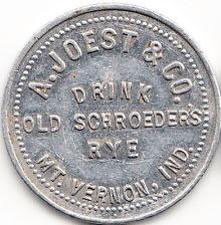
"Dap-A-Dee" and "Pappy Jiggs" were the nicknames of Charles A. Joest, 1870-1948. They say his real first name was Nicolas, a staunch Democrat merchant of Mt. Vernon. His home address was 315 East Second Street and I have his work address as 200 Main Street. "Pop" Fessenden described it as an early sports bar where men would come in have a few drinks and discuss the World Series or hunting. They say Charles was pretty fair on the piano. Rye whiskey and a piano song, maybe a banjo and....good times! He married Annabel Hayes of Mt. Vernon in 1895 and there were six children. He was in business some thirty five years and then he was buried at Bellefontaine Cemetery.
One Stop Shopping.....1921
In February of 1921, Rosenbaum & Bros. opened a modern self service cash and carry grocery department in the basement of the mammoth store.
Ramblers Club was A Great Friend of the Early Library.......1899-1921
The Ramblers probably existed into the 1980's or later. All of their meeting notes, and scrapbooks were at some time donated to the Posey County Historical Society. Many pictures in there of outings of the ladies at Hovey Lake and of newspaper clippings of the good work they did. I was looking today again of the first volume from 1899 into the 1920's. A postcard here and photo there of the old Alexandrian Library now City Hall. Back before the library was built they had a small room at the then City Hall and Police and Fire Departments. Many of the first books were donations of private collections and especially of Matilda Alexander. The Rambler's Club early on raised money for books too. In 1900 they brought in a lecturer by the name of Alexander Johnson to speak and three volumes were purchased from the proceeds for the coming library. A record of $50 in 1910 from a social and in 1921 a tea party cleared $75 for new books. We should never forget the good social clubs bring and the general public who support their fundraisers.
Flour in the day.....1921
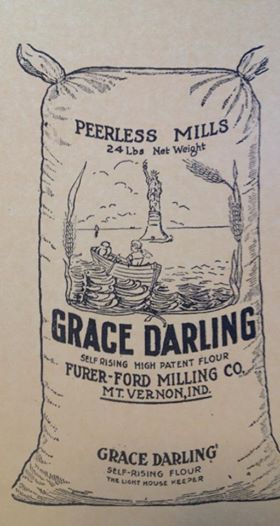
People's Bank Remodeled.....1921
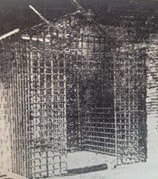
In April of 1921 the doors of People's Bank & Trust company were thrown wide open on a Saturday to give the town's people an opportunity to inspect the improvements made in the institution the past six months. Over 2000 visitors visited that day and evening. Large baskets of flowers and numerous bouquets added to the beauty of the interior compliments by the Mt. Vernon National and First National banks of the city. The officers of the bank, assisted by their wives received the visitors and conducted them through the different departments of the bank. The new burglar alarm system from Minnesota was demonstrated by Bob Olson, a representative of the company. Piano music was furnished throughout the day and in the evening Schenk's four piece orchestra played until a late hour. Souvenirs were given out to the visiting ladies and it was a grand success.
Western Star Editor Reflects on "Good Old Days".....1921
John C. Leffel was editor and publisher for 50 years starting in 1876 so he was well qualified to reflect on Mt. Vernon's past. Here is his column from August of 1921: "How many of the younger middle aged residents remember that at one time sufficient cotton was grown in the county to require a gin in Mt, Vernon? How many remember the time when a dozen flatboats could be seen in the bend of the river or at the wharf? How many even remember the palmy days of steamboating? The Old Pacific, the Missouri, Northerner, Southerner, Bostonia, Peytonia, Eclipse, Natches, Great Republic on which was published a daily paper, the Robert E. Lee, the Florence Lee, the Fannie Ward, North Star, Morning Star, Evening Star, Guiding Star, John Kilgore, James Howard, Thompson Dean, Thomas Sherlock, Mary Houston, or anyone of a hundred grand old side-wheelers such as the Charles Church and U.P. Schenk, the Granite State, Buckeye State, DeSota and Ohio? How many remember that there would be as many as three or four boats lying at the wharf at one time either taking on barrels upon barrels of potatoes, apples, or other produce or cattle and hogs, turkeys, geese and chickens for the up and down river markets? How many remember when the towhead began to form in front of the wharf and finally formed a pocket so that steamboats in low water had to land at the mouth of McFadden's creek, and in high water opposite Baker's Mill and Distillery or perhaps just above the mouth of Mill creek? Do you remember Haw Hill where the Baker Mill and the old Baker mansion stood, and where the military camp used to be? All have gone into the river years ago. The old magazine in the northeast part of town during the Civil War, the old Mt. Vernon hotel which afterwards became the Hominy mill, the old stage coaches that ran between Evansville, New Harmony, Uniontown and Mt. Vernon? Real old fashioned stage coaches too! Can't you hear the driver blow his bugle as he drove up to the public square? Do you know that there used to be a rope walk where Sherburne Park is now, and a Market house on Main street? Do you remember in the early 60's John R. Evertson sunk an artesian well to secure a water supply for his mill and that the pipe can still be seen in the hitch yard back of Rosenbaum's store and do you know that the water still seeps out along side of the plug? Can you remember farther back when the wharf was built? Do you remember the old Plank road to New Harmony? Do you remember the old covered bridge on Second Street across Mill creek? Do you remember the glorious board sidewalk and mud streets of our boyhood, and the games of town ball out in the meadow? Do you remember before we had a telegraph to say nothing of a telephone? The Good Old Days.....sometimes we kinda wish we had 'em back and sometimes we kinda don't. Ain't it the truth?"
How About A Little Labor Day Log Rolling in the Creek?......1920
An old-fashioned picnic and log rolling contest was held at Black's Natural Park in Mt. Vernon under the auspices of Posey Camp No. 3120, Modern Woodman of America. There was a district meeting and the private affair drew drill teams and Woodmen from all over the First District. Bring you axes and an oil can in case in rains.
Fourth of July.....1920
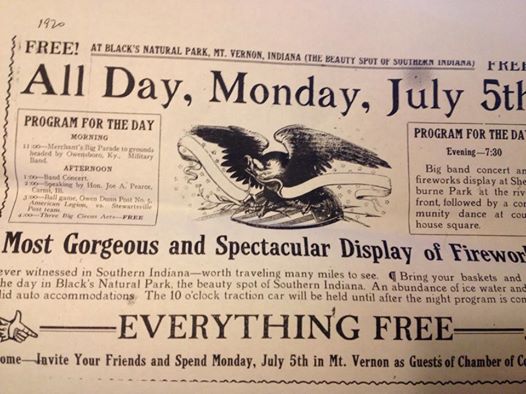
1905 MV Grad Becomes Indiana State Chairman of Prohibition Party......
Raymond Schmidt became Chairman of the Indiana Prohibition Party early in the 20th century. In an interview with "American Advance" at Prohibition Headquarters he declared: "There is every reason for rejoicing over the splendid outlook of the party work." He went on to warn Prohibitionists that the opportunity for great advance will be lost unless every friend of the cause helps to take advantage of the chance afforded by political developments. He put forth five suggestions of 1) Circulating literature, 2) Co-operate with State Executive Committees arranging county conventions and rallies. 3) Celebrate Independence Day in your community with a rousing Prohibition picnic, 4) Revive and Organize County, Township, and Municipal Party Committees circulating petitions, and 5) Organize Poling Marching or Boosting Clubs. During a Presidential Election in the 1920's, Schmidt came back into Indiana attacking the Republicans who circulated a rumor during the last hours of the campaign that Prohibitionist Party candidate, Aaron Watkins had withdrawn in order to gain votes. Schmidt called it, "one of the oldest tricks in the GOP playbook" and lambasted them for doing harm to his party at the eleventh hour. Reading the political plank of the Prohibition Party of 1920 I found that they also favored the U.S. entry in the League of Nations, and was in favor against militarism and universal military training. They encouraged universal disarmament and the devotion to the acts of peace. They advocated enfranchisement of women and that suffrage should not be conditioned upon sex.
1910's
Mt. Vernon Draft Resister.....October 1918
A local draft resister (name withheld) refused to register and when given a second opportunity, refused and was sent to jail to await a hearing. During this time opposition to conscription was only allowed to a small group of traditional religious groups. Many other resisters included labor and socialists and also political activists. It was during this time groups formed like the ACLU, the War Resisters League, the American Friends Service Committee, and the Women's International League for Peace and Freedom. Roger Baldwin, ACLU director for decades served time in prison for refusing induction in 1918. It is estimated that 3.5 million males refused registration during the First World War. Seventeen evaders were given the death penalty, but none were executed. For the first time the name "Conscientious Objector" became known.
Germany's Expansionist Ambitions Revealed at Dreamland Theater in MV....July 1918
The film, "My Four Years in Germany," was shown locally of the reflections of James Waldo Geralds, former U.S. Ambassador to Berlin 1913-1917, Slow to come around to reports of German militarism and authoritarianism, he eventually chided President Wilson for our neutrality. When 124 Americans lost their lives on the Lusitania he found Germany giving children a school holiday to celebrate its sinking. "I believe they believe (the Germans) we can be slapped, insulted and murdered with absolute impunity." He lectured on Germany throughout the war turning public opinion against the Kaiser. Tickets sold for 25 cents with a war tax included.
Postcard mailed in 1918
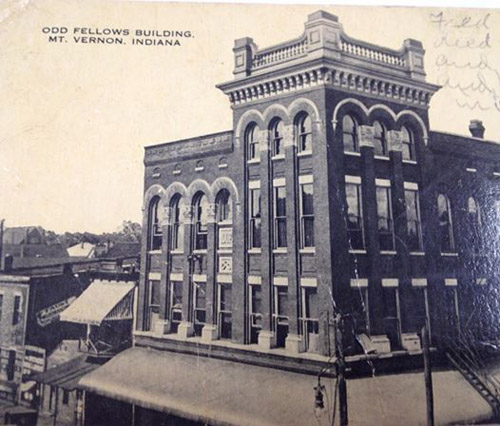
This is listed in the 1915 city directory 400 Main Peoples Bank, 402 Odd Fellows building, Odd Fellows Hall, A.J. Hovey dentist, W.E. Hastings office, Louis Pfister insurance, Frank Suddoth abstract and loans, and Miles Thomas township trustee.
They Use To Call Them "Aeroplanes" and Some Thought Them a Hoax.....1918
A plane flew over Marrs and Robinson townships at about 200 feet causing a lot of excitement. Pupils at one rural school became so frightened that they ran to their teacher for protection. An old man said there was some sort of secret trick to it, to keep it in the air; it had to be a fake. Many residents thought it was an invention against God..."Man should never fly, or try to fly, because it is sacrilegious!"
Memories of the Winter of 1918 in Southern Illinois....
Locally the winter was one of the worst on record with over 40 different days of snow, ice gorges and the destruction of many boats including the showboat, "the Cotton Blossom." It was the same in southern "Ellenoise." My aunt Nelia Frashier, collected articles from her life and passed some stories to me. I guess she saw the historical thirst in me. The story was a little town in White County called Centerville. Today a ghost town but back in 1918 it was a thriving little village with several general stores, a restaurant, barber shop, grist mill and several churches. The snow came without warning...not much of predictions in those days, one just had to be aware. The big snow came and this young man lived on the edge of town and he traveled to town on ice skates after the road was cleared and froze. A valley was between the boy's home and the town and the snow drifts were so high in the valley that only about six inches of the tops of telephone poles were visible. Freezing rain came afterwards and left a crust of ice on top of the snow. Skating parties were formed as snow was removed from pond surfaces. On a Sunday soon after a funeral procession traveled south to Grayville, the temperature fell to minus 23 degrees. It was so cold one person in the procession froze to death. The remaining members of the funeral line took lodging in homes along the road and had to wait another day or two to bury the body. The boy also saw one day looking out his parent's window, coming across the fields a woman walking and carrying a baby in her arms. As she got closer he noticed she was barefoot! She stopped in the boy's home to warm up before she continued on her way to the Pentecostal Church some four miles away. After she left, the boy ran out and looked in the snow and frozen mud to see her footprints and to confirm what he thought he had just seen. Sure enough, there they were and he thought of that day for decades to come. The lady believed the Lord had told her not to wear shoes as a sign of faith of deliverance.
The Windstorm of the Summer of 1917
Early in the summer winds came in reaching it was estimated at near 100 mph as trees and large limbs were destroyed, littering the streets and even a rear wall of a building on lower Main Street was knocked down. The electric company and both telephone companies had heavy damage and the city was left without power. It was early in the evening of a Saturday when the town was full of people and shoppers hid in the stores and had difficulty getting home in the dark and dangerous streets following. On one block according to "Pop" Fesssenden, of West Second, 172 sparrows were picked up by small boys and a bucket full was gathered on Water Street. Growing corn was badly damaged, some flat to the ground. Barns were destroyed especially in western Black township and in the bottoms of the Wabash and Ohio rivers. Some hail fell too and the streets were flooded along with great amounts of debris.
Rosenbaum Bros. Float Probably in the Centennial Year of 1916
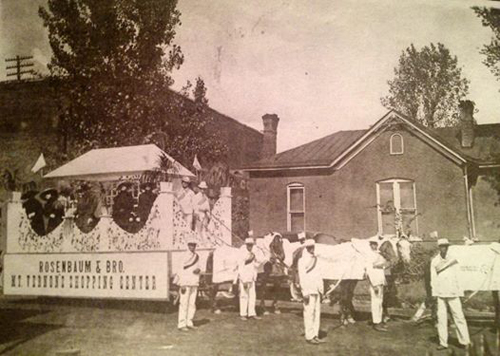
G.L. Lawrence...601-603 West Second Street.....1916 Advertisment
"Why shop around? Come here where it is and save you trouble and time. Our various lines enable you to satisfy your wants quickly and conveniently. We handle Star Brand shoes, Kabo quality corsets, E & W work shirts, New Way suspenders, Topsey hosiery, Wilson's children's hose supporters, all kinds of staple and fancy dry goods enamelware, queensware, tinware, glassware, stoneware, hardware, and anything you want to wear......" plus they got groceries and buy produce...come and see.
Hagemann Stables.....1914
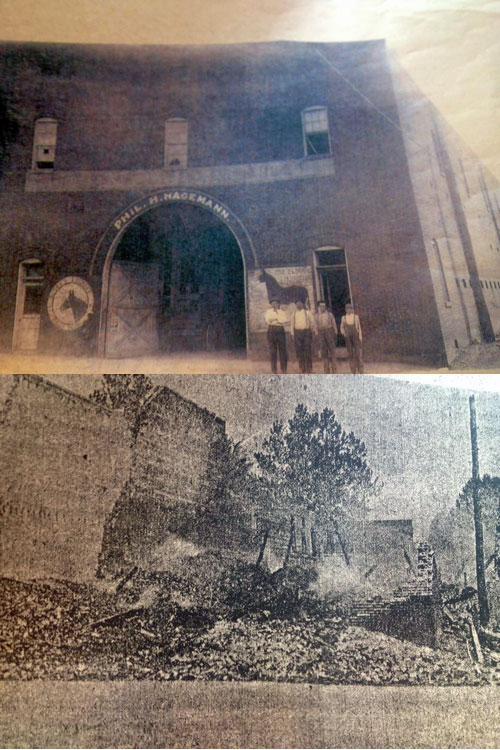
The Hagemann Stables before and after the fire. The site of the Amory until 2014.
Circus Indians Perform in New Harmony.....June 1914
It's sort of a sickening condition that we as "Americans" basically starved these people out...they were treated so badly. The Miller Circus came to the small town of New Harmony that summer and a had a "party" of full blooded Sioux Indians from the Rosebud reservation, "loaned by the government to a Mr. Dickey and put in charge of Bill Simpson, a half-breed as interpreter." Bill's wife had the name of "Days Gone By". Other Indian names were Chief John Bullman, Four Father and his wife, Jumping Noise. Others were Dancing Water, Rain in the Face and Man Who Beats HIs Wife. They were paid in tobacco and when they walked along Church Street after their night performance, they walked in single file with the women and children carrying the luggage.
New Harmony's Murphy Auditorium Opens.....January 1914
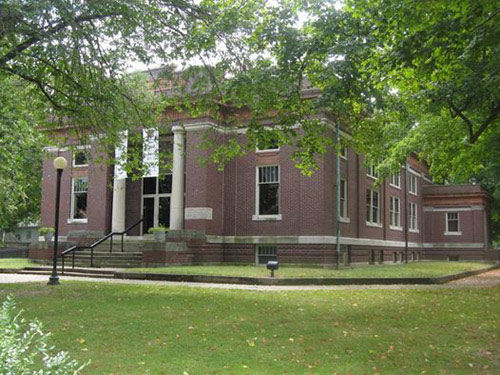
On land purchased in 1911 next to the Workingman Institute this centennial building enhanced the hopes of utopia. It was one of the finest playhouses in the state at construction. The project was funded through the Dr. Edward Murphy fund. Now the University of Southern Indiana schedules events here from lectures to concerts. It had a capacity in 1914 of 800 and had a large stage. In January of that year the scenery arrived for the new building and a drop curtain showing the bay of Naples and was from the work shop of Sosman & Landis, the leading scenic painters of the country. They also painted the landscapes. As you enter the flight of steps you pass between two columns into the tiled foyer. On each side are "retiring rooms" for men and women plus a lavatory. The auditorium was then lighted with indirect system and was "soft and mellow." There was a large switchboard so lights could be darkened or lighted at will. The entire rear was a gallery and nothing obstructed the view of the stage. The stage had two dressing rooms and space in the basement. It was dedicated January 20, 1914 with an address from Judge Hertis Clements.
100th Anniversary of New Harmony.....1914
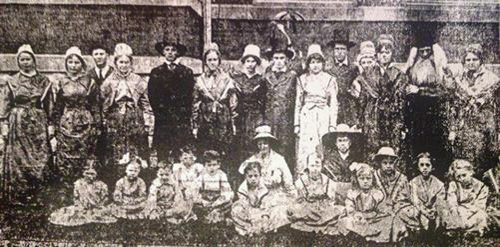
Residents Dress as Rappites
A Letter to New Harmony On Their Centennial of 1914 by Historian B.O. Hanby
This year New Harmony celebrates its Bicentennial and I have come across publisher and historian Brainard O. Hanby's letter to the town at the time of their 100th anniversary. "I love Mt. Vernon, but oh you New Harmony. I am filled with admiration for you, and so are the visitors who have been so fortunate as to enjoy your Centennial entertainment which has been the greatest event that has ever occurred in Posey County. But you should keep in mind that the very success of your Centennial has added to your responsibilities in accomplishing work that will bear good fruit in the future as it has in the past, for more attention than ever before will be given to you and you will be watched as a leader in municipal progress. The people of Posey County are proud of you and their sympathy and appreciation of your efforts to attain creditable accomplishments will ever be with you." B.O. Hanby
President Woodrow Wilson Sends Letter of Regret For Missing New Harmony Centennial.....1914
"It is with deep and genuine regret that I find myself prevented by public duties here from attending the celebration of the centennial of New Harmony. Everything that I know about that interesting and remarkable community and its unusual history of progress and enlightenment has made me desirous of taking part in a celebration which will illustrate so many of the most interesting features of American life. The history of New Harmony is in a way a type of what America has afforded men of high ideals and steadfast purpose an opportunity to do. The people she has bred, the men she has sent out from her to public service, all attest ideals and achievements which I would fain believe to be peculiarly characteristic of the great country we love when seen at its best. "Cordially and sincerely yours, Woodrow Wilson.
Former President Taft and VP Fairbanks Speak at New Harmony Centennial.....1914
Wm. H. Taft was guarded locally by the Davis-Hougland agency that picked him up at the Evansville depot. Detective Lucas met the Taft special at Stewartsville and was in close contact with him throughout the day. Taft at first was not too much for a body guard. "I had too much of that at Washington," he said. Later he found that Lucas was once in the regular army in the Philippines at the same time he was governor general over the islands so the two grew reminiscent recalling many stories. Taft when he returned home wrote this: "I write to express to you what great pleasure I had in my visit to New Harmony, both in meeting the people and delivering the address on the interesting history of your remarkable town. I am especially indebted to you, Mr. Taylor and Mr. Ribeyre. I noted some statement in the press that I had been loath to shake hands with the people of New Harmony. I am sure you will bear me out that I welcomed the opportunity to meet the people and that it needed no arguments to induce me to enjoy the pleasure." Sincerely yours, Wm. H. Taft. Charles Warren Fairbanks, the ex-vice president proved to be quite cordial, not like his reputation. He stayed in the A.C. Thomas home and enjoyed his stay During his speech Fairbanks talked on the rights of women and the movement being rendered to attain them. A ball was held after the address and Miss Fauntleroy was led in the opening march by Mr. Fairbanks. I don't think he stayed to dance all those quadrilles and minuets however.
Major G.V. Menzies Speaks on Posey County at New Harmony Centennial.....1914
Following a four-sided concert, Major Menzies spoke on Posey County. He was a guest during the day with Captain Ribeyre and sat out under the shade of the great side yard telling stories and discussing modern questions. A "jolly bunch" surrounded him just before noon and Menzies faced the great issues and disposed of them to his own mind anyway satisfactory. He talked about the Mexican situation, present and past, presidential administrations, the Panama Canal and women. The women "question" seemed to be the sticking point. It was said he had difficulty with that one! The major was not an ardent suffragist, but he did like the new fashions. He said, "I thinks they are prettier, more becoming and altogether the most desirable sort hit upon in all of the history of feminine apparel." The man never saw a mini-skirt and all his live long days....Come on sir!
Rapp Costumes Shipped from Economy Pa to New Harmony for Centennial.....1914
A number of original Rapp clothing arrived from the 1827 town of Economy founded by the Harmonists. They were put on display on models in the New Harmony library. Among them was a shirt of Father Rapp's, made entirely by hand with neat needlework and homespun cloth. His initials, "G.R." were worked in on the tail. Dresses sent of Rappite women were not of every-day frock. These were of silk, the skirts gathered at the waist and tight. Square silk shawls, folded into triangles were worn over the shoulders. Coarse plain white frills finished the necks. The men's trousers were of silk lined with a heavier material. The hats were "high crowned and reinforced with a bit of velvet on the underside of the front to protect them from undue wear."
New Harmony's old fire engine in 1914 Centennial Photo. The fire station is now Firehouse Antiques.
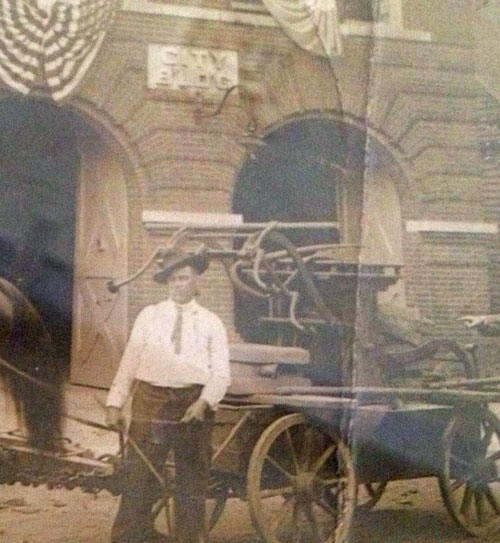
New Harmony Centennial Week Entertainment....1914
During the week of the Centennial of June 1914, various acts appeared to entertain the visitors including "Professor Murphy's Dog and Baboon Show." Now that's entertainment! It was at the 'rink" whatever that was and the highly trained animals gave exhibitions day and night. Many people went just to see the instruction of the animals through rewards in hopes of training their own pets. Mt. Vernon use to have organ grinders with monkeys down at the court square to entertain as warm ups for the snake oil salesmen or "roadside pharmacists" as they call them in Jamaica. We had popcorn and hamburger and egg peddlers on the street to hanging out at People's Bank. Wasn't long before merchants urged ordinances to stop the peddlers or at least slow them down with specific dates or having a license. I think a hot dog or tamale man would be a great asset to Riverbend Park.....just me I like tamales.
Disease in New Harmony.....December 1913
Strict quarantine and cooperation of the citizens were instrumental in limiting scarlet fever to two cases and diphtheria to seven cases. There were also nineteen cases of smallpox. Ten of the cases of smallpox were in four families who had not been vaccinated. The source of the diphtheria was investigated and 281 students were examined. Their throats were scrubbed with cotton balls which were sealed and labeled and sent to the state laboratory for biological examination. Twelve were carrying the germs of diphtheria and were promptly isolated and treated until they were no longer a threat. All the cases were rural.
Christmas Dinner at the Poor Infirmary.....1913
Charles Wallace, superintendent of the county Poor Infirmary, treated the thirty-one residents a dinner of spare ribs and "back bones" taken from hogs raised and killed right there on the "Poor Farm." The table spread was supplied with everything that goes with a good feast, including oranges, apples and candies. I am sure it was a fine day for the poor unfortunates. They probably had carolers too. I did that as a child once. The General Baptist church took us there and we sang at the bottom of the largest staircase I had ever seen. I was very young and when those folks came out of their rooms in their white night clothes, my jaw dropped. I felt like I was being visited by the Spirit of Christmas Past. I was ready to turn and run... "Lickety-split!" It is funny to me now, but it is also so sad. My appreciation to all those who care for our aged population. I'll be there shortly.
Mt. Vernon Bank Executive's Father and Grandfather Casualties of the Confederacy.....1913
John Willis Turner was an officer of the First National Bank of Mt. Vernon starting in 1907 coming here from Kentucky. His father was a confederate soldier wounded in the battle of Murfreesboro, Tennessee and his grandfather was killed serving with the confederate army in the battle of Cumberland Gap. Turner contributed much to our town managing our money at what was then the largest bank in Posey County established in 1863. Later it merged with People's Bank and Trust. If one looks at the names of the stockholders of the bank one sees many old prominent surnames like Gardiner, Leavenworth, Black, Dryden, Mann, Weir, Lichtenberger, Welborn and Evertson. There were Highmans and Kecks and Harlem's too. Many were downtown merchants and some had their names at the top of our buildings years ago.
~Wavy~ Hopes Historian Leffel Would Take Back His Words.....1913
I have great respect for newspaper editor John C. Leffel who wrote for 50 years in Mt. Vernon and published "The History of Posey County" in 1913. His intent was to publish an impartial history, but he wrote: "Such were the customs of the race of people who were driven out of Posey County to give place to the civilization now in evidence, and when we consider the improvements which the white men made in the course of a hundred years, having no more at their command than the savages had, namely, the earth and the fullness thereof, it does not seem so much of an injustice that the Indians were deprived of that which they could not or would not use. " ~ Wavy~ makes no bones to being impartial although I do strive to be kinda nice about it.
Weilbrenner's Grocery 415 Main.....c 1913
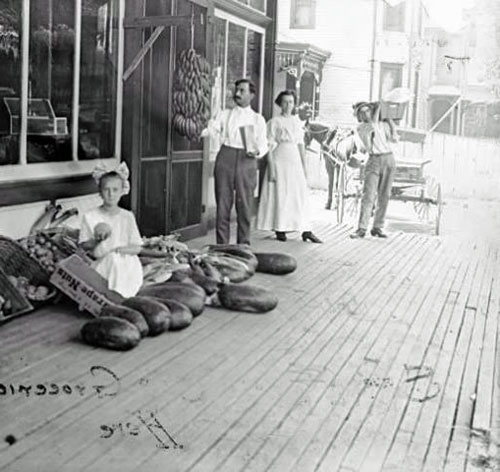
Located across from Fifth Street on the corner was Weilbrenner's, one of the larger stores in Mt. Vernon late in the nineteenth century. Its specialty was fresh fruits and vegetables "displayed on long tilted, tray-topped counters." The produce in the growing months came locally from our own fields, orchards and gardens. In the winter it received produce from Florida and southern states. There is even one article of a large tarantula being found in a southern crate. At Christmas time, oranges were brought in to put under the trees as a special treat. Editor's note: This picture was made with the negative reversed. I flipped it so you can read the Grape Nuts signage on the box.
Home Education at Mt Vernon High School.....1913
The old "Castle" that once stood on the Corner of West Fifth and College Avenue held kitchens and cooking rooms. There were two rooms on the north side of the basement for cooking. Tables, cooking utensils, dishes, etc., were in the west room, A Maleable Range was furnished by E.B.Schenk Hardware Company on Main Street. All the baking was done here with those newfangled electric lights and running water. In the sewing room twenty-two girls could work at one time equipped with Standard Rotary Sewing Machines. Learn to sew, get a job at the Overall factory coming soon. They actually had only two machines so the class did some work by hand making towels, sewing aprons, kitchen aprons, etc. While the women toned up the homemaking skills the boys they got to do all sorts of things like debate, role play in mock government, learn manual industrial training and play in the orchestra. Not too many girls in Agriculture, botany and physics classes yet.
Spring 1911
In the spring of 1911 crossing gates were placed at both Main and Walnut Streets in Mt. Vernon by the L&N railroad.
Inez Johnson Classroom at "The Castle".....1911
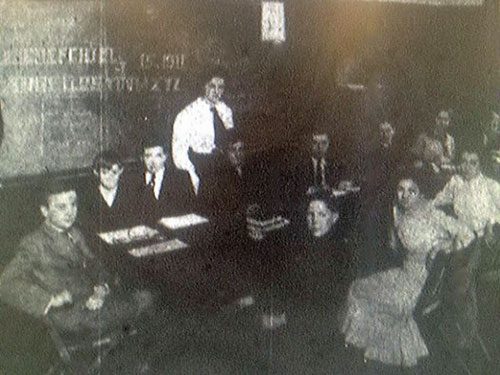
All music instruction was of the classical variety, none of that ragtime and blues nonsense. Johnson was supervisor of music and art instruction. She also worked with the grammar school children in the city grammar schools. This classroom was an addition to the old high school on Fifth and College, then Store Street. If you look at some of the photos some have the addition on the side and some don't. While the addition was being constructed, the old Methodist Church on Walnut Streets opposite St. Mathews was used for class meetings upstairs. Later that building was occupied by the Phythian and Modern Woodmen of America lodges.
Besides "Heebie-Jeebies" Date with Tom Boy Turns Out Swell....1910
The year 1910 and a shy young man starts to become of age at 12. Back then tomboys were, well resented by boys with athletic skills as a threat. If you lost a game of marbles or were out run in a game of tag you were ridiculed by the other boys. Most certainly if the game was baseball. Some little blonde girl in pigtails lining a hit over your head in the outfield just deflated the male ego. Our subject out of shyness to more pretty girls asked a tomboy for a date... his very first. He properly got the consent of her parents prior and the day came. Oh he was nervous and when he called at the home, to his great surprise, he beheld what looked to him to be a vision of a beauty queen! How could this dirty faced tomboy clean up so well? He expected to see a fairy god mother with a wand standing nearby. They walked to the Dreamland theater to watch the latest episode of "The Perils of Pauline," a two reeler called "Romance of the Yukon." Solos by Pascal Mackey were sung during the silent movie. The boy, whose name was Thomas Underwood, remembers him singing in his baritone voice "On Moonlight Bay," and "Let Me Call You Sweetheart. "His date was crying during the movie and he offered his handkerchief. The show ended and they walked to the wharf to see the steamer, "Joe Fowler" land and pick up cargo. They sat quietly looking at the moonbeams play upon the waters of the beautiful Ohio River. Curfew came and home they went. And memories of innocence survived a lifetime.
"Together Again".....1910
Two former Posey County residents (no name given) lived and died in Princeton and were buried together. They had been married 60 years and had 14 children. Their union had been a happy one, by all accounts. The husband came down with "winter fever" and soon too did his wife. He died on a Saturday. Hearing of it, the wife said to hold the body for she would soon be gone shortly. She died on a Tuesday and they were buried together. My wife and I always say, "We like to be on the same trip together," but I doubt she will be ready to follow me to the furnace so quickly.
1900's
The George Rapp Fire Engine Shown in New Harmony Fire of 1908
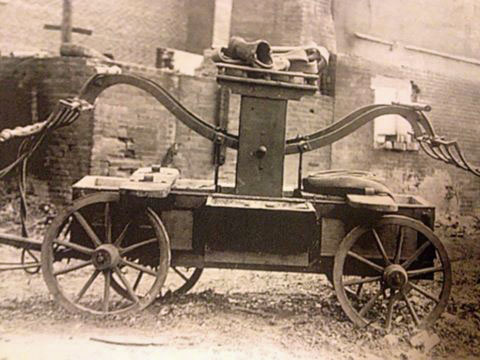
Now stored in New Harmony's Workingmens Institute, this old fire engine pumper known as the "Pat Lyon", was brought from Pennsylvania by the Harmonists in 1804 by Pat Lyon of Philadelphia. It has been in New Harmony ever since. It is a hand powered machine, requiring a compliment of 18 men to properly man it, for maximum efficiency. The New Harmony Fire Company was organized in 1848 and until 1870, this Rapp vehicle was the only one used.
Klondike Saloon 305 Main Street.....1908
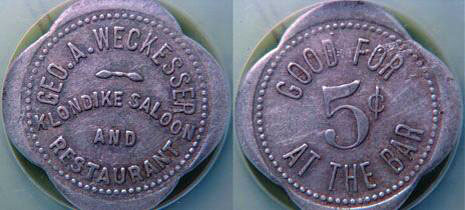
This became the Old Heidelberg Cafe, Hawk's and BC's.
410 Civil War Soldiers Reunite in Rockport Including 14 with Mt. Vernon Address.....1907
A soldier's reunion in Spencer County where 750 people were fed on the grounds was very successful. Those attending with a post office address from Mt. Vernon were V.M. Cartwright of the 65th Indiana, Will Lupton, E. Duckworth, R.B. Short, Sam Benthall, L.W. Jones, Frank Utley, W.F. Dixon, A. Erwin, W.D. Crunk, Jos. Mills, and R.F. Larkin of the 53rd Indiana Infantry. Others were I. Ripin of the 1st Indiana Cavalry and H.J. Klotz of the 60th Indiana.
Old Blacksmith Shop Razed.....April 1906
Historian Frank Fessenden wrote a few decades ago of walking to old Western School and on the way passing William Acuff's blacksmith shop on Second and Pearl Streets. I can only imagine the sparks, the sound of hammer against steel and the mixture of odors filling the air. Back in the 1960's, I entered a great uncle's old shop in New Haven, Illinois that once was a busy blacksmith shop. Charlie Lang had died three decades earlier and his widow locked the place up and never went back in it seems. I got to snooping and saw anvils, hammers of all descriptions, horse collars and nails. Even a old buggy. Fessenden must have passed that spring the cave in on West Second Street over Mill Creek. The fill had been constructed around 1870 and deteriorated. A new brick work arch was put in and traffic was suspended for several months later. Acuff's old shop was torn down and there was speculation that a new store would be constructed on the site. Times really change. Machines do the work today that men once made beating out kitchen knives and hand sickles.
Indiana Report by Board of Health On Mt. Vernon's Water Works....1906
The annual report mentioned that the facility dated back to 1886. In 1903 a Deutch Gravity Filter System was added to control water supply. A stand pipe held a capacity of 196,000 gallons of soft water to supply nine miles to distributing mains of cast iron and lead and galvanized iron were used in the distribution to 450 families using 750,000 gallons daily.
Modern Horseshoes.....1906

Curiosity from.....1906
Wm. Calvert and John Davis were cutting down a bee-tree near a Cypress slough, above Mt. Vernon, and found three sections of honey-comb weighing about 20 pounds. In the lower part, imbedded in the comb was the skeleton of a medium sized fish, judged to be a grinnel. The hole in which the honey was found was a full forty feet from the ground and it was believed the fish was carried there by a coon. The honey-comb was taken to town and put on exhibition at the Western Star newspaper office.
New Tricks.....1906
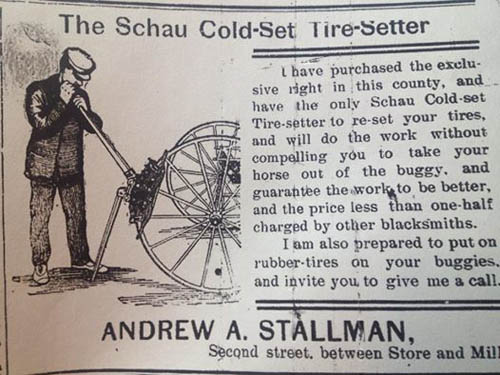
Tax dollars at work.....1906
A cement curb or coping was placed around the Posey County court square........1906
Western Star Censored Until Article Clipped Out.....July 1905
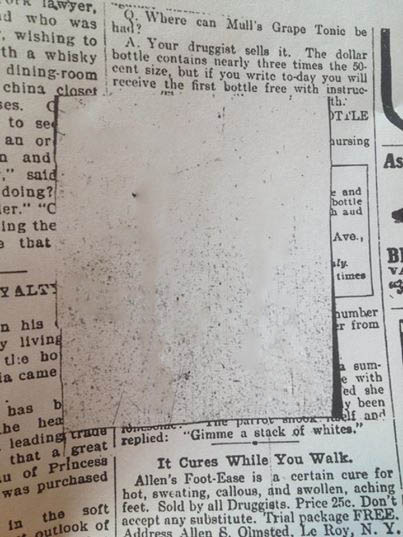
On July 14, 1905 the Western Star newspaper, edited by John C. Leffel, was excluded from the mail on account of "violating the anti-lottery law." The Star had a small news item on the fourth page announcing the result of a drawing contest for some building lots, which was contrary to postal laws. The stacks of newspapers had been sent to the post office and the officials there noticed the item and held out the paper from the mail. The editor then went to get his papers and carried them back into the office, and had the article clipped with scissors and re-mailed to Star readers. Leffel said, "I have never claimed the honor of being much of an editor, but as a "scissors editor," I now demand the honors, and think beyond a reasonable doubt am entitled to it." The penalty for this offense, (the law had only been in force for two weeks) was two years in the pen at hard labor. When the editor told his staff to employ half a dozen boys to cut out the objectionable article, they said with tears rolling down their cheeks as big as walnuts: "we would rather go to the pen for two years!" Pleadings, however, were of no avail.....and the job was completed with help of shears purchased at E.B. Schenks.
Ice Gorge Breaks.....March 2, 1905
On a Thursday afternoon, in front of Mt. Vernon, the ice gorge started to move as witnessed by hundreds of our citizens who had congregated at the levy in anticipation. At various places along the riverfront, ice piled up 25 feet high and over 50 feet long. The Ohio had been frozen over completely exactly three weeks, and during that time hundreds of Mt. Vernon residents walked over to the Kentucky side. Hagemann Brothers brought back over their mules and cattle, fearing an overflow in Kentucky following the break-up.
Man Buys Groceries, Walks Across Frozen River, Never Seen Again.....February 1905
John Bliss was a farmer from Kentucky and in the first week of February of 1905 he crossed the ice and spent a week in Mt, Vernon at the Kahn Hotel on Main Street. Come Sunday morning he called for a basket of groceries from a local grocer and left the town. He told the hotel he was going to walk back across the ice to home. Six days later on a Saturday his hat and basket of groceries were found about 50 yards from the Kentucky shore, covered with light snow. It was believed he stepped into an air hole or thin ice and drowned. Three weeks later, H. T. Utley, a coal miner from Waverly, Kentucky, and a cousin of John, went to the spot they thought was the place of his death and made a dozen or so holes into the ice and placed many sticks of dynamite and were exploded, but the body did not surface. It was thought the body may have floated down stream for several miles. No indication it was ever retrieved.
For Many In Upton; Shoes Didn't Match For A Year.....1905
I have read about the head on collision near Upton in July of 1905 many times, but I never heard the story about the shoes until it was revealed in a newspaper article in the 1970's. An error by a dispatcher caused the death of three men, injured several and killed dozens of cattle, sheep and mules. In this story one of the trains was the Hagenback and Wallace circus and the other one a fruit train heading west. That was the first I had heard of circus and it is funny to me that no one mentions exotic animals killed. Be that as it may; merchandise along with the three bodies were strewed over a large area. After all was picked up, scavengers walked the tracks and found the shoes. Sometimes they only found one and then another one of a different style or size. It was said people wore their different shoes that whole year. Rural life was always hard.
Up In Smoke.....1905
Hermie, son of Clarence of the Walker clan of Grafton was bringing in a load of hay into Mt, Vernon. It was a pleasant Friday afternoon, and the young man took a few hits off his corn cob pipe. Unfortunately, the peaceful moment passed when sparks from the pipe ignited the hay and before he was aware of it or reached the scales it was out of control. Hurriedly, he slid off, unhitched his team and watched his hay and his wagon burn. That wasn't going to go over too well at home it was feared.
Health Records Needed to Travel by Train West.....1905
Although no evidence of yellow fever is in Mt. Vernon a scare had been reported in Southern Indiana and the local L & N agent announced quarantine against Mt. Vernon and that all west bound passengers were to furnish a certificate of health from the local board. The last United States major outbreak was that year. One fatality in New Harmony of a visitor to New Orleans coming home caused the scare. Last year if you remember I found his broken grave and the story of how he was buried in the middle of the night without anyone touching him.
"Reunited and feels so good; Reunited and it's understood".....1905
In 1904 a gentleman passing through canvassed Mt. Vernon for the enlargement of pictures, and had with him a three month female bull terrier, which became lost. He remained here for several days and hired a horse and buggy making the rounds of the town trying to find his pet without avail. A year went by and one of his agents passed through town and found the dog in the possession of Billy Dieterlie who said a friend had found him on the streets and he adopted the dog. The owner was notified by wire and a week later he traveled over 200 miles to secure his long lost pet. Dieterlie turned over the dog, was complimented upon the care he taken of her and was handsomely rewarded.
Lawrence School in Point Twp, Built 1905
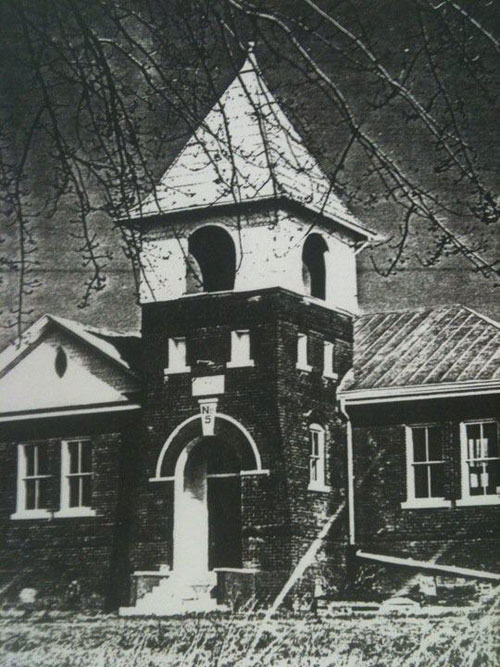
A teacher during this time made less than $3 a day. I imagine it was a pretty sorry situation in the rural schools with one teacher and frequent absences due to students missing to work at home or illness. Books and materials were limited and the schools not always the best. Pretty hard to get to a library back in those days, and Mt. Vernon had just built theirs. My family roots are in Point Township and my father attended many different schools, but was lucky just to get through the elementary grades. Thankfully, dad learned easily and he always had a quest for knowledge. Helping with my homework growing up he actually learned right along with me.
Silas Howard...MV Auditor 1898-1904
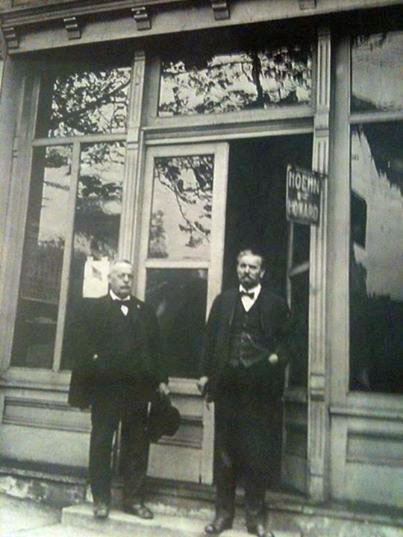
The photo is from 1914 of the firm Hoehn & Howard, formed in 1908. It was an insurance and real estate leader in Posey County. Silas' father, William came to Mt. Vernon in 1873 and Silas graduated from the local high school in 1878. He then became a teacher and even principal of the East Ward School. In 1883, he resigned that job to accept the position of deputy auditor of Posey County. He then became auditor in 1898 and re-elected in 1902. That was the year he married Miss Catherine Mann, a daughter of Philip Mann, a well-known and successful tailor in Mt. Vernon over many decades. Two children were born Catherine Louisa Howard and William Philip. And yes, Catherine Louisa was "our" Miss Howard in high school for us "baby boomers" and before. She taught in three different MVHS buildings. Mr. Howard was a Democrat "in the right sort" and was very popular and generally well respected. He had pleasant genial manners and was a man of sterling integrity, generous it was said to a fault.
Coffee at the Wabash River Old Dam early 1900's
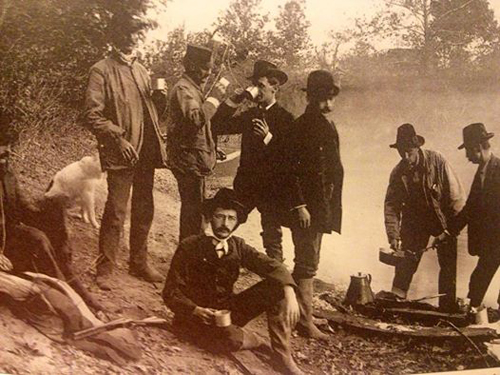
Photographer was William Frederick Lichtenberger, who was a son in law of Mt. Vernon's Western Star editor John C. Leffel.
Memorial Service In Mt. Vernon for Assassinated President....September 19, 1901
Four days after the 25th President of the United States, William McKinley was killed; Mt. Vernon held a memorial service at the Posey County Court House. The program began with an address from G.V. Menzies. The school children sang a chorus of "America," followed by an Invocation by the Rev. Wm. Duliamel. A choir sang a hymn and another address was given by Prof. Edwin S. Monroe, Principal of MVHS. Following a solo by Mrs. Chilton Pleasants, Father Luebbermann spoke. Manuel Cronbach gave an address as did F.P. Leonard. One more hymn, "Near My God to Thee" and then the Benediction by Rev. Wilson Blackburn. On this day the casket was sealed and the relatives of the President paid their final respects at the McKinley home before burial in Canton, Ohio. Professor Monroe taught a lecture course too at the high school. He had been President of the Posey County Teacher's Association, principal for three years at Farmersville and then became MVHS principal in 1895. Later he was Superintendent. He was well liked by faulty and students, known to be engaged, up to date, energetic, and just. By all indications he was "in the right time and place."
"Uncle Rube" is at the Opera House.....February 1900
The Masonic Hall was to host "Uncle Rube" Tanner, well known story-teller. Patrons were encouraged to attend the hay-seed show, "free of vulgarity and rat-trap commentary." Here was a show advertised to bring your wife or your daughter for an enjoyable evening with Rube and a company of comics who exhibited some of their routines along the streets of the city prior to the paying event.
Once was a Beautiful Home at Soutwest Corner of Fifth & Main....1900
Have you ever noticed the parking lot of Bud's Hardware being several feet below street level? Well long ago in the 19th century there was a magnificent brick home of two stories belonging to Enoch James. It has been reported that General Wm. H. Harrow wed Juliette James there. The property ran along Main Street to the alley on the south and had a sunken flower garden, a large lawn and tall shade trees. It also had a large fountain that passerby's would lean over the wrought iron fence to watch the water overflow into the garden. In 1865 the home was sold to Elijah M. Spencer, a local lawyer who lived there until his death in 1912. Spencer, a Democrat served two terms in the State Legislature beginning in 1865. The house would have been where the former Clayton Cleaners was and the garden south of that. The sunken garden may have been due to legend that says this was a site of a pond in pioneer days. North of the home in 1815 a panther killed James Culbertson. A look at a 1915 City Directory shows that the widow Mary was still living in the home in 1915 and in 1925 we find son John W. living there who became Chief Justice of the Indiana Supreme Court.
Colonel Alfred Dale Owen....Mayor of Mt. Vernon (D) 1898-1900
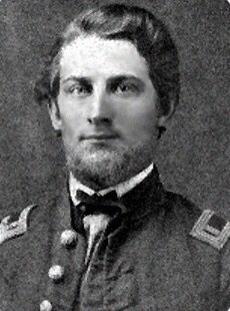
The son of Dr. David Dale Owen a prominent geologist, and the grandson of New Harmony's social reformer Robert Owen. After being confined to his bed and room for three years he died in 1903 at age 62. He had studied in Germany at the age of 13 and by the age of 16 he was a student at the Western Military Institute in Nashville, Tennessee. By the age of 29 he was a private in the infantry in the Civil War and after six months he was a lieutenant. By 1863 he was a full colonel serving until the end of the war. He was offered the rank of brigadier general after the war but refused, saying "the war has ended; there is no need of the rank." He came back to New Harmony in the mercantile business until 1875. Then he was elected Posey County auditor and served until 1883. He then took an appointed cashier's job at the Mt. Vernon Banking Company. In 1898 he became Mt. Vernon's mayor replacing Lionel Larkin.
Roustabouts.....1900

"Roustabouts" were mainly African-American doing the hard labor at the wharfs along the Ohio River. This photo from around 1900 is Evansville, but could easily reflect the opportunities of Mt. Vernon.
In the late 19th century and early 20th century the St. Matthew's choir in Mt. Vernon produced two world known singers......Mary Munchoff and Olga Joest
I have no record of Olga, but Miss Munchoff later moved to Omaha, Nebraska to live. She studied in Berlin and Paris and traveled all over Europe and Russia singing with symphony orchestras under the greatest conductors of her time.
"Rack 'em Up...I'll Break.".....1900
Sammy Kahn, former wagoner of the Company B, 161st Volunteers under local Captain Menzies bought out the billiards room from Morris Pfehl on Main Street. Before he was into cues and snooker he was a pretty good baseball player down at the Eastside grounds and in the war with Spain, he was assigned to the mules. The war ended before they could do any damage, but he was the one in charge of carrying the grub to the boys. There wasn't any MRE's in those days; they were eating bacon, hard bread, coffee, beans, rice, and hominy. The logistics of the food was a problem as supplies piled up in Florida and much was wasted, but they never went hungry.
1890's
Small Pox Scare Cancels Fiddle Fest.....October 1899
Houses throughout town were being "flagged" and none of the patients or inmates could leave. Physicians were doing a big business vaccinating the young and the old. "Thus far none of our poor white trash has been contracted," said the Western Star. Owing to the scare the fiddling contest was indefinitely postponed and there will be no more fiddlin' for several weeks to come, which is cheerful news to the neighbors. Mr. Moeller, the cooper has kept residents up for weeks practicing on a old fiddle which no one had seen him play in 40 years "and still the old fool things he is making music."
"You Gotta Stop, Oh What's that (Smell)? Everybody Look What's Going Down"...1899
August is hot in the river city and the smell is suffocating to some. Imagine outhouses and livery stables and hitching posts and animals in the yards....Ugh! Got so bad that some citizens who walked to work filed a grievance to the City Council about a manure box in the rear of Dr. Ramsy's stable. They said, "it's a nuisance...not in our neighborhood!" City Council investigated and felt it was no worse than any other part of town.....case dismissed.
So-Called "Moral Show" at the Masonic Hall.....1899
Duvall's Georgia Cake Walkers was in our city and gave a strict "moral show." No strippers, no sexist jokes, just two and one-half hours of solid fun of the best of comedians, sweetest of singers, noted dancers and "making fun of plantation melodies." hmmm. I guess morals differ in different times. Let's hope we continue to evolve towards inclusion. It was a one-nighter, I mean one night only affair, a show, and the best tickets, the reserved ones could be picked up at Fogas' drugs at the corner of Second and Main. A cake walker by the way was African American music, usually done by only men and was the typical stereotype of slave life of the "good times" when slaves would dance to "their" music of fiddles, banjos and Jews harp. Typically the men wore top hats and the women long ruffled dresses with wide hoops. Walking sticks were present and long split tail coats.
Bellefontaine Cemetery "Dead House".....1899
The Board of Directors made their quarterly inspection to Bellefontaine and found it in excellent condition, except the most important....monuments have toppled and some were close to it. Trying not to let the cemetery fall in disrepair like some have, the sexton was requested to furnish a list of names of those owning monuments in poor condition to have them repaired. Those that do not comply will have their stones removed from their lots and placed in the "dead house" until called for. "Please those having relatives or friends buried in this cemetery take pride in keeping the monuments and markers in proper condition, thus adding to the beauty." Mr. Keitel, the sexton, will do the work at reasonable rates.
Rabbi Emil Ellinger Resigns As Spritual Adviser to Mt. Vernon Jewish People.....1899
Dr. Ellinger was born in Hungary in 1861 and received his Hebrew education at Nikolsburg, Moravia and his secular education in Vienna. He first became rabbi at Devecser Hungary then came to minister to the Mt. Vernon faithful. Described as "broad-minded and liberal...he never failed to respond when invited to take part in any endeavor that would benefit the community." He was a kind gentleman by all accounts and liberal in opinion towards others faith. Leaving Mt. Vernon for a larger audience I tracked him to Sioux City, Iowa then to Alexandria, Louisiana. I wish we still had the pioneer Israelites in our home. They had such a tradition here for a hundred years.
Local Farmer Protests McKinley's Tariffs.....1899
A local reporter went out to a farm west of Mt. Vernon to see an old friend and Democrat. There he met Sam and to the astonishment of the reporter was shearing a sheep at the tail and working towards the head. When asked why he was doing it in reverse order he said, "Damn Republican has the price of wool so low that I am ashamed to look the sheep in the face!" Albert Sparks was the Democrat editor then and he loved to fluff feathers. His political enemies called him "The Mt. Vernon Judas!"...one paper said," born a petulant sorehead....he is possessed with one idea to rule or ruin. We should hold him over the flush-pots of City Hall and make him inhale the savory smell. "
The 161st Indiana Regimental Band.....1899
H.M. Lord, of Mt. Vernon was in this band. I have no idea which one he is in the photo. This band had chosen musicians throughout Indiana and Lord was said to have been one of the "principal musicians." They moved through the South playing concerts in Savannah, Georgia and Jacksonville, Florida on their way to "occupational held" Cuba in 1899. At Mariano, Cuba they played a concert for Major General Fitzhugh Lee.
The Architect of Posey County Court House.....1898
Josse A. Vrydagh (1833-1898) was a well-known architect who lived in Terre Haute, Indiana. Josse was a native of Louvain, Belgium then worked as a civil engineer in Paris, France before he studied for seven years at Louvain Academie des Beaux-Arts. Coming to America he settled into Terre Haute in 1866 and almost immediately went to work at the State Normal School. His buildings and drawings were so impressive the United States Treasury Department hired him for a while as an architect. In his county he built residences, government buildings, a post office, auto garages, Wiley High School, a spice mill and even court houses in Sullivan and Greencastle, Indiana. Most of his buildings are gone now or changed so radically from their original design and purpose....except one....The Posey County Court House right here in Mt. Vernon is his finest and last gem. The people of old Posey have taken good care of the old "Temple of Justice" now for 138 years.
John Rockefeller of Posey County is 105 Years Old.....1898
An article appeared in many Midwestern newspapers in January of 1898 about the number of old folks in Indiana over 100 years of age at the time. A total of 45 were found with the oldest being Fannie Baske of Mound City who was 112. Here in Posey we had John Rockefeller, (not the rich guy). This gentleman was the salt of the earth sort of man who came here when we were a forest occupied by Indians. He cleared the land, built the roads, tilled the ground and worked hard. He drank his liquor straight, smoked long leaf unseasoned home grown weed and chewed it too. That's all I know about the old man whose blood was invigorated by the use of stimulants, muscles seasoned with tobacco, and reached a long life. Of the list all but three used tobacco and all drank. Two were Negroes, thirteen born in Ireland, a few Kentuckians transplanted, a Quaker, a German and Frenchman.
In 1897-1898 a NY cartoonist for the New York World newspaper drew cartoons called "Posey County." Do you think he was talking about us?

In December of 1878 it was reported that certain parties were conducting fox hunts daily in the northern part of Posey County. Another was held on the Alexander Crunk farm, four miles east of Mt. Vernon in January 1879.
"Thunderstruck!".....June 1897
A Sunday afternoon thunderstorm passed through the county with lightning striking a weeping willow tree in the Bellefontaine cemetery. The symbolism of such a tree is deep in tradition. Some call it a symbol of grief going back to the Psalmist hanging their harps in such a tree near the rivers of Babylon. Other eastern cultures found it to be evil. Either way, it was destroyed almost completely with a mighty loud noise that not only killed a fine mockingbird living in it, but scared the wits out of the sexton Lintz's family living opposite the cemetery. "It's alright, were doing fine, fine, fine, fine.....Thunderstruck."
Transplanted.....1897
Two bodies were moved from Leonard cemetery (North) to Bellefontaine after being in the ground eight to ten years. The corpses (no names given) were reported to have been in a "splendid state of preservation", and could be identified by relatives present.
Inspiring Sermon Brings House Down.....1897
Col. Reverend J.W. S.P. Woodfork, a black minister in town who works for Henry Brinkman's Implement house was to give a sermon at the District Conference to preach the gospel. Word has it that his first sermon he ever gave, "burst the plaster from the ceiling of his church and brought in seven policemen who arrested the congregation." When asked if that was true, the Rev only said, "The days of miracles are not over."
They Couldn't Catch the Winner.....1897
In Circuit Court, Jas. Blake was found guilty of riding in a horse race on local streets and was fined $5.
Indecent Exposure - Five Times Guilty - Fined $10.....1897
A local dude of Mt. Vernon was tried before Squire Hutchinson and charged with making an indecent exposure of his person to one of the most prominent Jewish ladies in town. This character appeared at this residence, that of which he was employed at and asked to be shown a cage of white rabbits in the rear yard, and while there made indecent proposals and exposed himself which was again repeated two nights following when he seen her again upon Second street en route home. This was the fifth time this man had appeared before our courts on similar charges. The newspaper called the fine not enough and said, "An inch rope in the hands of the proper parties might, perhaps, maybe, learn him a lesson."
Chain Gang Awarded with Smokes.....1897
An amusing sight it must have been on West Second Street that Saturday afternoon when sidewalks were blockaded on both sides of the street while a chain gang of eleven prisoners scraped the street. They did such an excellent job that insurance agent Edwin Wade awarded each "wandering Willie" with a ten cent cigar which drew quite a crowd of laughing citizens.
Faithful Plow Horse Gets Decent Burial....Spring of 1896
"Morgan" was his name and for 31 years he logged, pulled a plow, and heavy wagons in Point Township. The large muscled draft horse with the docile temperament finally did his last row and dropped dead in the field. The grateful farmer called Reverend Smith over from church and the family buried him in an emotional service.
Keck-Gonnerman Company Machine Shop.....1896
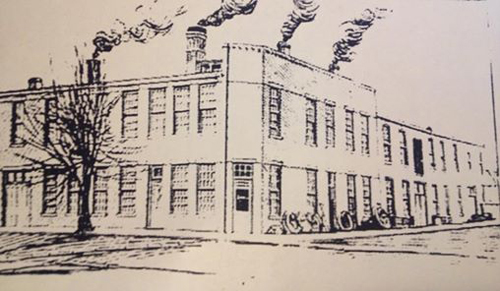
The history goes back to 1877 when John Keck and John Woody had a foundry and was known as Woody & Keck until 1883. Then it was Keck & Onk for a few months and then Keck & Gonnerman. Business became incorporated in 1901.
City Hall & Fire Department Illustration.....1896
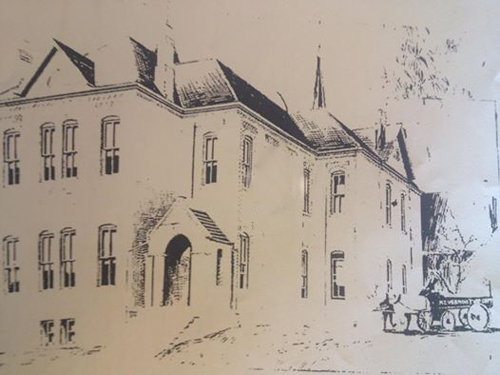
Residence of Major G. V. Menzies, now Known as the "Hovey House.....1896
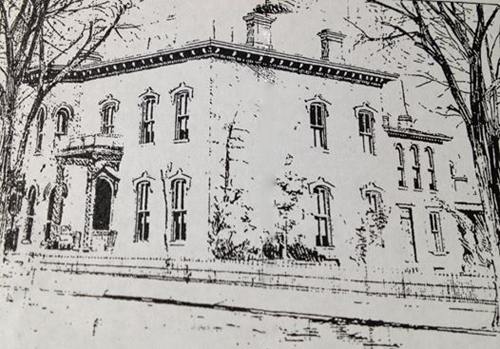
Gov. Hovey had it built for his daughter as I recall. He lived in the present Elks Home.
Residence of Dr. Douglas C. Ramsey at 118 East Third.....1896
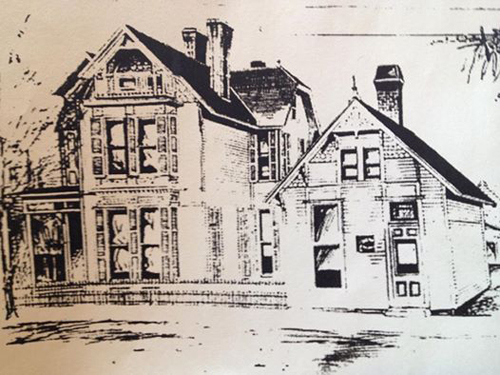
A son of a doctor, Ramsey graduated from Washington University in 1880 and came to Mt. Vernon soon afterwards. He followed up on his education in St. Louis, Chicago, Canada and many eastern U.S. cities. He was the author of many medical journals in his long career in our city. Editor Note: Research shows the address is where the Coliseum is now. The actual Coliseum address is 126 E. Third. This still is the Coliseum area just close to the alley side.
In 1896 the Mt. Vernon Democrat characterized New Harmony as "Boston of Posey County."
I don't know about all that, but I guess he was referring to the town's innovation and its attempts at revolutionary new ideas.
Pitcher's Duel for Title....1890's
Long ago Mt. Vernon played baseball at "The Commons" near where Farm Bureau Co-Op is today. We had many fine players including an excellent battery of William "Billy" Bell at pitcher and Harry Smith behind the plate. Back then away games were by buggies, boats and sometimes trains, we had a top semi-pro club. "Billy" was a junk ball hurler, known for his "Uncle Charley" curve balls. Smith was a good receiver. Legend has it that he turned down offers by the St. Louis Browns and Chicago Cubs to stay in Mt. Vernon and maintain the court house in top condition. He was comfortable here and wanted no part of the big city. Of this contest the league championship came down to one game between the Mt. Vernon Red Pumps and the Madisonville, Kentucky nine. It was as usual a Sunday game but was moved to a neutral site at the Evansville ball yard, home of the Evas. The winner was to receive all gate receipts and a hundred dollar side bet. The bleachers filled up early as both towns brought large numbers and then the curious of Evansville walked in to view the action. Billy Bell and the Kentucky pitcher on the hill were in good form. Mt. Vernon pushed across one run and Bell made it stand up. The Mt. Vernon fans were pitching silver out in the foul territories for a home run. It never came. Still we won and the Mt. Vernon band was on hand and as the ninth inning was closed out, they struck up, "There will be a hot time in the old town tonight." Loved to have been there! One other story I recall was of a player from Mt. Vernon who had a very strong arm, standing at home plate and threw the baseball over the right field fence at the ball park adjacent to Edson Street, later to become Mt. Vernon's airport. I wish I could recall his name, but he later played I believe for the New York Giants as an outfielder. Other fine MV players of that era of "dead ball" were Phil Suddoth, Jesse Weisinger, Jerry Ryan, Howard Sarlis, Sam Kahn, Merle Weisinger, Howard Flesher and "Paddy" Schultz.
MV Knights of Pythias Band Returns by Rail from Washington D. C. ....September 1894
The Washington Times said: "The Mt. Vernon Band was loudly applauded for their fine music." Our Western Star paper said: "The Pythian Band of this city led the big parade of Knights at Washington during the Encampment. It is estimated there were 100,000 people on Pennsylvania Avenue and 12,000 in line. Our people certainly ought to feel proud of the band, as it was looked on in great favor by the Washington public. "
Mt. Vernon Knights of Pythias Band in Washington D. C.....August 1894
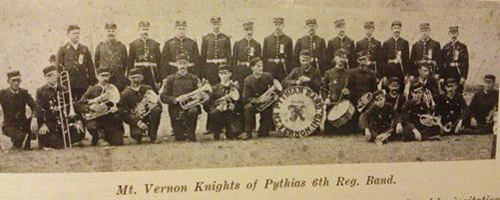
Front: Grant Reagen (carpenter), Wm. Dietz (barber), Floyd Jones ( photographer), Hector Reagon (carpenter), Utley Stevens (restaurant), Fred Tente , Henry Lord (printer), Charley Moeller (cooper), John Moeller (cooper), Edward Robb (woodworker at Keck Gonnerman), Wm. Wehr (cooper), Louis Brinkman (tile factory), Elmer Taylor (barber), John Larkin (student), Arthur Henrick (student), and John Massey ( band director). Back row: first two unknown, Wm. Holten (bank cashier), Peter Roach (owner and publisher of Mt. Vernon Democrat), Benjamin Pughes (mechanic at Keck-Gonnerman), Joe Schlomer (jewelry), Thomas Peckinpaugh (real estate and insurance), Charley Brinkman (hardware), Charles Pullem ( high school teacher), George Green ( Posey County clerk), Edwin Monroe ( high school supt. ), Mac Jarodski (dry goods), and Eugene Fuhrer ( milling).
Out for a Swim...Never Seen Alive Again.....August 1894
Around 4 PM on a Friday, Jos. Yowell, 22, and Bryant Dawson 17, employed in the Charles Dawson drug store on Main Street left work and secured a skiff from Mr. Paige, a fisherman informing him that they wanted to cross the river to take a bath and be back in an hour. When the failed to return on time, Paige could see plainly across the Ohio that the skiff was there and they had been gone two hours. Paige crossed over and in the boat were the young men's clothes but the men had disappeared. A Negro said he saw the men earlier about 400 yards above the skiff. The river was dragged by friends during the night and not until Saturday afternoon was their bodies recovered. Both were said to be excellent swimmers and it was determined that Dawson was stricken by a cramp and coming to his rescue, his friend was dragged down with him. At the point of entry the water was at the depth was only a few feet, but dropped off quickly to around 14 feet. The bodies were found about 25 feet from shore. Remains were taken to the Weissinger's establishment and prepared for burial at Bellefontaine cemetery.
Steamer "Eugene" Sinks Near Mt. Vernon....May 1894
The towing steamer, "Eugene" while on its way from Henderson, Kentucky was caught in a huge windstorm and capsized near Mt. Vernon in twenty foot of water. No lives were lost, but the failure lost was set at $7000. Using an on line inflation calculator that $7000 would be worth $189,189 today.
"A Living Skeleton " Exhibited on Main Street....1894
John Jones, of Wichita, Kansas was walking as a human curio on Main Street, Mt. Vernon making a few coins. He was 35 years old and weighed all of 49 pounds! Seventeen years prior he weighed 150 pounds and it began to fall off his flesh and had gradually diminished ever since. He says he has never been ill during that period of time. Scientific examinations were said to have been made of him, and the general impression was he suffered from muscular apathy or drying away of the flesh. The editor said his arms were contracted and drawn up as though they were folded. Through his chest he measures around four inches and his arms and legs were about two or three inches around, respectively. His jawbones and elbows were so thin that they have worked through his skin and are visible. Editor Leffel said, "many curios have been seen here, but Jones is the most wonderful of all I have ever seen!"
Another photo of the Pythian Band.... Probably the same group who led the parade in Washington DC in 1894

Certainly the same drum as earlier photos I have seen.
Servite Sisters and Sisters of Mary Establish Their Seed in Mt, Vernon.....1893
I know little about this order that was founded in the 13th century in Italy. It seems to be Catholic related, correct me if I am wrong. The first representation in America came in 1892 at St. Michael's in Wisconsin. A year later the second attempt came in Mt. Vernon. The group identified itself with Mary and "try to seek ways of bringing reconciliation to a world fractured by conflict and injustice." The only other mention I have found of it here was a request to the Sisters to establish a "mother house" and boarding school at Enfield, Illinois in 1895. They did so under trying conditions but in folded sometime between 1908 and 1910.
Earthquake.....July, 1891
On July 27, 1891 an earthquake registering 4.1 in Evansville was felt strongly in Mt. Vernon in the early morning hours. Chimneys came down, furniture turned over and people were alarmed.
Drums from the Pulpit.....1891
Young man, doesn't thou go into the town at night and rush the growler, and perambulate the streets to an unreasonable hour? Dost thou whoop it up with the boys and finger for subsistence in the jackpot with thy sheckles? Art thou a guzzler of beer and player of cards? Does thou suck the pernicious cigar root and hast thou lost thy grip on the ways that are rigid and good in the world? Verily, verily, I say unto you, keep thy lips from the jug that contains the intoxicating juice, and steer widely of the aces and of loose women so in thy ripening age you will not be full of the collateral of the earth. Amen.
Governor Alvin Hovey Intended to Come Down Hard on White Caps.....1891
Mt. Vernon's A.P. Hovey was stymied to reform the state legislatively during his term due to the powers of his office being reduced during the previous administration. He took challenges to court but was turned back time after time. He was successful in improving the vote fraud in the state during his tenure. He turned his attention against the White Caps. He campaigned against the vigilante groups that had carried out several lynchings. He may have been moved at what happened in his own town in 1878 of lynchings at the courthouse. Harrison and Crawford counties were hard hit by the former Civil War soldiers meting out corporeal punishments to criminals, dead beat dads and alcoholics. In a forty year span following the Civil War 48 white people had been killed by the groups and 20 African-Americans. Fear of the group spread to such southern communities as Corydon, Newburgh, Rockport and Vincennes. Literature and evidence of a meeting house in northern Posey County had been found at the end of the Civil War. Hovey launched an investigation into the groups with intentions to bring them to justice before his death in office. No arrests were made, but the threat of state intervention caused a decrease in their activities.
Governor Hovey Guard Ribbon.....1891
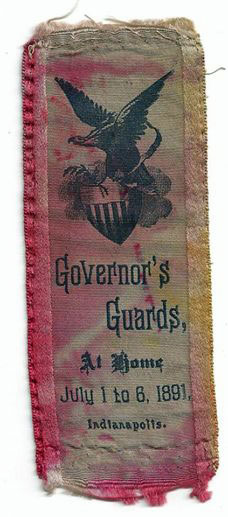
Alvin Hovey died November 23, 1891 in Indianapolis and is buried in Mt. Vernon. He lay in state in the Posey County Courthouse.
Indiana Story of a Woman Preserved Forty Years After Her Disappearance.....1891
Although not a local story, I thought it was a good one to share. This story was reported in a Canadian newspaper, "The Kamloops" in August of 1891. Mary Ann Grier was quite a looker in the old days of 1845 to 1850 and she was sought in marriage by many an excellent young man. She was known to be a good worker, an excellent cook, with a pretty good education and great housekeeper. She picked a fella and told her parents she wanted to marry him. The man owned an ox team and made a living hauling ore from the shallow mines near Michigan City. Mary's old man told the young man to stay away from his daughter and when he didn't the young man was given a sound drubbing. The day after that, Mary left the house, saying she was going to a neighbor, but she was never seen alive again. Her parents and the neighbor believed that her boyfriend had taken her away and maybe they eloped. The boy left town when the girl came missing and was never seen again....never. What they think happened was when they found her body was that she meant to meet her lover near the creek road. Somehow she fell into one of the ore pits and as she fell an avalanche of loose heavy soil covered her in mud and water. The solution preserved the body until it was found forty years later. When found she looked almost the same as the day she went missing. All her clothing was long gone, but the chemicals preserved her flesh. Her form was perfect, and the color had remained unchanged. Her arms were said to have been white as marble and her hands had a ruddy flush which old timer's remembered as one of her charms. Her eyes were gone however, so the empty cavities were unsightly. But here laid a handsome young women appearing to be peacefully sleeping for decades.
Delivery Wagon with Racing Stripes.....1890's
One of my first cars was a 1964 VW bug with a racing stripe down the side of it. It was the smallest of the engines they made...only got to 73 mph top end, unless going down a hill with wind to your back. I thought of it when I read of a delivery wagon of the United Express Company being painted here in town by the Barter Wagon Company. This wagon was a beaut.... painted red and yellow, the running gear with yellow and black stripes parallel with the name of the company on the side of the bed in raised letters. Hooked to a fancy dancy hoss it had to be something to see and any teamster would be proud to be the driver.
Political Doings in Mt. Vernon....1880's and 1890's
Mt. Vernon might have accepted a Whig or a Republican for Mayor every once in a while in the old days, but when the national and state elections came along ...forget about it. We voted against our own Alvin P. Hovey for Governor! We voted against Lincoln and Grant twice and William J. Bryan won twice. Hell, we would vote for any "yellow dog" Democrat in the old days. You ever hear of Winfield Hancock? He won a landslide in Posey over President Garfield. It wasn't until 1920 that Harding won Posey as a Republican...he squeaked by despite FDR running for VP speaking at the courthouse. Politics was colorful. A figure of prominence would come in and talk at Black's Grove, the courthouse, or a farm and the party workers would arouse all the enthusiasm they could. Parades were held with wagons decorated with bunting and flags, and filled with children and pretty girls. The boys would ride their horses. The procession would be interspersed with drum corps and bands. Banners were stretched proclaiming the virtues of the candidate or the party. Sometimes the rallies were held at night with a mile long torch lit parade. The Republicans would close their blinds and extinguish all lights to protest. Now that's cool! A tall pole would be raised, maybe several with a crowing chicken on top which was the Democrat symbol before the ass. They tried to use a hickory pole back then because they loved Andy Jackson so much who was called, "Old Hickory." We would drag out the old cannon and blast it off at the riverfront at Kentucky. A platform or stage would be sat up with all the big wigs of the party aboard and introductions were long. Whiskey was passed and a choir would sing. Kinda like Woodstock ...pipes all aglow. Kinda gives old ~Wavy~ a warm fuzzy feeling. I am not big on guns as you know, but just this once I would like to see us shoot cannon for our bicentennial celebration. Once every 100 years I can take. Be like F Troop probably with the wheel falling off. The cannon were a big thing around here. We hauled them everywhere. We stole it, we hid it, mobs used it, veterans paraded it, and we even killed one of our own with it. That old cannon is quite a story.
You Probably Have Heard of Consumer Ice and Cold Storage....I'll Tell You of its Predecessor....1890's
In 1901 the ice plant on Vine and Water was organized and in 1925 changed from steam to electric power. Prior to this was a place on the east bank of Mill Creek on Fourth Street where many of us remember Hasting Equipment Company. It seems to have been an odd looking dwelling with a foundation maybe ten feet tall of large rocks and then a wood frame. The walls were double walls and in between sawdust was present. It is presumed that this formed a type of insulation to slow down thawing of the ice. The ice was harvested from ponds and the Ohio River. Some of the ice was fresh water that was frozen into metal cans and then stored becoming "blocks of ice." Then came warmer weather and the ice was loaded into ice wagons and taken all around the town covered with a tarp. Children chased after it like it was the ice cream man wanting a sliver of ice to suck on.
When the Library Was at City Hall.....1890's
From the 800 block of North Main in a home built by a Mr. Craig in 1853 lived Matilda Greathouse Alexander...an idealist, a poet, a visionary, a writer and a doer. Here in what was once a shotgun house, later remodeled with brick siding, she put her ideals into practical use. She was concerned about women's issues, especially literacy. For a while she started a "thinking girls' home" on the southwest corner of Mill and Sixth streets. This charming lady of poetry, a traveler to the Chicago World's Fair and reporter of it, was a correspondent for the Indianapolis Times and she originated something called the Mozart Club, a musical society for women. In her home, a literary society was formed. A great reader, Mrs. Alexander gave a large collection of books for the first public library on the second floor of the present fire and police station. Here her books were loaned to folks where one could hear the stomping fire horses underneath them and I imagine the horsey smells wafting upward too. A year after Mrs. Alexander died, in 1905 the building...The Alexandrian Public Library, made possible by the Andrew Carnegie Foundation opened. One of our true most important citizens!
Western School was located on SW Corner of Fifth and Pearl....Illustration from December 1896
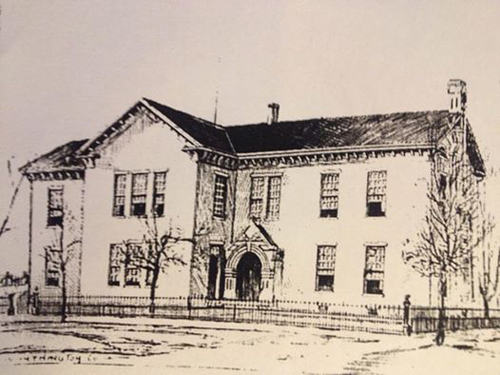
Today the fabulous librarian June Denning here in Mt. Vernon guided me through a new microfilm machine and we were able to crop and make better photos of old newspapers than I have been able to deliver previously. It's a new experience, but we are both learning how to serve everyone better. I marvel at the illustrator who drew these pictures found today.
1880's
Highlights of Mt. Vernon Fair, Including Human Remains.....September 1889
Steamers docked at the wharf bringing in visitors from Uniontown, Kentucky and Shawneetown, Illinois to the big Mt. Vernon Fair east of town. A free hitching area was available, located on the S.W. corner of the fairgrounds with special police hired to watch over the picnic baskets, belongings and teams. The fair had the usual floral garden, big pumpkins and mastondonic turnips to gawk at as well as a display of machinery of the Brinkman, Templeton, and Keck-Gonnerman companies. During the "hoss-races," two boys were run over who got too close to the track. Fearing the worst, the young men were picked up and suffered only severe shock and a few bruises. The spectacle of the fair was "Chanta Tonka", brought in by Samuel Helms. As insensitive as it is today, exhibits like this were part of early fairs. "Chanta" was said to be a genuine human Indian body preserved in a dry state, from the process of "putrefaction, the watery elements of the body being displaced, leaving the solids intact and unchanged." Thankfully curiosities like this....real or fake are no longer part of our "entertainment."
Gatecrasher Dies at Cynthiana Ballpark.....August 1889
A Sunday game in Cynthiana took the life of Andrew Smith when he attempted to enter the grounds without payment. When challenged, he attacked the gate keeper with a knife. Fearing for his life the gate keeper struck Smith with a piece of scantling nearby and Smith died the next day.
Horse Mistakes Greenbacks for Cabbage.....1888
In January of 1888 a rider from Georgia rode into Mt. Vernon and while fetching feed for his horse, he momentarily put his pocket book containing $425 dollars in the trough. Immediately, the horse ate his money. "Dag nabbit!"
Alvin Hovey Offers Sale of Land for City Hall.....August 2, 1887
"To the Mayor and Common Council of the City of Mt. Vernon Ind. As one of the oldest citizens and taxpayers in the city I should be gratified to see a respectable city hall and fire department headquarters erected in any suitable and central locality of the city. The increase in our population and business demand such improvement. I have two lots on Main Street which I believe would be a favorable site for such buildings, lots 122 and 123 in Williams' part of the city. I will sell these lots to the city on long time and reasonable terms serving six per cent interest, payable annually." Respectfully submitted, Alvin P. Hovey The city administration then included O.C. Terry as Mayor, and the councilmen, H. B. Reagin, Henry Brinkman, Geo. W. Engler, F. Tente, E.E. Thomas, and George Henrich, with C.L. Prosser, clerk. They reported favorably to the proposal allowing $4000 for his two lots at Sixth and Main. It was not unanimous as the ayes were from Reagin, Tente, Engler, and Henrich. Bids were received on December 13, 1892 under the new administration of Mayor F.P. Leonard. At first the lowest bid of $6490 was accepted, but the bond was defective and the job was given to the second lowest that to F. Behrick & Son at $7,495. Construction started in the spring of 1893 and in October was accepted by the city as compete. This very same site where years before the Gentry Bros., dog and pony show grew into a large circus once played beneath a small tent, a dozen dogs, a "wheezy monkey" and six beautiful ponies now has been part of our history to this day.
Cold Winter.....1886
In January of 1886, a cold wave ran through our county with strong waves and blizzard conditions. The blinding snow was difficult for all involved including fighting a chimney fire in New Harmony. The fire department couldn't make its way through the drifts. A snow plow was rigged up on the weekend and pulled by horsepower through the streets. A pet alligator, named "Jumbo," owned by Frank Fretageot succumbed to the cold. "All efforts to thaw him out were in vain sadly."
Poseyville Melons.....1885
On a Friday in mid-August twenty-four car loads of watermelons were shipped. It was predicted that no less than 500 cars of the watermelons will be shipped from Poseyville during the growing season. Prices were from six to seven cents each.
Recorded in the 1884 Poseyville News
Mt. Vernon's Matilda Alexander has a new novel coming out based on a divorce called, "From the Kitchen to the Parlor, or In Parallel Infatuation." Mrs. Alexander wrote many books but it seems only copies of two of them exist.
G.V. Menzies Almost Dies of Poison.....1884
While in Indianapolis, the ex-Senator from Mt. Vernon and his wife Esther, daughter of Alvin Hovey stopped at the Grand Hotel. There to attend the editorial association banquet, Menzies ate a hearty dinner, but was struck by severe attacks of neuralgia (nerves) and headache. He had those in the past and used a remedy composed chiefly of bromide potassium in a solution. He sent the bellboy with a vial to the drug store opposite the Grand Hotel to have a prescription on file at that store repeated and the vial replenished. So happens that the clerk was out and a boy at the store filled the vial. Major Menzies took a dose of the sedative as his throat felt like it was filled with molten lead! He immediately pushed his finger down his throat and vomited. Two doctors were called and arrived promptly, and he was given something to empty his stomach. Upon investigation it was found that the boy put into the mixture corrosive sublimate, the bichloride of mercury, the "most violent and corrosive mineral poison available. He took up to 15 grains that doctors said could have killed six men if he hadn't had a full stomach and produced vomiting. Eight hours later Menzies was out of danger, but suffering a sore throat.
Strange Animal Seen Near Marshall's Ferry.....1880's
Near Marshall Ferry or "Dogtown" on the Illinois side of the Wabash River a mysterious animal was seen and heard at different times and different places for seven straight years. Only night has it been noticed and its identity stayed unknown. Hunters would go out at night and their dogs would give every evidence of being palsied with fear and could not be coaxed to venture far from their masters. The noise of the animal is cry like a whistle or scream and instantly the dogs quit the trail and hasten back to their owners. Opinions vary but some think it was a wildcat and others said it was a "painter." I have no idea what that means.
A School Girl's Soliloquy...Rose Alexander.....August 1882
"I sit me in the moonlight, and while I sit I muse; My mind in retrospect the past, The future in proper views. Two pathways lie before me, I see that they diverge; In one, spring childhood's joys bright, In one, a woman's sorrows surge. There is for me no choosing, I would not could not doubt; That the one where surge the sorrows, Is the one for me marked out. I have tasted the springs of the other, I have found the waters sweet; I could not hope that its cup for me, Should be filled to more than meet. But may my walk in womanhood, Be with God's holiest truth, And may I and his lovely care, Meet a woman's joy, a woman truth.".....Poem by the daughter of Matilda Alexander, our library founder at the "Female College." in Jacksonville, Ill. Rosamond or Rose died at age 28 in 1892 in New York found in the river. Some thought it was a murder and some thought she committed suicide. She was married to a doctor George Peckinpaugh. She is buried at Bellefontaine Cemetery.
Crime and Guns in Mt. Vernon.....1881
Nearing Christmas, lawlessness continued to a peak. An ex-Sheriff, John Wheeler was shot in the neck with a revolver, but was expected to recover. The murder investigation of Nathan Frank continued in a Grand Jury hearing, and Patrolman Miller surprised an intruder after midnight at Matilda Alexander's home on North Main, but the suspect got away with Miller shooting after him. The Superintendent of the City school said: "The parent who desires his child to be cultured and educated without bringing him up as honest, moral and upright will release upon society a refined demon."
"Sham Battle" Put On at Black's Grove.....July 4, 1881
The annual 4th of July picnic at Black's Grove had a few new twists that summer. Old Posey had their Silver Corner Brass Band present and there was a grand concert and dance. The newly formed Mt. Vernon Fire Company was on hand and from Evansville we had the Evansville Light Guard with their Crescent City Artillery. Everybody got to see a little fake fighting and cannon shooting to go with their firecrackers. The grand affair full of political and military speeches only cost 15 cents per adult and a dime for the kiddies.
"Cat Fight" On Main Street....Ding, ding, ding, ding....1880
Like an earlier version of the Jerry Springer Show, the entertainment for the week was an altercation of two young attractive women on Saturday morning scratching and clawing on Main Street. In front of the Rosengart store, the two had bitter words then resorted to physical combat. "They hit and kicked and flailed about, they screeched and scratched and spat, they pulled hair, and finally they tore off each other's clothing. No one tried to stop them and the spectacle collected many male onlookers." ......"Jerry, Jerry, Jerry, Jerry."
G. V. Menzies.....c.1880
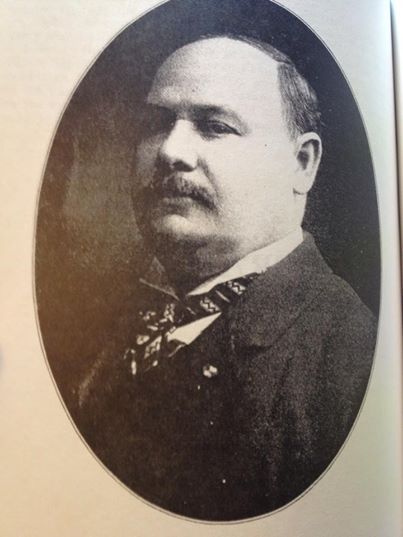
Menzies was a naval officer during and after the Civil War. He became a lawyer and came to Mt. Vernon in 1869 and married Miss Ester Hovey, the daughter of then native son and Ambassador to Peru, Alvin P. Hovey. It was the Menzies who lived in what we call the "Hovey House" on Walnut Street. He was a Democrat, unlike his famous father in law Hovey. Many times he was a delegate to the Democrat conventions. In the Baltimore Convention he placed the name of Thomas Marshall in nomination for Vice President under Woodrow Wilson. It was said he speech was "clever and able." In 1884 he made the motion to make Grover Cleveland's nomination unanimous. Menzies was elected to the State Senate in 1878 but was defeated twice for U.S. Congress. He was appointed several times by the state of Indiana for special commissions.
1870's
Grave Robbers....Evansville.....January 1879
In 1879 the Evansville Journal newspaper reported the finding of a body found on the dissecting room of the Evansville Medical College, The paper reported, "Mrs. Murphy was packing up her household goods in preparation of moving two weeks after her husband's death. A letter carrier dropped by and gave her a letter of which she put into her pocket for about an hour. "Opening it, she read, "The doctor is cutting up your husband's body, corner of 5th and Vine Streets. If you go immediately, you can save him!" Signed S.J. She found a police officer, Hitch, and entered the building. The janitor or maybe a student directed them to a room where a woman and a Negro were laid. Going to another room down the hall, she found her husband on a dissecting table his skull sawed off and the brain removed of Francis Marion Murphy.
Courthouse Cannon Moved by Lynch Mob to Depot to Fire On Possible Militia....October 1878
Every time I think I have written the last of the 1878 mob lynching in Mt. Vernon, something else comes up. Looking in a book called, "The Negro in Indiana Before 1900," published in 1957, I find something new. They reference a story printed in the Evansville Journal newspaper and reprinted in the Indianapolis Journal of October 12, 1878 new items. The story goes as all others of the Negroes with the white prostitutes. Four of the suspected five men were arrested and when an attempt was made to capture the fifth man, the father shot a deputy sheriff and the son escaped momentarily. The old man was jailed. A rumor spread that the Governor was sending a contingent of the militia to Mt. Vernon to avert trouble, but "trouble" was already here. According to the article, "two hundred men armed with pistols rushed to the RR depot and hauled with them a cannon from the courthouse lawn and set it up opposite the train station and threatened to fire upon any militiaman who might come." None did. Meanwhile, the jail had been breached and the masked men took out the prisoners and hung them on the town square. The old man who shot the sheriff?....Well, it was said, "he was butchered and his body cut to pieces by relatives of the man he had shot." Legend has it he was thrown in a privy in the court yard. His son was captured at the train station and thrown into the train fire box. The crowd then dispersed, and apparently no effort was made to apprehend any of the participants.
Poseyville Celebrates Nation's Centennial.....July 4, 1876
An old-fashion barbecue was put on for the citizens of Poseyville and visitors estimated from a 3 to 5 thousand in attendance. Orators Henry Clay Gooding and Cicero Buchanan of Evansville spoke. Martin Golden of New Harmony read the Declaration of Independence. It was reported that "he received great praise from everyone for the able manner in which he executed the task assigned him." (Martin Golden was a member of the Golden troupe who toured the country) Mr. Wehr read a history of the town and the nearby vicinity. The "Stars and Stripes" were raised on all private and public buildings in the town, there was a parade or procession and the audience sang, "My Country 'tis of Thee." The New Harmony Band was on hand for entertainment and after "toasts and responses" they fired off 37 guns. So, there you have it....The American Eagle and all its trimmings on a gala Fourth.
Wild Creature Escapes Man in Stewartsville....January 1876
A wild beast was seen two miles northwest of Stewartsville sending thirty to forty men scouting the hills in search of "his majesty" and even more at night with torches. Described as having a mane his body being about four feet in length and of yellowish color. Some felt it was part of P.T. Barnum's menagerie that had been in Evansville. Others thought someone was starting their own exotic animal zoo. Whatever, it caused quite a stir. It was shot at twice; one they thought hit the animal in the hind quarters, because the animal made a mournful cry as soon as the gun was discharged and "manifested an offensive spirit." New Harmony Register said that they need to catch the animal and start an exhibition in Bugtown. He went on and on about rail cars coming in from Cincinnati, and boat by Louisville. Nothing ever seemed to come of it.
Former Slave Dies - Had Sad Tale.....1876
A Negro by the name of Jerd born around 1790 was brought; along with his family to Indiana with "his master" Camma Johnson before Indiana was a state from North Carolina. Freed because this was not a slave state, Jerd and his family were kidnapped and put back into bondage in the South. One day Jerd "ran off" and returned to his former master here in Posey County. His family never was heard of again. His master, a really old man, announced regret that his companion had gone and considered him "like family."
Fighting Sitting Bull....Posey County Was There.....1876
The Little Big Horn or "Custer's Last Stand," has been examined by historians since that time. Modern historians look back on it today with sympathy for the Native Americans who were pushed almost to extinction. I won't get into the politics of the times or Manifest Destiny, but several Posey County soldiers were present in the area at the time. A John Cox from Evansville wrote of his experiences in 1921 and said he "marched and counter-marched, chased wild Indians and been chased by them. They always found me to be a good runner and I confess that I was badly scared a good many times." Cox was the great grandson of Revolutionary soldier Thomas Price and on his tombstone near Stewartsville it reads: "Wounded by an Indian arrow in the Lewis battle.' Frank Lintz was a Posey County man who fought the Lakota for three years, but Cox did not serve with him. Cox said there were several regiments operating in Indian country at the time. Henry Huber of Posey County was a soldier in a fort on the east bank of the Missouri River just below the Cheyenne Indian agency. As Cox's unit hurried up the river on a steamboat he passed Huber's command and saw him on the bank of the river, but never saw him again. Tom Varner of upper Posey County was a trooper in the 7th U.S. cavalry and was with Major Marcus Reno's battalion when it charged the Indians and "got badly licked." He was with the few survivors of that command which were entrenched on the hill and stood off the Indians for 24 hours before General Terry and Colonel Gibbon rescued them. Thirteen Medal of Honor awards were given to Reno's men. In the fighting Varner was severely wounded, having part of an ear shot away. He was forever after slightly deaf. Cox visited him in the hospital. Tom Bundy, living in New Harmony in 1921 was an infantryman in Col. Gibbon's 7th U.S. infantry. Cox said he was awarded a "certificate of merit" and a medal for out of the ordinary military service. On one occasion while guarding a herd of cavalry horses he had a duel with two Indians, killing an Indian and having his own horse wounded. When help arrived he was seen scalping the Indian.
Allowances Paid.....1876
You know those statistics the newspaper put in every so often of expenses paid that few look at? I decided to look at one and see what the Board of Commissioners of Posey County was paying out. There are quarter salaries for physicians to several doctors for $2.50. A Coroner got a 5 spot, and if you served as a juror you got 75 cents. A few coffins were purchased for paupers from Weisingers for $9 each. It cost $5 to bury a pauper. The superintendent at the Infirmary got a quarter salary of $425 and several roads and bridges in the county got attention from anywhere from $25 to $121. Finally, lots of people got paid $1.50 a day for "viewing roads." Anybody have an idea what that might be? Two men got a quarter to swear these road viewers in too.
In Search of Civil War Soldier Who Died of "Intemperance"....1876
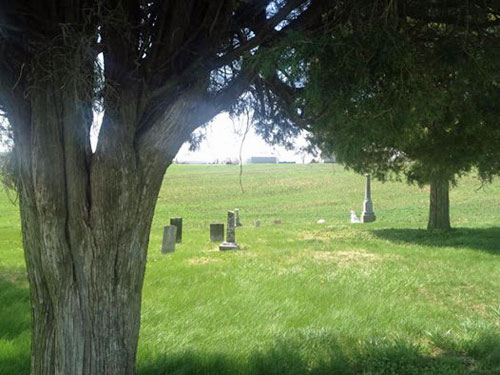
Today I wandered out in the rolling old field section of Mt. Pleasant cemetery near Bufkin. I was looking for an old soldier I had read about, whom I will leave anonymous, who was found dead along a road. When this fellow, described as a German, was found his body was in such a state of decomposition that it could not be taken to the burial grounds. A shallow grave was dug and the body deposited. Nine years later the G.A.R. visited the makeshift grave and gathered all his bones and buried him at Mt. Pleasant church. I was not able to find a stone as many are covered with brown substances and are turned over or broken. They said Fred was a good soldier through the war as a member of Company F, 80th Regiment, Volunteers and was in many battles. His demons must have remained with him afterwards. An article said his grave would be appropriately marked with all the other soldiers laid there, many unmarked. I checked the cemetery files and he was buried as they say, but I wasn't able to find the location.
Christmas Shoot 'em ups.....1875
Well Christmas 1875 in Mt. Vernon passed without anyone dying of firearms, but the noise was loud from all the burning powder into the air. There were two or three instances where some men decided to break windows on the business district and scared unoffending citizens with their weapons. "We of the Western Star say that if the proper authorities cannot, or do not, punish such acts, then our people who love peace must form ourselves into a vigilance committee for the protection of property." I guess that would be what they called themselves three years later when they hung people from trees at the courthouse lawn, huh?
Fights, Revolvers and Brickbats as Courthouse Rises.....Spring of 1875
Business is booming as the new courthouse rises. Saloon keepers, livery men and hotel proprietors are rejoicing as workers need lodging and a whiskey. Learned lawyers are doing a good business also as is the judge and jury. "The revolver is a good thing, in its place...take the barrel off and give it to your boy to blow soap bubbles with. A brick-bat is also a very good thing in its place....the sandy bed where the mason once so carefully placed it and not to one's skull."
Sighting of Jesse James in Bufkin.....1870's
In one of my earlier volumes I told of the James Gang being in the area and sleeping overnight in a farm house. The farmer was gracious to the gang. They took turns sitting in the window all night on guard. The farmer had a pretty little daughter and on leaving Frank James gave her a golden coin. Years later in the early 1900's Frank was passing through with the horse circuit and started a race at the Mt. Vernon fairground. A man approached Frank and told the story of him and Jesse at his farm. The man turned away to leave and Frank said, "How is the girl? She must be a fine young lady by now." Here's another story or version. The James brothers came into Bufkin before people knew them. Jesse visited a blacksmith and had his horse shod and a young girl told Jesse he had a pretty horse and Jesse smiled and gave her a silver dollar. The two men came into the village saying they were lecturers gathering data. It was reported they stayed in local homes for several weeks and they had planned to rob a Mt. Vernon bank, but that never happened. While in town, one of the dogs Jesse had with him got into a fight with one of the local's animals and the local man killed Jesse's dog. When he heard about it Jesse mounted his horse, rode over and shot the local's dog in his front yard.
Cynthiana Correspondent Goes Off On Pistols.....1875
A couple of men from Owensville rode into Cynthiana on a Sunday and fired off their pistols as if they were in the land of heathenism. The reporter called on the Marshall to " git rid of such scoundrels." He went on: "We hear it talked of among our marksmen that they are going to have what is called shooting matches, during the winter, at this place. Let the first one be the last, and the last one the first, by fining every one that indulges in the like. We are opposed to such barbarous treatment of the fowls. We want the world to know that we live in a land of civilization instead of a state of barbarism." An answer came back..."the scribbler is not responsible for what he writes; he is under the influence of love, at least a person would think so, to sit and hear him explode his big bag of gas."
Sin City.....1875
A shanty on the western part of New Harmony had for a time been occupied by three or four women, who let us say, did not walk the "proper" line of moral decency. The building was torn down by a number of people who used the fire department's hooks and ladders for the occasion. The New Harmony Register newspaper regret the "social evil" in their midst, but said that there were legal ways to get rid of it without resorting to what bordered on outrage and mob violence. I wonder what became of the poor unfortunate defenseless women of the night?
Stewartsville Gatherings.....1875
The M.E. Church was filled for a wedding and the school house was near completion. Some residents were disturbed of an old stable that had been converted to a saloon and gambling den and "used on the Sabbath too!." The world may have been growing better, but alas, poor Stewartsville. Won't something be done to arrest these immoral tendencies was the cry. Stewartsville is still located there, time notwithstanding.
Susan B. Anthony in Mt. Vernon in 1870's?...I'm Trying to Find Out!
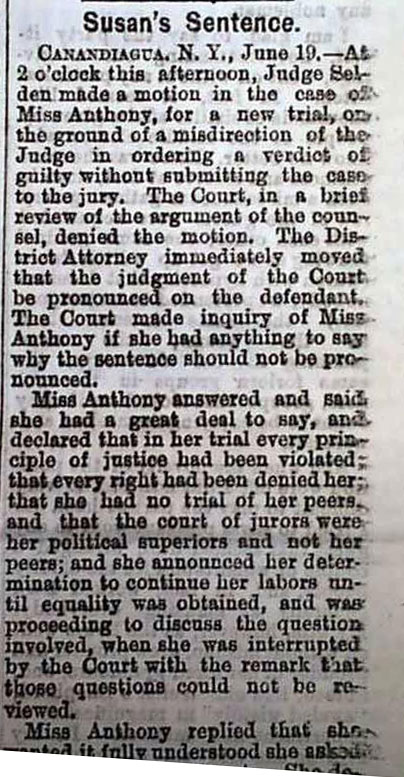
I have a clipping that says suffragist Susan B. Anthony was scheduled to give a speech in Mt. Vernon on October of 1871. I have not been as yet able to confirm it. We had so many visitors giving speeches in the 19th century and it is not as strange as it may seem that it was not covered by the newspapers. I know she spoke in 1870 in Bloomington, Indiana and twice in 1887. How great would it be to prove her visiting our community to speak? She was an abolitionist, social reformer and suffragist and promoted the vote for African Americans and women. The Evansville Daily Journal of June 20, 1873 had a story of her on the front page being tried for illegally voting in the 1872 Presidential election.
New Synagogue.....1875
In 1875 the thirty something Jewish families of Mt. Vernon representing about 200 people took the name of their congregation to be..."Anshe Israel,: or Men of Israel. In 1886 they dedicated their synagogue on Main Street representing the hopes of those who came before them before 1850.
Hell on Earth as Mt. Vernon Braces for Cholera again....March 1874
If it wasn't bad enough the Temperance Movement was converging its focus on Mt. Vernon crusading in front of taverns beating tambourines and praying. Drunks just laughed, danced a jig and tried to get the ladies to come into their evil dens. So when they weren't gathering signatures to petition the Commissioners the town was busy distributing a hundred barrels of lime to be spread in the streets and oil to be burned on the corners.
Fair Review?.....March 1874
The Choir of the Mt. Vernon African M.E. Church, singing with the "Neutral Band" from our town gave an evening of entertainment in New Harmony consigning of "tableaux," (a group of figures representing a story), songs, and instrumental music at the Theater. The New Harmony Register, who was not present, said, "We learn from those capable of judging that the performance was not what might be called a success."
Let's Get this Court House Up.....February 1874
The Board of County Commissioners convened at the present court house in the city of Mt. Vernon on Wednesday, the 4th of February, 1874, for the purpose of letting the contract for the construction of a new Court House. Present was Stinson Cox and Andrew Keck; (Commissioner Merritt was unable to attend due to sickness.) At 1:30 P.M. the Board proceeded to open and examine the bids for the construction of said new court house and took the plans and specifications made by Vrkydah & Clark, architects. The building was to be completely under roof and protected from damage by storms or weather, on or before the first day of December 1874, and be completed by the first day of October, 1875. "Many of the parties that bid for the work were present in court, and in evidence of their satisfaction at the manner in which the business had been conducted, the following resolution was proposed and unanimously adopted." Resolved, that the bidders on the court house work at Mt. Vernon, Ind., hereby tender to Messrs. Vrkydah & Clark, Architects, and to Mr. Frank D. Bolton, Auditor, our kindest regards for their urbanity and continued attention to all our wants while examining the plans and specifications, with the assurance that in life's journey, whether we find the pathway rugged or smooth, we shall remember them kindly. and Resolved, that we leave Mt. Vernon wiser if not richer men, and part with the kindliest feelings to each other." Man, they sure were sweet on each other! Bids I saw came from Covington, Indiana, Henderson, Kentucky, Cairo, Illinois, Indianapolis, three from Evansville, Metropolis, Illinois, and R.G. Thomas here in Mt. Vernon. Bids were said to have ranged from $74,000 to $150,000.
"I don't want no woman with no skinny legs"......1874
And the editor says: "If any lady wishes to grow fleshy, a pint of milk taken before retiring at night will soon cover the scrawniest bones. Although nowadays we see a great many fleshy females, there are many lean and lank ones who sigh for the fashionable measure of plumpness, and would be greatly improved in health and appearance could their figures be rounded with good solid flesh. Nothing is more coveted by thin women than a full figure, and nothing will so rouse the ire, and provoke the scandal of one of those clipper builds as the consciousness of plumpness in a rival." And ~Wavy loves curves too!
Boys and Pistols,...Los Angeles Herald Editorial....1874
Yesterday at noon a boy sixteen years of age shot himself, or was shot by his brother. It matters not who fired the fatal shot. No criminal act was intended or committed, and the boy is dead. He was a member of the High School of this city and was, we are told, something over the average good boy of Los Angeles. This boy lost his life through the too common habit among boys of carrying deadly weapons. We do not know that school teachers have the right, or would exercise it if they had, of searching the pockets of their pupils, but it seems almost a necessity that some such rule be enforced. The hills west of town are not safe for pedestrians after school hours. Nearly every schoolboy carries a pistol, and the power of these pistols range from the harmless six-bit auction concern to the deadly Colt's six-shooter.....
The Last Hours of MV Cholera Victims.....Summer of 1873
That summer close to 80 people died from Asiatic Cholera in Mt. Vernon. They say over one third of our population left town. The newspaper said there were preventive measures that were worthless...chloride of lime, carbolic acid, something called copperos, antiseptics and deodorizers. Quinine was big and was given out by local physicians. It was believed that cholera was a disease generated from poisonous vapors and rubbish heaps. As the summer wore on, after a wet spring, concern about cholera became widespread not only in southern Indiana but the entire state. Everyone was hearing about the dreaded intestinal disorder with its uncontrollable diarrhea and dehydration that brought about unbearable cramps and the body turned black. An epidemic hit a town called New Elizabeth too that summer in Indiana. Doctors put hot bricks against the feet and propped their heads high. Bodies were bathed in a strong camphor solution and barrels of coal were burned on the streets. Farm people tried to avoid Mt. Vernon entirely if they could, and some businesses did not open. Cholera was indiscriminate hitting old, young, sickly and healthy. People found out that anyone having cholera would die and anyone in contact with the sick may be doomed also. In pain the victims tried to prepare for death in hours. Last minute confessions were heard and forgiveness asked of God and loved ones. Property and possessions were passed and finalized. A general gloom pervaded over the community. I think the cholera did not have a common source in Mt. Vernon. It may have got here first by a victim taken off a steamboat, but it is likely the out houses contaminated the spring stagnant water and the disease was spread by people handling sick people and soiling their hands, not washing well. The incubation period of the illness is short...the plague became part of our history and was recorded even in the New York Times.
For You Cold Sufferers...An Old-Tyme Remedy.....1872
Hey I's a "Creapie", great grandfather of ~Wavy~ and I's a been troubled for over 20 odd yars with some sort of crupe they call bronco something infection. At times I wuz bedfast with fever and suffered from bed sores and my side ached all the time as did my kidneys and back and stuff. I wood have ben dead long ago without Dr. McLean's Liver and Kidney Balm filled with honey and tar. I downed a pint and found it was helping me sum and by the time the second bottle was gone I was well and have been ever since. So when Dr. McLean comes back to town with his peddler cart, see him down on the public square and buy a case. By the way, somebody asked me where I find all my information...I said, "sometimes I make shit up!" ....dee dah
Evansville Town Characters - "Hunky Dory" and "Onion".....1870's
I like unusual people, especially happy unusual people. One was Hunky Dory, a stout, little woman who would sit near the wharf boat with a basket of apples on her lap. When asked about her apples she would reply: -" they bin all hunky dory." She asked not for charity and was there summer and winter. Another was Onion. He was a bouncer and general laborer at a saloon along what is now Riverside Drive. It was said he lived mainly on onions and whiskey. At night he slept in the saloon, but would let river rats and tramps lodge there on the floor by the stove as long as they cleaned the place up and left before the next day's opening. One day Onion was missing..., legend says he tried a drink of water and died. Oh there also was "Billy Ha Ha", he followed every sentence with a laugh. Like.. " I fooled wifey, Ha Ha. She gave me a quarter to ride to town and I bought some tobacco with it. Ha Ha." Playing pool he would miss a shot by a mile and say: "Close ,Ha Ha. "
G.W. and E.E. Thomas and Some of their Mt. Vernon Legacy 1850s-1900
George Washington Thomas came here as a young boy with his parents around 1814 or 1815 when this was still a territory. They first settled a few miles from town until the father George W. Sr. died. G.W. Jr. moved to Mt. Vernon in 1856 and lived in the building that was the first post office in Mt. Vernon on the corner of Second and Store. That place was built by the first postmaster, Jesse Welborn in 1818. G.W. became interested in flat boating and got engaged in the wharf boating business and ran it for decades. It was called the "G.W. Thomas." He also was involved in steamboats having an interest in at least two...the "Robert Mitchell" and the "West Wind." With very little formal education he became an important Democrat figure in Mt. Vernon. Besides being the wharf master, he was the superintendent of the construction of the new courthouse finished in 1876. He was elected to the State Legislature in 1849 and was Posey County Recorder from 1864-1868. One of his sons, E.E. (Enoch) carried on the wharf business and was an agent of the St. Bernard No. 9 Coal and Kindling Wood Company with an office at Second and Mill Streets. He was considered honest, frugal and capable and was elected to the town council in 1884. His background in river interests and honesty made him the logical choice for his party's nomination for Mayor in 1888 and he was elected. He transformed the city that was undergoing growth and was very efficient with the city's business. In 1882 he quit the river and opened a coal yard. In 1894 his party asked him to run for Sheriff and as always the public spirited man put Posey County first and did a good job.
1860's
Murderer Gets Off Because Jurors Drank Beer.....1869
John Leunig ran a General Store in Mt. Vernon back then and there was a card game going on in it one evening. Something happened and Leunig was killed. During the trial of the accused the judge sent the bailiff out to get some water for the jury. Instead he came back with a bucket of beer. The judge called a mistrial and the suit was transferred to the Vanderburgh County Court which ruled the case a trial by double jeopardy. The Indiana Superior Court upheld the ruling and the accused was released.
Pitcher home built by Judge Thomas Pitcher.....1867
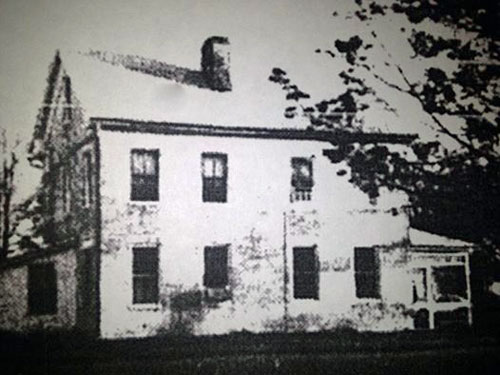
I believe he built the home for his daughter in 1867. 530 College Avenue. Burned in 1990's.
Governor of Indiana 1861-1867
Oliver P. Morton (R) was a controversial governor, but some say he was one of the state's finest. He strongly defended the Union cause and even sent speakers to Posey County and other close by counties to speak the cause of the North and to suppress Confederate and Copperhead sympathizers. Copperheads were the "Peace Wing" of the Democrat party. He prepared the state for war before it actually happen and established a state arsenal and had ammunition and arms manufactured without legislative permission which was unconstitutional. The Democrats in the state rebelled against Morton and he accused them of treason, General Henry Carrington was sent to Mt. Vernon and was basically an intelligence man to weed out those who did not support the union cause. Arbitrary arrests and suppression of freedom of speech was common place where southern strengths were strong yet still a minority. Morgan's Raid was suppressed by an illegal calling out of the militia in July of 1863 of which Mt. Vernon helped supply men. After the war, Morton was at least found to have run a government without graft. He later served as U.S. Senator and championed the 15th Amendment which does us all honor. He supported women's suffrage and he was known to have been a "player."
Mt. Vernon Mentioned in "Geographic Dictionary of the World".....1866
Lippincott's Pronouncing Gazetteer, authored by Joseph Thomas had this to say about our community: "Mt. Vernon is a thriving community in Posey County on the Ohio River. It carries on an active trade, which has been increased lately by the construction of a plank road to New Harmony. Mt. Vernon has three or four churches, an academy, and a newspaper office. Population in 1863 was about 1500."
The Hornet Incident of 1866
A group of mischievous boys were playing on the wharf front of Mt. Vernon when a boat load of passengers landed nearby. The young boys started throwing mud balls at the elegantly dressed travelers and were having the time of their lives. One of the travelers upon seeing a hornet's nest hanging in a tree near the boys whipped out his revolver and shot the nest down. The passengers were greatly amused at the turn of events, "loudly voicing their pleasure in anticipation of the boy's discomfort." The momentum changed again however when one of the lads picked up the nest and tossed it aboard the boat. A near panic resulted as the hornets swarmed out into the guests. A number of passengers either jumped or were pushed into the river, but no lives were lost....not even the local toughs making their sudden and rapid departure.
G.A.R. in Mt. Vernon.....1866
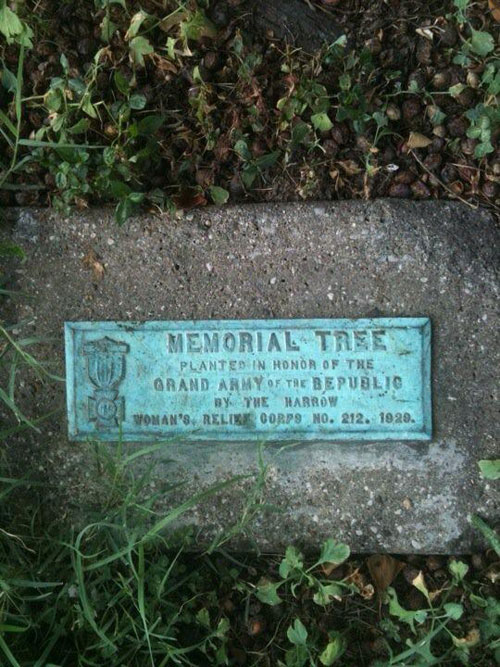
Following the end of the Civil War the G.A.R. (Grand Army of the Republic) was organized in 1866. The G.A.R was an advocacy group for voting rights for black veterans, and for pensions for veterans. Mt. Vernon once had two organizations of which one endured....the Harrow Post #491 to preserve the memory of those who fought for the Union from Ft. Sumter to Appomattox. The local group once numbered over 200 at one time.
Mt. Vernon Born Reaches Rank of Lieutenant-Commander.....1866
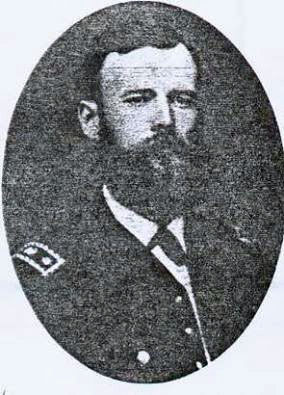
Moses Sherwood Stuyvesant was born in Mt. Vernon, Indiana on August 17, 1841. His parents moved the family to Cincinnati, Ohio where young Moses was appointed to the Naval Academy in 1856. At age 19 in 1860, he graduated from Annapolis and served as midshipman on the U.S.S. Paunee and the Powhatan in the Gulf of Mexico. He later was transferred to the wooden sail ship the U.S.S. Cumberland under Commander George Pendrgrast. Speaking fluent Spanish he served as an interpreter between the Commander and the ruler of the area, President Juarez. In 1862 the Cumberland was shot full of holes by artillery from the ironclad Merrimac. As it was sinking he was asked if the U.S. flag should be taken down from the vessel. He said, "No, the ship will sink in fifteen minutes, and she will look a damn sight better with her flag up!" Wounded in the arm he helped command two crews of survivors with land guns the next day during the battle between the Monitor and the Merrimac. He reached the rank of Lieutenant Commander in 1866 aboard the steamer, Miantonomah. His career took him across the Atlantic to the North Sea, the Baltics, in the Mediterranean and to Peru. He resigned in 1868 and studied law. He died in St. Louis in 1906, the year my Sox beat the Cubs in the World Series.
Never Heard of the "Dixie Star Spangled Banner"...Until Now.....1864
We have all heard of "Dixie", but I never heard of lyrics for the Dixie version of the Star Spangled Banner until I was reading about a confederate prisoner at Camp Morton in Indianapolis during the Civil War. In his journal he would speak of the weather, his treatment, rumors, work details, music and any news he could find. Here is the last verse: "Oh thus be it ev-er when heroes shall stand. Between their loved home and wild war's des-o-lation; Blest with vict'ry and peace, may the heav'n rescued land. Praise the pow'r that hath {made} and preserved us a nation! Then con=quer we must, for our cause it is just, And this be our mot-to: In God we trust. Chorus was : And the cross-spangled banner in triumph shall wave. O'er the land of the free and the home of the slave."
The Pay of a Civil War Soldier.....
Back in the 1970's I made about $4000 a year as a sergeant in the Air Force. I was looking at the pay scale for 1861-1865. A Union private made between $13-$17 a month and he was lucky if he got paid every month. Sometimes his pay was delayed several months. A dollar in those days is worth $25.56 today. If you were an officer you made from as low as $105.50 as a Lt. to a three star general who made $758 a month. A one star general made $315 a month. One relative on my mom's side was a captain in the Union army, making $115.50 per month and died near Vicksburg, Mississippi. His body was sent home and years later the government provided him a stone and his widow a pension of less than $10 a month.
Returning Indiana Legion Take On Recruits.....July 1863
John Love was an acting Brig. General assigned to Mt. Vernon to help repel Morgan's Raiders into Indiana. A graduate of the military academy in 1841 he made his mark protecting westward expansion of immigrants into Indian country. During the Civil War he trained troops and was sent here and served with John Mann, Colonel of the First Regiment of Indiana. In a letter to Governor Morton and his superiors, Mann said, "In Henderson, Kentucky, General Hovey ordered transports for us to leave for home. We immediately shipped our infantry and artillery onboard the steamers for Mt. Vernon, Indiana." The cavalry were ferried across the Ohio River and began the march back. During the march, some fifty Negroes came into the lines. "By order of Hovey, I had them taken to Evansville and mustered forty of them into the service of the United States. I desire to say here that the officers and men of the 1st Regiment of Vanderburgh and Warrick deserve the high praise for their conduct and worked like a veteran regular troop. I assure you I have high praise of the Legion, the Mt. Vernon battery especially being considered as efficient as most batteries in the regular volunteer service." Things grew quiet since the movement into Kentucky and Mann said, " I wish to say, that the services of the Indiana Legion have been by some greatly undervalued. There is no doubt in my mind but that this organization has spared the U.S. government a great portion of resources and capital that not for these men would have taken away from the front to protect the counties of Posey, Vanderburgh and Warrick."
Mt. Vernon Home Guard.....Here's Some Names.....1863
I found a report from a Colonel John A. Mann who wrote from Mt. Vernon to Major General John L. Mansford about Morgan's raids and preparations around Mt. Vernon down to Slim Island. Rumors had spread that Morgan had crossed over from Uniontown with 500 guerillas and was marching on Mt. Vernon. Mann hurried to Mt. Vernon and found all preparations in ready, but the rumor proved erroneous. This would have been in March of 1863 when frequent alarms were warned of imminent danger to southern Indiana. Hovey was here then too. The Guard was sent to Evansville and met up with others to complete about 500 men. Some of the names were "Mt. Vernon Rifles" under Captain Edward Brown, the "Union Guard" under Captain Philip Peter, the "Independent Guard" headed by Captain Nelson Nettleton, "Prairie Guard" of Captain Nath. Ashworth, "Farmersville Guard" under Thos. Thompson, "Pocket Guard", "Hickory Ridge Guard" and the "Posey Rangers Calvary."
Charles Fitch...MV Minister with Interesting Background..Dies During Civil War.....1863
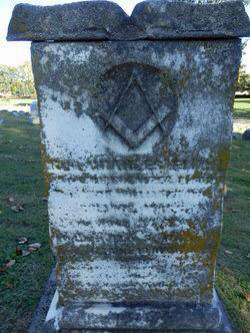
Charles Fitch was born in 1799 and his father was the Reverend Ebenezer Fitch, Founder and President of Williamstown College. His mother's father was in the Revolutionary War and owned a mansion in New Jersey of which was a favorite stopping place for the father of our country, George Washington. Charles was an agent for the American Bible Society, which still exists. In the 19th century it was founded in 1816 and was committed to spreading the word of God and ending slavery. Many known people were members like the first Chief Justice of the Supreme Court, John Jay and even Francis Scott Key, the writer of the National Anthem. Pocket Bibles were given out to the soldiers of the Civil War. Charles in Mt. Vernon was a Presbyterian minister it seems and also was a farmer. When the Civil War broke out, even at his advanced age, he petitioned to become a chaplain and was accepted. He was assigned to the chaplaincy of the 24th Regiment, Indiana Volunteer Infantry with our own Col. Alvin Hovey commanding. He died in the service in Evansville in 1863 and is buried in Oak Hill Cemetery. His son Charles in adulthood moved to New Albany and served as a machinist and engineer for many years on steamboats along the Ohio River.
Son of Posey County McFadden of McFadden's Bluff Murdered as Southern Sympathizer in Missouri....1862
John Sr. McFadden was a son of William McFadden who died before 1812 here at McFadden's Bluff. William was probably in his 70's when he died. According to a family history book by Maude McFadden she chronicles the ancestors of the John Stephen McFadden family who was the father of William. William had settled in Kentucky at a place called Andrew McFadden's Station four miles from Bowling Green. William had married Rachel Hendricks and they were both buried here in a private graveyard it is said on the Templeton farm near Mt. Vernon. No grave markers exist. One story exists about the William's daughter in Kentucky. It is said that Martha shot an Indian trying to steal horses out of the Station, She shot him through a porthole in a wall of a structure. The dates are in conflict. It was during an uprising either in 1786 or 1793. Maude says that the W.P. Leonard, "History of Posey County" book has the story wrong. Leonard places the location somewhere in Indiana and before or during the War of 1812 and has her sister Mary as the shooter. Anyway, Martha comes here, and was also known by the name of Patsy and she married three times, including two cousins. Okay, let's skip over a bunch of kids that moved all over the country to John Sr., son of William. John first moves to Owensville, Indiana and later to Lexington, Missouri. It was here on October 4, 1862 that William, a southern sympathizer who spoke out publicly for secession flew the Stars and Bars from his front porch. Northern supporters took him out to the cornfield and murdered him leaving him to be found by family.
Socialist New Harmony Reformer Becomes Gun Buyer for Indiana.....1862
Robert Dale Owen of New Harmony, carried on many of the beliefs of his father in the utopian village of New Harmony, writing a socialist and anti-Christian weekly called the "Free Enquirer." He was an opponent of slavery, in contrast to much of the Democratic thinking of the time. After a great political career pushing education, birth control, women's rights he wrote President Lincoln to end slavery on moral grounds, three years before the Emancipation Proclamation. During the Civil War he served in the Ordinance Commission and the Freedmen's Bureau. Indiana's Governor Oliver Morton commissioned Owen as an agent of the state after war broke out to visit the Eastern states and Europe to purchase arms for volunteers. He was not supposed to exceed six thousand rifles and muskets or one thousand carbines. However he was so successful that for the same price he had purchased 30,000 English Enfield rifles, 2731 carbines, 751 revolvers and 797 cavalry sabers. A problem however was finding ammunition early on in the war. Morton had a munition plant manufacture the bullets on Market Street facing the State House. Soon 80 men and 16 women were working full time manufacturing shells, mini bullets, and six pound balls.
~Wavy Trips Back in his Time Machine to 1861
After two previous trips back to McFaddin's Bluff I decide to go back again and see how civilized my town is now. Dusting off my old fringe hippie duds I set the controls for July of 1861 and end up at Fred Hagerman's handsome brick farm house just west of town. Beautiful lawn and tall shade trees, I ask to see if he is hiring any hands. Well, the old man 'bout werk the hippie to death! He had me feading 18 hawgs and I's hafto pack water to them which is an up hil business. I werked his fields putting out a fare crop of korn and I picked appels and I took care of the cattel. Got sick for a time when I heped the chimbley builder build two chimbleys and one flue. Got very hoarse with a bad ass cold. Took some of that Dr. Mendethal syrup to get rid of the crud. I read the Mt. Vernon Union paper whenever I go into town and find one laying 'bout. We have had several months of war with blood shed, deth & distress. The home guard is starting up moving cannons up to Haw Hill. Lots of talk of Rebs, man named Morgan in Kentucky doing raids. I's not much of a fighter and they are starting to look at me like I am a slacker. Will have to go before long. It is very strange that we intelligent people as 'mericans cannot settle a question without resorting to the soard. The papers say there was a great uneion vicory somewhere in Tennessee. Rumors spread and the papers aren't all that reliable. People are figity. I perhapse I shud be goin, the weather is turning cooler, the cattel fat, and melons need picked. Gonna hed back soon before the lection. I already new that Lincoln will be beat'n in old Posey. We's might fight for the uneion, but many will not vote for the republican obolitionis. One old fellow down the road he joined the Confederate army rather than be drafted by the uneion. They say he is one of the fellas with John Morgan romping through Indiana and Ohio. A few people in Mount Vernon opposed the war altogher and thes spent upwards to $400 to buy a substitute. No one wants to be drafted, but many have joined. All quotas have been met. Nobody in town that's men but the very young and very old. ~Wavy stands out like a sore thumb! I guess I better hurry up and leave...Mr Haggermann has been real nice to me overall...got myself in decent shape but I must depart before I get fitted for a yoke and chains. The town is pretty deploreable still yet...buildings on Main are all shacks and mostly one story frame buildings. I gett'n tired of lookin where I step. Headded on home....away from the misery that's here. Oh Lord I pray you will safely deliver me out of this affliction & give me grase and suporte in my trials and tribulations. Maybe one day another trip. I miss CNN.
1850's
Famed Astronomer Born in Mt. Vernon.....1858
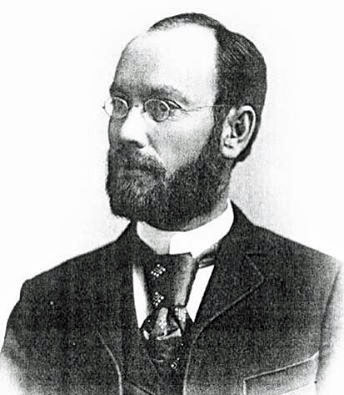
Francis Preserved Leavenworth was born here near the banks of the Ohio River in Mt. Vernon in September of 1858, He went to public schools here it seems then headed to Indiana University where he got his B.A. degree in 1880. His work took him to many locations and observatories especially at the University of Virginia. With several other men he is credited for finding many objects with telescopes, He later became a professor of Astronomy at the University of Minnesota. An article on him appeared in "Popular Astronomy" magazine in March of 1929, soon after his death in 1928.
Traveling Anti-War Evangelist, Great-Great Nephew of Benjamin Franklin Debates Baptist Minister in Mt. Vernon.....1854

Benjamin Franklin was his name, like his great-great uncle. His great-great grandfather was Ben Franklin's brother John. Here was a man who traveled widely until his death at 66 in 1878. A minister who accepted the Bible at face value when it was translated correctly. It was said over 10,000 people gave their lives to Christ through his ministry and countless churches were formed. He took river boats, rode horseback, trains and wagons to his next engagements. He was very much in demand as a writer and speaker, before, during and after the Civil War. In Mt. Vernon he debated a Mr. Joel Hume, a Baptist minister about baptism and the possibility of falling from grace after conversion. When the Civil War started he refused to endorse either side. He wrote in his publication, "Reform": "We cannot always tell what we will, or will not do. There is one thing however which way things may turn out or whatever may come, we will not take up arms and fight and kill the brethren we have labored to bring to the Kingdom of God. Property may be destroyed and safety may be endangered, or life lost; but we are under Christ and we will not kill or encourage others to fight and kill the brethren." His views came under review by the government and some called it treason. He made compromises by not writing anymore about refusing to fight in his publication, but continued to speak out in the churches and debates. He was a U.S. citizen he said, "And I will preach to both the North and the South because my allegiance was to the Prince of Peace rather than the God of War."
Wadesville Named After Headcount it Seems....1853
Wadesville according to John C. Leffel in 1913 was laid out by Daniel Leffel, James Pelt and William Moye in 1853. Now squarely in Center Township, it was once in Robinson. It had an earlier name of Cross Roads. I like that! Makes sense, like Solitude or McFaddin's Bluff. After a while, somebody must of got up and said something like: "Hey folks, we got a doctor and business house, a blacksmith shop and we need to think bigger with a more appropriate name." They must have brain stormed for a period with nothing catchy. They decided to have a town census and name the town after either the Wade's or the Cox's. There happened to be a few more Wade's so...."Wadesville." Reminds me of a cruise I took to the island of St. Martin/St. Maarten. It seems part of the island belonged to the French and the other...the Dutch. Instead of a war they decided to set the boundary by having two men march from opposite coasts towards the center. When they met that was the boundary line. Divided not quite 50/50, but no bloodshed.
Young Poet Buried at North-McFaddin Cemetery....His Fallen Stone Hidden Forever from his Fellow-Man....1853
"How cold to us this world appears, when no sweet voice is heard. To claim our triumphs and to speak a kind approving word. But Oh! When all we have below, Stern Death in ruin lays, We'll hear once more, as soft as yore, the voice of other days.".....That is just a part of a poem of the author born in Mt. Vernon on April 29, 1827, the son of Jesse Y. and Elizabeth Welborn. He was born in the Welborn home on the south side of West Second Street remembered as the "Farmer's Hotel." The home was shadowed by ancient trees of a long ago forest with spacious grounds. Here George York Welborn studied for a future he would never see. At age 19, he was a law student in the office of future Governor Alvin P. Hovey. In 1849 he was in the freshman class of Ashbury University and died January 25, 1853. It was said in college that he was a favorite, a man of high ideals, cheerful, with winning manners. Greencastle loved him. A professor there said he was all that was manly and good, a good prose writer and learning poet. He wrote many manuscripts dated in 1852. That was the year his mother passed and it was said a year that a love affair went by the wayside. He was said to have had premonitions of an early death.....A man of promise that we can't bring him back; but a part of him, "a voice of other days" ....we can.
State of Origin of Posey County Negroes.....1850
Statistics were formed in 1850 for the first time of Indiana's ethnic and racial minorities. At that time it was said that in New Harmony the prominent language was still German. In this census, blacks were referred to as "free-colored." Only 11,296 were in the state a percentage of 1.14%. The percentage was actually low in all what was then the Northwest states. Only Ohio was double Indiana's at that time. We were a free state, we were close and accessible from the South and there were many broadminded Quakers in the state willing to help freeing slaves pushing them all the way to Canada at times. Many burdens were put on the blacks in Indiana. Their mobility and social climate was limited. If they couldn't guarantee their ability to support themselves they were often pushed out. They could not vote, join the militia, testify in court against whites, send their children to public schools and they had to register with the clerk of each county they lived in. I have written previously of the surnames of Posey County of that time. The state constitution of 1851 inhibited them even more. Now blacks were not allowed from even settling in the state! Posey County had 31 African Americans at that time who listed Indiana as their place of origin (being born here), 19 from Illinois, 13 from Tennessee, 12 from North Carolina, 6 from Virginia, 3 from Georgia, 2 from Kentucky, and 1 each from Ohio, South Carolina and Maryland. The total percentage was 0.77 for the county. Blacks were more welcome in more urban cities where labor was in shorter supply. They also found help along the river as laborers. Blacks found out then that they got along best with French citizens and the Quakers in the central areas of the state. The largest percentage of black, fewer than 5% lived in the counties of Knox, Vigo, Randolph and Wayne counties. Almost 40% of the black community then was born in Indiana. Very few blacks were listed as foreign born. I would have thought of Africa, but only 4 were named. 5 born in Canada, 3 from South America, 2 from Mexico,2 from the West Indies, 1 from Bermuda, 5 from England and 3 born at sea. 52 others did not know their birthplaces. Native Americans were not counted and there was a disparity of those of Asian and Hispanic origins as to whether they had been counted by the term "mulatto" or not. It's difficult to read these things at times. Counting individuals, separating them by race knowing full well the climate of the day. With Indians the canvasser in several counties tried to separate "full or partial blood" by placing an "R" for color for the "full" blooded. Today we still X blanks of race on forms. I hope it is for better reasons then the past.
Robert Dale Owens Plan Of A Toll Gate House For A Plank Road...1850
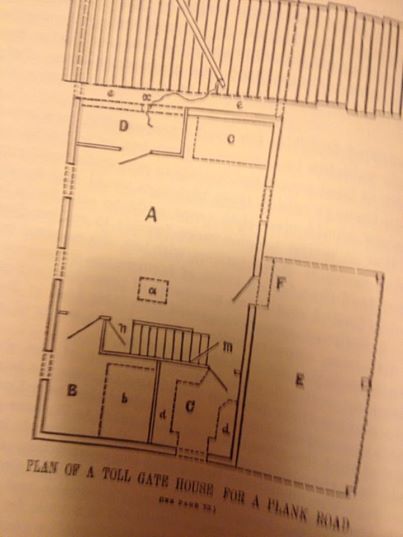
This could possibly be a drawing of a toll gate house used on the Old Plank road between Mt. Vernon and New Harmony in the 1850's. Owen of New Harmony designed the following in the toll gate house: There would have been three toll gates along the way. A. living room; B. Bed; C. recess for a single bed; d. shelving; D. portico; E. summer kitchen; e. steps; m, attic landing; n, cellar landing. He estimated the cost of the units at $350-$400. The plank road turned out to be really a failure, both here and across the country. Years later rigid surface roads came and then the internal combustion engine changed everything.
Charles Leonard Home Once Stood at Southwestern Corner of Walnut and Seventh....Built in 1850's.
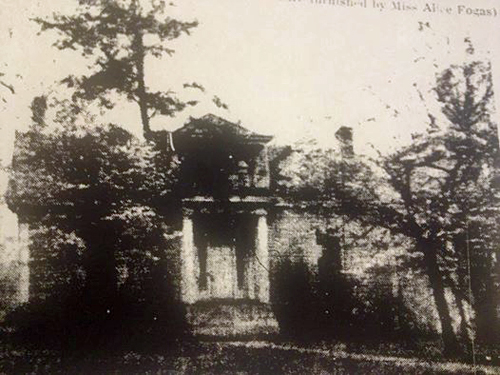
The home was first built by Charles Frederick Leonard who came to Posey about 1834 and was an influential merchant. Married twice, his first wife died of cholera in 1850. His second wife was twenty years his junior and she lived until 1913. The street was once shaded by beautiful elm trees, majestic in size. The house was said to have been high off the ground and on the upper deck had marble steps to the porch. There were two structures in the front yard long ago..."picturesque and octagonal in shape. They had red metal roofs topped with weather vanes." When the house was built there was really nothing else to the north. It had a barn in the back. William Leonard was a son and one of Posey Counties first historians. Frederick Pierce was another son and his widow Ester Harrow Leonard was the last occupant. Frederick was a lawyer, judge, and Republican Mayor of Mt. Vernon.
Former Teacher Writes of the "Good Old Days in Mt. Vernon"....1850's and Beyond
Anna Pruett wrote in the Western Star newspaper of 1921 about some of her earlier memories. She lived in Illinois when she wrote her letter, but she lived as a child not far from the covered bridge of Solitude. She said that on the gables of the bridge was a sign that a fine would be paid if the riding driver drove faster than a walk. She knew it was intended for horses, but Anna was afraid of the dark and imaginary dangers lurking there and always drove as fast as she could. She remembered Black's Grove, west of the L & N depot and how during the Civil War, a Rev. A. Fellows would preach to the soldiers camped there. She grew up with tallow candles for light and remembered the first time she ever saw a coal oil lamp. She attended the school in the little brick building on Main Street and her uncle H. O'Bannon was the teacher for the older students and Miss Lilliston for the younger ones. She recalled the market house with "Dan Rice" painted on it and the Plank Road to New Harmony. The Barter's kept the toll gate there and she played with Victoria and Lizzie Barter up at the big brick house. She would go down to the wharf at the riverfront and knew the wharf master, Wash. Thomas and she was allowed to walk the gang plank. The Flower House was on the riverfront, an old landmark. She attended the old seminary and said it was surrounded by magnificent locust trees and it was here she met her husband, Will Whitaker and received her first teacher's certificate at the age of 16. She recalled an old stage coach line and how the driver perched high on the outside. He would give a shrill call of his bugle whenever he came in and the children would gather to watch those coming and going. She also attended school in the basement of the old M.E. Church when M.D. Gage was the teacher. At the seminary on Main she had R.B. McCann and M.W. Pearse as instructors. At the Female Seminary on Store Street she was taught by Dr. Foster and then at a select school on Water Street she was taught in the home of a minister. She ended her letter with: "Friends are a great blessing, and I have many dear ones, but none are dearer to me than my childhood friends at the dear old town on the Ohio River."
1840's
After "Honest Abe" Spoke, Future Mt. Vernon Judge Takes the Podium....November 1844
Mr. Lincoln, of Springfield, Illinois addressed a large audience in Rockport, Indiana at the court house and spoke on Whig policy. His main argument was in support of the advantages of a protective tariff. Few details in the paper were outlined, except that he addressed all subjects "in plain argumentative whig style that brought honor upon him and his party." When he closed, Mr. John Pitcher arose and delivered a speech in his forcible and powerful manner. "He exhibited the democratic policies in an unenviable light at least we thought so." From here the campaign would be coming to a close and on the following Monday the question of who would be President would be decided, either Henry Clay or James Polk. Indiana voted for the Democrat Polk by a 50.07% to 48.42%. In Posey the margin was far larger.
Alvin P. Hovey and his first wife Mary Ann James taken shortly after their marriage in 1844
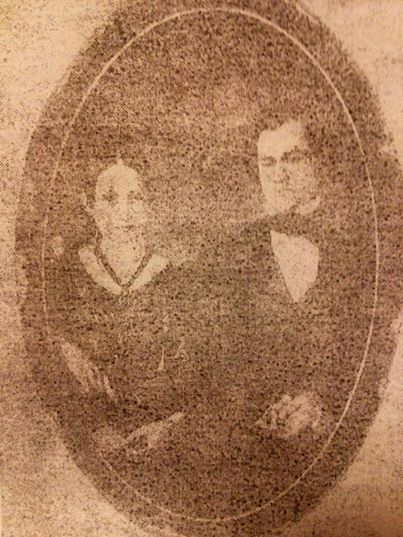
Mary Ann was 19 when she married Alvin and just 38 when she died. This couple had five children but only two reached maturity. Esther who married Maj. G. Menzies and Charles James Hovey. In 1865 Hovey was now 44 and he married the step daughter of Lincoln cabinet official named Caleb Smith. Ross Alice Smith Carey was her name, already a widow. Hovey was sent to Peru as the appointed minister and Ross died on the ship and Alvin swore never to marry again, which he never did. His daughter Esther served as hostess for the minister in Peru and in Indianapolis when he became Governor. It is reported that her wedding dress she wore when she married Major G.V. Menzies was left in the possession of the Historical Society of Evansville. Esther was quit a looker by all indications as was the toast of Lima, Peru. Her inaugural gown was given to the Evansville Museum. It is said that many of the historical artifacts that were given to Mt. Vernon Historical Society disappeared when the Coliseum was robbed in the 1930's and the society disbanded for decades. There was a great clock made of marble and gold that was given to Lilllie Jacques who married Charles James Hovey that was still in the family into the 1940's. I wouldn't know where it would be today; hopefully in ownership of heirs.
Fourth of July in New Harmony.....1841
Citizens formed at 11 a.m. at the Wabash River to parade on the square where they were met by the Marshall, the New Harmony Band, and the Orator of the day. Visitors were greeted by a reading of the Declaration of Independence and then the procession moved from the square down Main to Steam Mill then west to the concert room at #1 House. A public dinner was had at the Mansion House.
Tippecanoe but Not Posey Too......Election of 1840
William Henry Harrison had many Indiana ties and even owned most if not all of what became Mt. Vernon. He bought 371.82 acres of Posey land in 1807. Main Street in Mt. Vernon was once even called Harrison Street. Not very popular here however he had lost the election in Posey County gaining only about a third of the vote vs Democrat Martin Van Buren in 1836. People tried to brand Martin Van Buran as a "dandy' in his first ever bathtub in the White House. They said he drank Champaign, ate schnitzel instead of hog and hominy. He was called a peacock in full costume, strutting in front of golden framed mirrors nine feet high and 5 foot wide. He was called, "Sweet Sandy Whiskers." My wife is said to be related to the great coonskin congressman Davy Crockett by his brother's marriage and he said of Van Buren: "He travels the countryside in an English coach with servants dressed in...livery. He is laced up in corsets and it is impossible to discern from the President's personal appearance, whether he was a man or a woman, but for his large red and gray whiskers." In Mt. Vernon it didn't matter if the President took a warm bath in the palace or a cool dip in the Potomac. By no means were they going to vote for a Whig! All the log cabin float parades in the world, coonskins, and cider barrels by Harrison were not going to persuade them. Robert Dale Owen of New Harmony was ridiculed by the campaign newspaper, the "Log Cabin" because he came to the convention as a Van Buren elector. Horace Greeley, the editor said of him: "Wherever you find a bitter, blasphemous Atheist and enemy of Marriage, Morality and Social Order, there you will be certain to find a voter for Van Buren." Well, when the Posey vote was recorded it was 965 for the Democrat Van Buren and 706 for the Whig Harrison. The Abolitionist party "Liberty" was on the ballot here also but was shutout. Harrison won the Presidency, due largely to the economic scare of 1837 and on a cold rainy day, the oldest man ever elected President until Ronald Reagan rode in an open coach and spoke 8445 words in almost two hours at his inaugural address. He became ill of pneumonia and died....29 days into office. Despite the efforts of his doctors giving him opium, leeches and medical snakeweed, he only became delirious before his death.
The Official Emblem of the Democratic Party is not the Donkey, but a Rooster.... Originating in Indiana in 1840
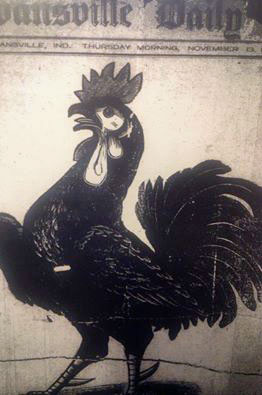
It goes back to a little town in Indiana called Greenfield, which by the way is the birthplace of James Whitcomb Riley. There was one tavern there owned by a Mr. Joseph Chapman and he gave many a thrilling speech it seems for himself and for other Democrats. This tavern owner turned politician spoke very effectively calling himself a "fop in ruffled old shirt" and used that against his "dandy" opposition. Once he was told to set down and quit crowing. Well, he shot back up like a fighting cock and said, "My party has plenty to crow about!" It was not until the 1870's that the donkey and the elephant were used in a magazine called, "Harper's Weekly." The Republican symbol was once the eagle. The Republicans called Andy Jackson a "jackass" so the Dems picked it up, turned it around, embraced it and said...."We are gonna kick your ass!", of which they did. The elephant?....Hmm, I forget, I'm not a Republican.
1830's
New Harmony Disseminator Reports On Slave Trade.....1838
"It is disgraceful to all Christendom that the slave traffic is still continued. No one can conceive the horrors to which it has risen! An appalling take has reached our newspaper office from Jamaica of blacks held aboard a ship being fed body parts of those who died aboard when provisions became scarce. The bodies are brought on deck and prepared as food without the knowledge to the other slaves." Wm. Maclure was editor of the New Harmony Disseminator then and he said of its paper: "The Disseminator is of no party, and as such is treated with indifference, scorn and contempt of all parties." Maclure was a great geologist and he was a great partner to Robert Owen in the social experiment in New Harmony. In Yosemite National Park there is a glacier and a mountain named after him.
Englishman George Page Has Interesting Trip to Mt. Vernon.....1836
George Page was born in England in 1819 and his early life was all at sea it seems. In Norfolk, England he started working at a very young age as an errand boy and he decided he wanted to become a sailor, so he studied navigation when he was twelve. So before he was even thirteen he became a cabin boy, and eventually a seaman. For two years he sailed mostly around England, Scotland and Ireland and finally a voyage up the Mediterranean Sea to Smyrna, Turkey and then headed back to England. The boat ran ashore at Gibraltar, but was soon seaworthy again. From London he made two voyages to St. John (nice place) and wrecked on the second return trip near Liverpool. His third trip across the Atlantic he stayed, giving up ocean life. In December of 1836 he sailed from Liverpool and reached the shores of Newfoundland in thirteen days. He was seventeen years old. Soon afterwards he sailed to New Orleans on the steamer, "Father of Waters" which must have passed Mt. Vernon. On a flatboat he was robbed by what he thought was a friend. Beaten up, he recovered his strength and started up the Mississippi into the Ohio and landed at Mt. Vernon, Indiana. He spent nine years here trying his hand at farming and marrying a young woman by the name of Nancy Jane Altizier, natives of Virginia. Nancy had been born here however in 1824 and when both her parents died they were wed. In 1846 they moved to Wisconsin where George continued farming and became a tax collector. During the early part of the Civil War it seems he was an Army recruiter, but in time the 40 something farmer enlisted himself and marched in Sherman's march to Savannah, now called, "The March to the Sea."
Comes to Mt. Vernon to Sell "Prairie Schooners".....1833
Moses Welborn of North Carolina came to Mt. Vernon in 1833 at the request of Jesse and John Welborn already here. Mt. Vernon it seems had a need for wagons for the settlers, the type ribbed on the sides and high on the front and rear. So here he came and Moses he built a log home at the corner of Walnut and East Fourth Street. This later became the location of the William Fogas home, the future pharmacist. Moses died pretty early leaving a family and a widow. They say he died of cholera in 1851, but some reports say "milksick." Milk sickness is a disease that claimed thousands in the Midwest in the 19th century from ingesting milk, or meat from a cow that fed on white snakeroot which contained a poison. This was the same disease that claimed the life of Nancy Hanks Lincoln, the President's mother.
1820's
The Dissiminator.....February, 1829
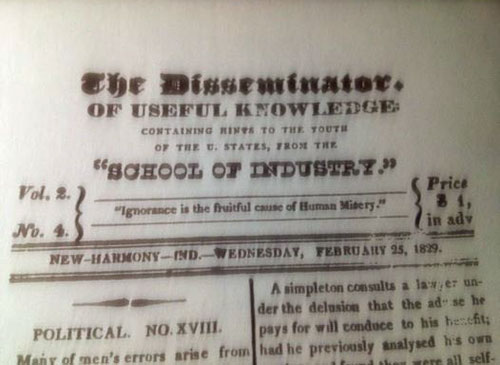
The Banner of "The Disseminator" published in New Harmony.1828-1841. Publishers were some of the "boatload of knowledge" William Maclure, Marie Fretageot, and Thomas Say
Two Great Utopians Travel Together as Commune Collapses.....1827-1828
Robert Dale Owen was the oldest son of Robert Owen. He became one of the leaders of the New Harmony social experiment. With Francis "Fanny" Wright they edited the New Harmony Gazette and the Free Enquirer. Wright was a social reformer and a leader of the free thought movement and lived in New Harmony for a short time learning from Owen. In 1827 Owen kept a diary of a journey he and Wright took to Nashoba, Tennessee then New Orleans, Paris, London and Scotland. The Nashoba experiment was started in 1825 to educate and emancipate slaves on a 2000 acre farm near Memphis, Tennessee. The word Nashoba is a Chickasaw word for wolf. Owen wrote: "there are about 100 acres cleared, two double log cabins one single one for administrators and a Negro dining hall and small cabins for the slaves." Wright believed that through unified labor the slaves could buy back their freedom from the slave holders and then be transported to Liberia and Haiti. She envisioned utopian villages all across America. One other smaller one was tried at Albion, Illinois. Owen said she admired Wright, her principals, her talents, her feelings and valued her friendship. He was somewhat concerned that his trip with her would be construed as sexual by some. "Our trip was an act of friendship and nothing more. I know many (women) to me that are more interesting....her younger sister for instance." In France, with Miss Wright they spent several days visiting General Lafayette. Wright's commune collapsed while returning from Europe. Lafayette had pledged $8000 but she turned him down. Wright invested over $10,000 of her own money in the project. Maybe half dozen white men lived watching the still slaves and rumors of sexual misconduct arose. Without Wright present the slaves were uncooperative and did not trust the white trustees more than any other white man. She came home and took the maybe 20 remaining slaves and emancipated them in Haiti at her own expense.
A Strange Coincidence.....1827
This story goes back to a long ago New Harmony Gazette newspaper of a resident of the community during the time of the Owenites. On a Wednesday of June 20, 1827 thundershowers came and went all morning and a gentleman went home around 2 P.M. and commenced reading history of England. A 3:15, while reading a passage related to when Edward III was on the march there came a piercing wind that swelled into a tempest of rain, lightning and hailstones that it killed 6000 of his horses and 1000 of his best troops, in 1359 A.D. Just then a blinding flash filled his home and a terrific clash of thunder seemed to shake his entire dwelling. The man rose and looking out the east window, as soon as he could recover his senses, saw a dense smoke arising from his barn. He ran out the door and met up in a pouring rain the boys with the engine. At the same time of the big flash, Richard Wilsey was crossing Steam-Mill Street from his house to the factory, when he fell prostrated and rendered almost senseless by the explosion of light and sound.
The Labyrinth of New Harmony as Seen by Minor Kellogg in 1826

Kellogg came with his father to join Robert Owen when he bought out Father Rapp. The labyrinth was composed of a small wooden temple surrounded by tall, intricately placed hedgerows. Rapp is said to mean the labyrinth to be emblematical of his society. The hedgerows represented the difficulty of arriving at harmony. The temple had a rough exterior, indicating that at a distance harmony had no allurements. It was however, beautifully finished within to show the beauty of harmony once attained. (from George Rapp's Harmony Society). Kellogg said: "It was grown in an open field near the town and a source of constant amusement to children. Its lines were formed of vines grown upon light fences and about four feet high, converging as they reached the center. Here the visitor came upon a circular hut made of the ends of rough logs cut to a point externally leaving one window & a blind door which had to be sought out & only found by pushing at the walls."
Sketch of "Boatload of Knowledge" in Mt. Vernon, January 24, 1826
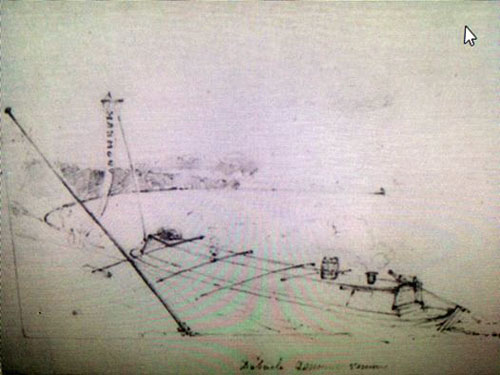
The keelboat banner says "Harmony," but the name of the boat was the "Philanthropist." Charles Alexander Lesueur, was a passenger on the vessel, a French naturalist, zoologist, artist, and teacher. He labeled this drawing, "Debacle at Mount Vernon." The original is in Le Havre, France. The migration of intellectuals included organizers, scientists, educators, artists, musicians, a physician and other notables. The ice was thick at Mt. Vernon and threatened the boat's safety. They were happy to begin their journey inward.
Utopia Failing...Citizens Petition Robert Owen...August 1826
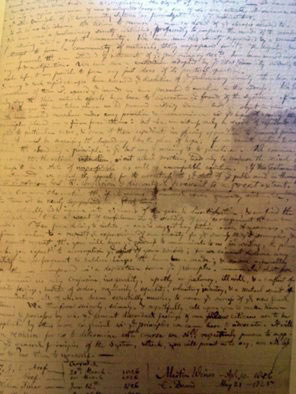
The year old model community wasn't going very well for the inhabitants of New Harmony. Lack of co-operation and lack of a presiding leader didn't help. Just a little over one year in , eleven residents protested the way things were going and requested from Owen what his plans were going forward for the community. One of the critics was the radical Paul Brown, author of "Twelve Months at New Harmony" who was a left winger, a serious communist. Also signing the petition was the educational theorist Joseph Neef and his wife. Another rebel rouser was the first editor of the New Harmony Gazette, William Pelham. They all signed it, "loyal followers of Owen's writings who had become disillusioned." The experimental society was virtually at its end.
Miner Kellogg, 19th Century Artist, Heads to New Harmony Through Mt. Vernon.....Spring of 1824
In 1886, Minor Kellogg of Cincinnati, a boy of about nine, journeyed down the Ohio River with his father to the "promised land," of New Harmony. They came by steamboat reaching Mt. Vernon...." a little village upon the high bank of the river composed of a few straggling frame buildings of maybe a couple hundred residents. Only one hotel and at the landing the trunks were unloaded and they climbed the bank to the inn. The weather was sunny and delightful as they found their accommodations and made preparations for the trip the next day to New Harmony." A messenger was sent ahead to tell Mr. Owen of their approaching arrival. Robert Owen, bareheaded and bald met the party in New Harmony and greeted them with a kiss. He then escorting them to the hotel and a servant took the horse. The town then was almost a ghost town as the followers of Rapp had almost gone except a few to help with the transition of ownership to the Owens. New converts arriving were assigned various homes and put into employment that suited them like farmers, teachers and mechanics. Within a year Karl Bernhard, Duke of Saxe-Weimar-Eisenach visited from Germany and the community was excited for the honor/ Kellogg soon was accompanying Owen in walks, listening to his views for the community. Kellogg, still a young boy was happy when the Duke left a poodle with him he had brought from Germany. His name was Pico, but died of distemper just weeks later. Kellogg mentioned many scholars in the village like Say the naturalist, Maclure the geologist, and Phiqepal D; Arusmont, the husband of Fanny Wright, the writer and abolitionist. Young Kellogg ventured into the woods with Say looking for insects, rare beetles and reptiles. He would carry them home in his straw hat back to the lab. He played in the labyrinth and the circular hut in the center. He learned to swim in the Wabash. He said there was no money, just one store and bartering was the way of transactions. There was no crime according to Miner, thus no police or courts. As time went on things didn't work out and belief in the system waned. The Kelloggs moved on to a new settlement looking for utopia.....in Jeffersonville, Indiana. So in 1827 they headed back to Mt. Vernon, but had to wait several days for a steamer. They piled their luggage at water's edge and kept a large fire burning to stay warm. The river was low at the time and when a steamer did come they had to be ferried out to it before heading north to a new life.
Whig Henry Clay Defeats Democrat Andy Jackson in Posey....1824
I've overlooked this election of 1824, the first true presidential contest in Indiana. Maybe because with all the Democratic wins going into the 20th century I couldn't believe Posey County could ever elect something different back then, but they did, 37.5 % of all Hoosiers went to the polls that year with the national average being 26.5. Actually, the Democrats hadn't formed as a real party yet. Posey sent 414 eligible voters with Clay getting 228, Jackson 173 and a National Republican John Adams 13. Newspapers were few and readers too. Those running for office would be present at auctions, at the county seat on court days, cabin raisings and maybe a log rolling contest or other gala events. Circuit rider ministers sometimes brought in political news as well as keel boats. If there was a good newspaper like the New Harmony Gazette it passed through many hands before being discarded. As a matter of fact, there were only about 14 newspapers in the entire state of Indiana in 1824! Although they were crude, few subscribers, and unsophisticated they had no competition so their significance was enhanced. The issues seemed to be in Indiana...tariffs, internal improvements, the national bank, militarism, slavery and morality. Of course, it would not be much of an American election without mudslinging, lies, negative attacks and name calling would it? Adams was rejected because he was suspected of being a Federalist and sided with the "aristocrats." Indiana wanted something different than the ideas of Adams father. They thought of him as a "fiery, hot-headed, red-mouthed aristocrat." Hoosiers were reminded that when Adams was a senator he was one of six who opposed the Louisiana Purchase. Clay of Kentucky was criticized by being too close to the banks. One editor thought him to be all about wealth and "consolidating the government by destroying state governments." Jackson was portrayed as a man above politics, running only reluctantly. The Vincennes Western Sun endorsed him. Jackson was opposed by his critics of his military record that as a soldier his training and outlook made him unfit to rule. He was said to have opposed suffrage for the poor and that voting should only be for property owners. Quakers in the eastern part of Indiana supported Adams because of their anti-slavery sentiment and said of Adams: "He fights no duels, tells no lies, and drinks very little, if any whiskey." Adams leveled charges at his opponents for immorality for fighting in murderous duels and against Jackson who would "lower the American people in the eyes of foreigners and corrupt the morals of the people at home." Clay was criticized for the Missouri Compromise and described as "plain, old-fashioned slave-holder, one who would use his influence to extend the blessings of slavery to every part of the government." Clay won support in southern Indiana because he was the first to call for state improvements in this area. As a matter of fact Clay won Posey, Vanderburgh, Gibson, Pike, Spencer, Perry and Knox counties in the south. Jackson won Indiana however. John Quincy Adams won the national election decided by the House of Representatives. Adams received only about 32% of the National vote. The election was called the "Corrupt Bargain" as Clay gave his support to Adams and then was selected the Secretary of State. Quid pro quo?
"Shivers Down Backside...Shaking All Over"....William Faux on the Posey County Ague.....1822
Faux the Englishmen seemed to hate just about everything American it seems. I guess losing two straight wars against a bunch of farmers will do that to you. When he came through pioneer Princeton and New Harmony he scorned them badly. He said the Wabash Rivers waters were low and "weeds grew from the bottom, rot and impregnate the air with pestilence." There was a daily occurrence of mosquitoes in swarms! Rank vegetation grew all around the log cabins. People were sick everywhere. The wilderness had no real doctors or store bought medicines. One recipe for curing the ague came from a order from the governor. He said: "Take one third rhubarb and two thirds best Barks, mix them with Brandy or old whiskey until they are about as thin as rich cream. Take a wineglass full 4 or 5 times a day. If it gripes too severely, dilute it with water." In Princeton he wrote: "I am sorry to see very little doing in this town. They cannot all keep stores and taverns! They ought to manufacture something and not spend nine tenths of their time in lolling with a segar in their mouth." Faux said the water in Princeton was bad, white, or milky. ~Wavy just got the feeling that Sir William just didn't like us very much.
A Bear Story.....1818-1820
I found another reference of the Englishmen Faux who traveled in our area during the infancy of the Harmony experience. At one backwoods cabin near the Rappite village of New Harmony, Faux took lodging. He was told a story by the family of a recent incident. The family had a pet black bear that was chained up outside. Somehow the bear broke his chain and entered the home where there laid a bed-ridden man, very ill and an infant child. The bear was interested in the little human and picked it up by its bed clothes and marched out the door with him. The sick man, not knowing he was able to even turn himself over in bed by himself, suddenly acquired supernatural strength, sprung up and running after the cub, rode him down and rescued the child, unhurt. Then he went back to bed.
"When the party is over, turn out the lights, turn out the lights.".....1827
New Harmony in its second utopian experiment was failing. What took the Rappities nine years to disband, took the Owenites only about two. A whimsical humorous utopian made a coffin and labeled it, "The New Social System," and planned on having a mock funeral for the commune. He would have too if not for a more loyal socialist who broke into his barn and destroyed the coffin. Even Robert Owen saw the writing on the wall. He admitted as much defeat in a May 26 and 27th, 1827 editorial in the New Harmony Gazette. He took off to Europe hoping the tension would settle in his Dis-Harmony, but when he returned they had pretty much thrown down the tablets and went their own way. Rapp's followers encouraged celibacy so when God didn't return in their lifetime interest was lost and followers left or died off. New Harmony was only part of the Harmonist movement that lasted close to a hundred years. Equality and Harmonie Pa are other examples. Frederick Rapp was the adopted son of Johann Georg who left Germany and developed his own following in America. Fred was the one in New Harmony and made all the outside decisions for the commune. I don't know if he had children. There have been Rapps in New Harmony over time. I don't know the bloodline. The Owens family have lived in and about New Harmony over time. Although the Owens experiment failed in respect to their continuing existence, it is celebrated for many things like the first kindergarten in America, the first infant school, the first trade school, the first free public school system, the first women's club, the American free library, the first Civic Dramatic Club among others. Owen, a democrat was abolitionist and was a source for Abe Lincoln's Emancipation Proclamation, scholars say. Owen believed in free thought with no pre-established ideas or customs. Robert Owen, a man with a big heart who did not discriminate amongst race or gender if he was a failure...it was a splendid try. The culture of New Harmony and the visitors it attracts makes me glad it was here in Posey County. Jane Owen and USI I thank you for helping us rediscover some of that history. Much still to be learned...failures or success.
1810's
So Let's See if I Understand Origin of Cynthiana.....1817
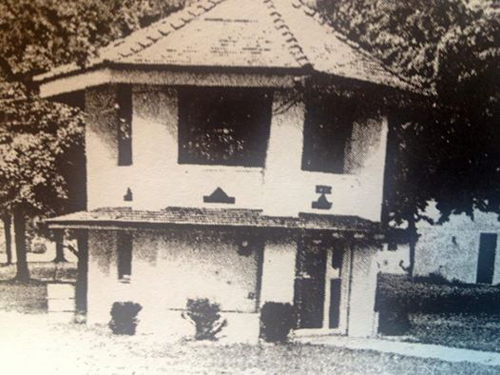
Cynthiana Annas...quite a name for an athletic team isn't it? About as good as Poseyville Posies I reckon. So how did this community get that name? Not totally sure, but maybe I know...just maybe. It seems that in the late 1790's over in Kentucky there was a blacksmith named Robert Harrison. Described as "a good workman, a healthy son of the wilderness." Now Robert had some land and the town wanted to establish a county seat. Robert had some real sweet daughters it was said that were the favorite of all the father's customers. Yes...their names were Cynthia and Anna. Thus, the designation of Cynthiana. Harrison was paid for the ground but dedicated the center for a permanent public square in honor of his girls. So, for whatever reason the early pioneers of Cynthiana, Kentucky became the early pioneers of Cynthiana, Indiana. Well, there was a reason...cholera and 40 or so people left for Indiana around 1815. They got here by floating down the Ohio River in flatboats to a place near West Franklin, and then moved north along the Red Banks Trail. This trail was formed by migrating bison and was used by pioneers through Indiana into Illinois. The new town was named Cynthiana in honor of their old home in Kentucky and was laid out in 1817. The old gazebo sets in the town public square which became a park.
Another Public Square Was Once Planned for Mcfaddin's Bluff....1816
For a time General William Henry Harrison owned the land that the McFaddin's and other pioneer families settled on that became Mt. Vernon. Harrison later sold the land according to information compiled by Anne Doane to Aaron Williams for a horse and some money borrowed from James Black. Williams secured 185 acres for $500 in 1816. John C. Leffel, who wrote "The History of Posey County," said, "In March of 1816, Aaron Williams laid out the present public square and 32 lots south and west of the river. About that time John Wagoner laid out 66 lots and a public square of two acres on the west side of Mill Creek. Williams sold far greater number of lots than Wagoner. "With greater growth in the Williams area the town went with what became our present public square.
James Duckworth Fought in Battle of Tippecanoe....1811
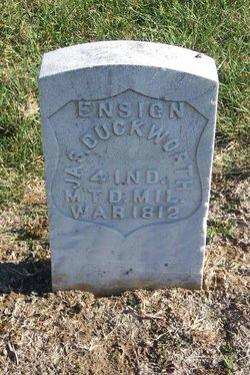
James married Mary Givens in 1810. In the Battle of Tippecanoe he served as ensign to Captain Jacob Warrick. It was said he was left in charge when superior officers were killed. He was commissioned a Major of the Second Battalion, Tenth Regiment of the Indiana Territorial Militia in 1814 and eventually became lieutenant colonel. He sat on the very first Posey County jury in 1815. James was born in 1785 and died in 1835. He is buried at the old Templeton Cemetery on Givens Road.

